3 Volumes
Tourist Trips: Philadelphia and the Quaker Colonies
The states of Pennsylvania, Delaware, and New Jersey all belonged to William Penn the Quaker in one way or another. New Jersey was first, Delaware the last. Penn was the largest private landholder in American history.
Regional Overview: The Sights of the City, Loosely Defined
Philadelphia,defined here as the Quaker region of three formerly Quaker states, contains an astonishing number of interesting places to visit. Three centuries of history leave their marks everywhere. Begin by understanding that William Penn was the largest private landholder in history, and he owned all of it.
Germanic Religious Sects
Refugees from a dissolving Catholic empire fled to America.
Touring Philadelphia's Western Regions
Philadelpia County had two hundred farms in 1950, but is now thickly settled in all directions. Western regions along the Schuylkill are still spread out somewhat; with many historic estates.
Short Tour of Philadelphia's West Country
 Philadelphia County had two hundred farms in 1950 but is now thickly settled in all directions. Western regions along the Schuylkill are still spread out somewhat; with many historic estates. 
|
| Dr. Fisher |
The Art Museum sits on an acropolis called Faire Mount, where William Penn planned to put his home. Fairmount Park, and hence the countryside, begins here and extends on both sides of the Schuylkill. It was once the industrialized terminus of barge traffic, but was restored to parkland as a water purification project in the Nineteenth Century after agitation by the College of Physicians of Philadelphia. The area was briefly a vast Civil War encampment, then the site of the 1876 Centennial, remnants of which remain. Its inner loop including the historic houses in the park is interesting enough to make a tour of its own; on this trip we just skirt the area.
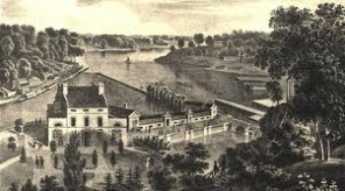
|
| Fairmount Park |
To begin the outer more general tour, go west over any one of the several Schuylkill bridges, turn right on 33rd Street in the general Drexel University/University of Pennsylvania area, observing many ancient mansions of a once-elegant place to live. Go past the Zoo, then up Belmont Avenue through the Centennial Grounds to City Line Avenue. Our first destination is Harriton, the original house in the Welsh Barony, called Bryn Mawr when it was built. Be sure to use a good map to find this large but hidden estate. It was the home of the first Secretary of the Continental Congress and its architecture set the style for the whole Main Line.
From here we carefully follow a map to the Barnes Museum in Merion. After acrimonious debates and clearly against Dr. Barnes' wishes, the vast collection of French Impressionist art is being moved to a new home on the Benjamin Franklin Parkway. Before it goes, you still have a chance to see the original concept in its intended setting.
From here we take a circuitous route to Germantown to see America's first suburb, with the Chew Mansion that cost Washington the battle of Germantown, Grumblethorpe, Stenton, and Schoolhouse Lane. A side trip to Temple University to see some portraiture if there is time, then down the Wissahickon Creek past Rittenhouse Town, eventually down Kelly Drive past the Schuylkill Navy, and over to the Art Museum (or alternatively the Water Works) for a nice lunch.
Albert C. Barnes, M.D.
A private investor has the general goal of accumulating enough wealth so, come what may, there will be a little left when he dies. If he has dependents or heirs, he needs somewhat more. Either way, he is not planning for perpetuity or thinking in astronomical time periods. Albert C. Barnes (1872-1951) had to switch his investment goals, in the 1920s, from investing for a comfortable retirement to investing for a perpetual art foundation. Perpetual.
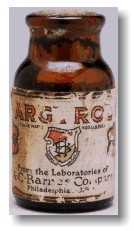
|
| A bottle of Argyrol |
Having graduated from medical school (University of Pennsylvania) in 1902, and then writing a doctoral thesis in chemistry and pharmacology at the Universities of Berlin and Heidelberg, Barnes invented a patent medicine that quickly made him rich. Argyrol was a mildly effective silver-containing antiseptic with the unfortunate tendency to turn its users permanently slate-gray. The advent of antibiotics has since made Argyrol almost sound like quackery, but it was effective enough at the time to require factories in America, Europe, and Australia, and Barnes became immensely rich with it. The American Medical Association strongly disapproves of physicians who patent remedies, so Barnes was never held in high regard by his colleagues; but it could well be argued that he had as much training as a chemist as a physician, and spent his entire professional life as a chemist, manufacturer, and investor.
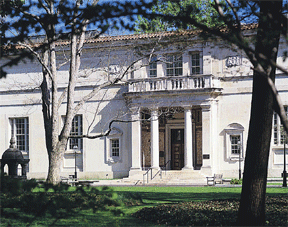
|
| The Barnes Gallery |
Barnes was eccentric, all right, but on Wall Street, the saying goes, "What everyone knows, isn't worth knowing." Guided by that principle, in 1929 he sold his company at the very peak of market euphoria, getting out of common stocks at the top of the market. It is small wonder that he soon instructed his Foundation to invest its endowment entirely in bonds. During the 1930s, commodities were extremely cheap because no one had any money. Barnes, of course, had a potful of money and bought hundreds, even thousands, of artworks very cheaply. He also bought 137 acres of Chester County, PA, real estate, and a 12-acre arboretum in Merion Township on the Main Line. Although he is famous for acquiring hundreds of French Impressionist paintings with the advice of Gertrude Stein and her brother Leo, he also bought great quantities of Greek and Roman classical art, African art, and the art of the Pennsylvania German community. He picked up a notable collection of metallic art objects. Most of these "losers" are down in the basement because he had so many Renoirs, Matisse, and Picasso (some of them may be worth $200 million apiece) that the upstairs galleries were pretty well stuffed with them. Viewed from the perspective of an investor with a goal of perpetuity, of course, the things in the basement just happen to be temporarily out of fashion, just like those bonds in the portfolio.
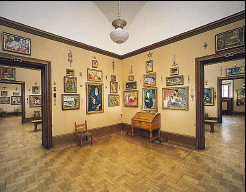
|
| A view inside the Barnes gallery |
Since the Foundation is currently strapped for ready cash, Judge Stanley Ott of the Montgomery County Orphans Court is now being urged to allow the Foundation to break Barnes' will in some way or other. Move the museum to downtown Philadelphia where it can attract more paying visitors. Sell some of that land. Sell some of those paintings in the cellar. Fire some of those employees. But all of these suggestions are short-term solutions, which may injure the long term. Everybody has an idea of what Barnes the rich eccentric would have done if he were alive to do it, but I suspect he would have rejected the whole lot. Barnes the shrewd investor would have taken the most expensive painting off the wall, and sold it to the highest bidder. Buy low, sell high, and the niceties of non-profit professionals are damned. Barnes wasn't in love with one single painting, or one particular school of painterly interpretation, he was in love with Art.
Investment theory has improved in the past fifty years; there have even been some Nobel prizes awarded for new insights. But it still isn't possible to put an investment portfolio on autopilot for perpetuity. Every museum, university, and the foundation has the same problem, with the result that the landscape is littered with the bones of perpetual organizations destroyed by following a fixed formula. With the singular success that Barnes displayed, it isn't surprising that he went a little too far with instructing his successor trustees in what to invest in. Never sell the paintings or the real estate, avoid the common stock, were ideas that worked brilliantly, and may even work most of the time. But sooner or later, the institution will be endangered by following them too literally. Somebody has to have some flexibility. But there is something else that is inevitable, too. Sooner or later, whether it takes fifty years or five hundred years, sooner or later someone will be given the responsibility and the necessary flexibility -- but will try to run off with the boodle, for himself. The balance between necessary prudence and necessary flexibility is impossible to maintain forever, and the Judge will surely have a hard time deciding what Barnes would have decided.
Benjamin Franklin Parkway (2)
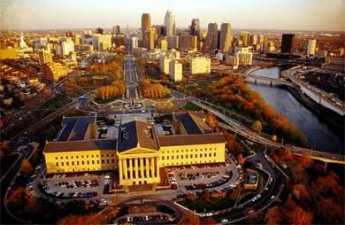
|
| Art Museum |
There are a number of residential relics along the Parkway, but in general the idea seems to have been to put governmental buildings there, in a sort of French-like celebration of governmental glory. There is the Youth Study Center, the Department of Education administration building, the Boy Scouts of America, the Cathedral of St. Peter and St. Paul, and of course the tower of City Hall at one end and the Parthenon-like Art Museum at the other. But this is Philadelphia, and certain small touches of the town are tucked among the European grandee design.
For example, WFLN (now WWFM) the original FM classical music station, had its studio tucked in a little building just behind the Cathedral. Ralph Collier would interview authors and city visitors there during the lunch hour, in a studio that was little more than a closet, while someone else changed records in a room downstairs. Somebody from New York once said that Ralph didn't seem to know how good he really was, which is a way New Yorkers like to talk. Ralph was, the just about the only interviewer who had actually read your book before the interview. In 1997, WFLN was sold for forty million dollars, which ought to impress even a New Yorker.
Logan Circle is bigger than it looks, primarily because the windows are set 100 feet high. This came about after the anti-catholic riots of the Civil War era, which made it advisable to put stained glass higher than most people can throw rocks. There is usually a cardinal in residence at this cathedral, and Cardinal Bevilacqua the much-respected lawyer-cardinal is now just retiring in favor of an incoming occupant from St. Louis. Cardinal Krol was famous in the past for his opposition to Pope John's Vatican Constitution, which he refused to allow to be translated into English. Before that, was Cardinal Dougherty, who is remembered for being considerably overweight. Cardinals are addressed as Your Eminence, and Cardinal Dougherty was (very privately) referred to as You're Immense. He was perhaps most famous for the Legion of Decency , an effort to make motion pictures more socially acceptable. The story is told of a 12-year-old girl who stood up and told the Cardinal that she didn't agree with him, she liked movies. The next day, her father, the most powerful Catholic banker in Philadelphia, had to go to the Cardinal and humble himself to make amends.
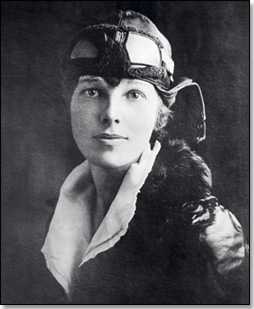
|
| Amelia Earhart |
Franklin Institute was originally on 7th Street, where the Atwater Kent Museum of Philadelphia History is now located. Much of the money to build it came from a $5000 bequest from Franklin himself, which was intended to demonstrate the power of compound interest over a period of time. It is part science museum, part memorial to Philadelphia's most famous citizen. It has a Planetarium, locomotive, a passenger airplane, Amelia Earhart's plane, a huge replica of a human heart, and thousands of working demonstrations of electrical phenomena. Ben Franklin's huge statue sits in a grand marble rotunda, where socialites occasionally hold receptions and weddings. But between the two extremes is the most interesting combination of museum and memorial -- a series of demonstrations of Franklin's most important scientific discoveries, utilizing the same instruments he used. Just a little effort at understanding these exhibits will convince any educated adult that Franklin was truly a genius.
Almost next door to the Franklin Institute is its more venerable neighbor, the Academy of Natural Sciences. The Academy is an offshoot of the American Philosophical Society, itself (originally founded by Franklin) and has a distinguished history of discovery and research of its own making, not merely a display of the work of others. Most school children will recognize the famous display of dinosaurs, including the First Dinosaur ever unearthed intact (in Haddonfield).
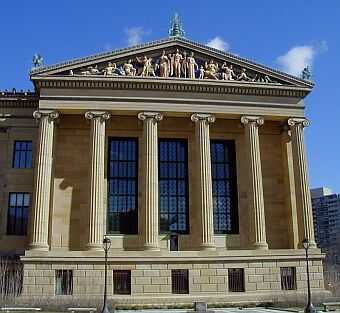
|
| Art Museum |
The Art Museum was intended to inspire awe, and it does. The builders ran out of money before the decorative friezes could be completed, but that even enhances its resemblance to the Parthenon, where the friezes were blown off in various wars. It's a little hard to know how to respond to the criticism that the building overwhelms its contents. Perhaps it is true that the creaking floorboards in Madrid's Prado Museum show off the treasures on its walls, but there is also little doubt that Spain (or Boston) would replace the floors if it could afford to. Although the City of Philadelphia has a little trouble finding the money to maintain and guard the Museum, the masonry is ultra-solid, it's very big, and will endure for ages to come. The collections slowly grow, benefaction by benefaction. The traveling exhibits are clearly the center of Philadelphia culture. And there, at the top of the stairs without any clothes on, is Diana of fame and fable. Her perfectly straight back is the true essence of the famously beautiful Philadelphia woman, like Fannie Kemble, Rebecca Gratz, Evelyn Nesbitt,Cornelia Otis Skinner, Grace Kelly, and Katherine Hepburn.
Bertrand Russell Disturbs the Barnes Foundation Neighbors
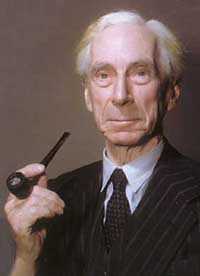
|
| Russell |
In 1940, the Barnes Foundation disturbed its Philadelphia's Main Line neighborhood in a way that had nothing to do with art. Dr. Barnes was still alive and running the place at that time so there can be no question about the testamentary intentions of the donor. He hired Bertrand Russell for a five-year contract to teach philosophy at the Foundation, under highly lurid circumstances. By doing so, he put his thumb in the eye of religions generally but especially the Roman Catholic Church, into the eye of the Main Line neighborhood that prized its privacy, and into the eye of the judiciary, although the judiciary found a way to get back at him.
 Do not fear to be eccentric in opinion, for every opinion now accepted was once eccentric. 
|
| Bertrand Russell |
Under the circumstances, hiring anyone at all would have been socially defiant, but Barnes went out of his way to offer a position to a man who was already internationally famous for sticking his own thumb in everybody's eye.
Lord Bertrand Russell was the third Earl, the son of a Viscount and the grandson of a British prime minister. He had such a brilliant mathematical mind that no less an observer than Alfred North Whitehead regarded him as the smartest man he ever met. He burned up the academic track at Trinity College, Cambridge, and was made a Fellow of the Royal Society at an early age. There was absolutely no one in the academic world who could look down on him, particularly no one in any American community college. His association with Haverford Quakers was established by marrying Alys Pearsall Smith, a rich thee-and-thou Quakeress then living in England, whose brother was the famous author Logan Pearsall Smith. Many early letters of Bertrand Russell contain instances of what the Quakers call "plain" speech.
 If a man is offered a fact which goes against his instincts, he will scrutinize it closely, and unless the evidence is overwhelming, he will refuse to believe it. If, on the other hand, he is offered something which affords a reason for acting in accordance to his instincts, he will accept it even on the slightest evidence. 
|
| Bertrand Russell |
By the time of World War I, this odd mixture of Quaker pacifism and English aristocratic arrogance seems to have unhinged Russell from social moorings, and he began a lifelong career of defiance mixed with a rapier wit that made just about everybody his enemy. He went to jail for pacifism, got divorced three or four times, openly slept with the wives of famous people like T.S. Eliot, and proclaimed that monogamy was not a natural state for anybody. He wrote ninety books, and his denunciation of religion was sweeping. All religious ideas were, in his view, not only false but harmful. Accordingly, everybody in polite society kicked him out, and although he was entitled to a seat in the House of Lords, by 1939 he was nearly impoverished. In desperation, he went to (ugh) America to seek his fortune. He didn't last at the University of Chicago, and even California eased him out. Finally, he was reduced, if you can imagine, to accepting an offer to teach Philosophy at the City College of New York. That proved to be totally unacceptable to Bishop Manning, who led a public outcry against using public funds to support such a radical, known to have held long conversations with Lenin. When a CCNY student was induced to file suit along those lines, an especially hard-nosed judge overturned the College appointment, with the rather gratuitous declaration that Russell's appointment would establish a Chair of Indecency. At that point, Albert Barnes stepped in and offered Russell a five-year contract to teach philosophy at the Barnes Foundation on Philadelphia's main line.
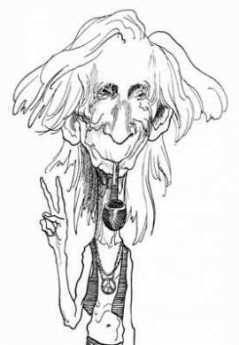
|
| Bertrand Russell in 1960s regalia. |
Bertrand Russell the bomb-thrower accepted the offer and came down to that quiet little lane where the neighbors object to the traffic coming to look at pictures. The five-year contract only lasted three years, when even Barnes got fed up, and summarily dismissed him. The circumstances have not been extensively documented, but they were sufficient to enable Russell to win a lawsuit for a redress of grievances. During that three year period on the Main Line, he had produced a book called History of Western Philosophy, which became a best seller and permanently relieved his financial difficulties, and was the basis for his winning the Nobel Prize in Literature. He spent the rest of his ninety-odd years leading demonstrations against the atom bomb, the Vietnam War, monogamy, religion and so on. There are those who regard Bertrand Russell as the role model for the whole Sixties generation, and, unfairly, the 2004 Democrat candidate for President. However, all that may be, his activity at the Barnes Foundation undoubtedly was a factor in the firm but the unspoken tradition of the Merion Township neighbors that they wanted to get that Art Gallery out of here.
Contemporary Germantown
The Strittmatter Award is the most prestigious honor given by the Philadelphia County Medical Society and is named after a famous and revered physician who was President of the society in the 1920s. There is usually a dinner given before the award ceremony, where all of the prior recipients of the award show up to welcome to this year's new honoree.
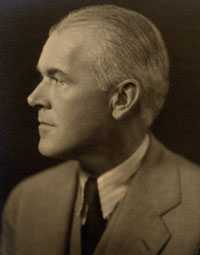
|
| Bockus |
This is the reason that Henry Bockus and Jonathan Rhoads were sitting at the same table, some time around 1975. Bockus had written a famous multi-volume textbook of gastroenterology which had an unusually long run because it was published before World War II and had no competition during the War or for several years afterward; to a generation of physicians, his name was almost synonymous with gastroenterology. In addition, he was a gifted speaker, quite capable of keeping an audience on the edge of their chairs, even though after the speech it might be difficult to recall just what he had said. On this particular evening, the silver-haired oracle might have been just a wee bit tipsy.
Jonathan Rhoads had likewise written a textbook, about Surgery, and had similarly been president of dozens of national and international surgical societies. He devised a technique of feeding patients intravenously which has been the standard for many decades, and in his spare time had been a member of the Philadelphia School Board, a dominant trustee of Bryn Mawr and Haverford Colleges, and the provost of the University of Pennsylvania. Not the medical school, the whole university, and is said to have been one of the best provosts of the University of Pennsylvania ever had. When he was President of the American Philosophical Society, he engineered its endowment from three million to ten times that amount. For all these accomplishments, he was a man of few words, unusual courtesy -- and a huge appetite in keeping with his rather huge farmboy physical stature. On the evening in question, he was busy shoveling food.
"Hey, Rhoads, wherrseriland?". Jonathan's eyes rose to the questioner, but he kept his head bowed over his plate.
"HeyRhoads, Westland?" The surgeon put down his fork and asked, "What are you talking about?"
"Well," said Bockus, "Every famous surgeon I know, has a house on an island, somewhere. Where's your island?
"Germantown," replied Rhoads, and returned attention to his dinner.
Donor Intent
At least three of the greatest treasures of Philadelphia are now used in ways that almost certainly flout the expressed wishes of the donor. Steven Girard's
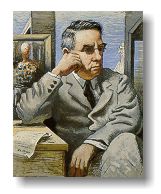
|
| Alfred Barnes |
bequest for the enhancement of "poor, white, orphan boys" is now devoted mostly to black children, many of the girls, many of them non-poor by some definitions, and many of them orphans only in a limited sense. Alfred Barnes wanted his art treasures to be used for education, outside the city of Philadelphia which had offended him, and definitely not part of the Philadelphia Museum of Art which he disliked. They are now to be moved to Philadelphia's Parkway, close to and under the thumb of, the Philadelphia Museum of Art. John G. Johnson's immense art collection now resides within the Museum of Art in spite of the firm declaration by this eminent lawyer that it was to remain in his house, and definitely not to be used to promote some huge barn of a museum.
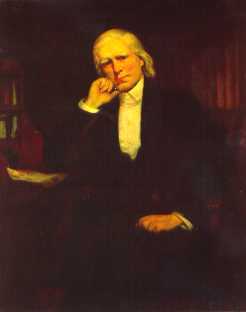
|
| William J Duane |
It's hard to imagine how any set of instructions could be devised to be more clear than these. Barnes employed a future Supreme Court Justice, Owen Roberts, to write his will. Girard similarly employed the preeminent counsel of his time, William J. Duane, to devise an extraordinarily detailed set of instructions. John G. Johnson was himself considered to be the most eminent lawyer in the city. In fact, he once received a fee of $50,000 for his opinion about a corporate financial plan, consisting of the single word "No" scrawled on its cover.
It would be interesting to know whether these famous cases are typical of the way wills are treated, either in this city or in the nation generally. Perhaps they are notorious mainly because they are so unusual. But perhaps they are indeed rather representative and stand as lurid examples of the general failure of the rule of law. Perhaps they reflect some deeper wisdom of the law, where Oliver Holmes intoned that the standard was not logic, but experience.
<Perhaps some guidance can be found in the decisions of Lewis van Dusen, Sr. who for several decades established the Orphans Court of Philadelphia as a model for the world to follow. Someone seems to have thought he set a good example. But was his reign an exception, or a glowing example of the triumph of society's wisdom over the crabbed grievances of dying millionaires in their dotage?
These remarks are made while the newspapers are filled with the story of a Texas billionaire who married a magazine model fifty years younger than himself. Some prominent local heiresses are known to have run off with their stable boys. Indeed, you don't need to read many tabloids to see a dozen examples of such behavior. Is it possible that some of them were acting up out of frustration at the probable betrayal by the courts of more reasoned instructions for their wealth?
East Falls
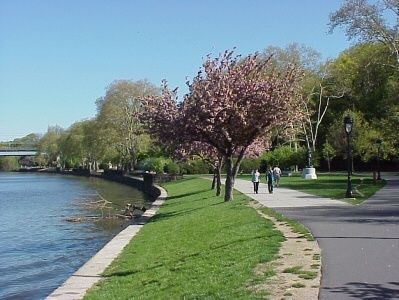
|
| Kelly drive |
The views along the charming, curving, leafy East River Drive from the Art Museum to the (former) Falls of the Schuylkill are dominated by rowing and the rowing clubs, so it isn't surprising that Philadelphia's most famous oarsman, John B. Kelly, used to live in East Falls, the residential area just at the end of the rowing area. I was once sent to see him by a mutual acquaintance when we were considering buying a house in his neighborhood. "East Falls," he said, will remain a nice place as long as I am alive but not longer than that." He might have added the names of Connie Mack(Cornelius McGillicuddy) the fifty-year owner and manager of the Philadelphia Athletics who lived on Schoolhouse Lane, and Harry Robinhold, who lived on Warden Drive and was the only real estate agent who ever seemed to have properties available in the area. But the friendly warning that Kelly was intoning seemed quite plausible, and we didn't buy the house.

|
| Roosevelt Blvd. |
There seems to be no question that Frank Sinatra and Ava Gardner were married in Philadelphia in November 1951 and that Jimmy Duffy did the catering. It's only hearsay, strongly asserted, that the wedding took place in a big white house at the corner of School House Lane and Henry Avenue. That would, I believe, be the house where Connie Mack the baseball team owner and manager, lived. Just what connection these movie stars had with Connie, or with Grace Kelly who lived a block away, is undocumented but strongly suggested.
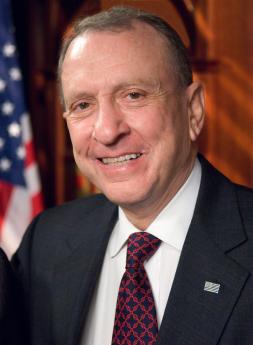
|
| Arlen Specter |
Decades later, however, East Falls continues to be a curious little cluster of three thousand houses, very close to the center of town but leafy and suburban, surrounded by other neighborhoods which underwent serious urban decay long ago. The Wissahickon Valley on one side,Roosevelt Expressway on a second, and the Schuylkill River on a third give it physical isolation, and the brow of the hill is held apart from West Germantown by a couple of large schools and college campuses. Even the strip of small commercial businesses along East River Drive serves to discourage random wanderers. But that's just as true further East along the comparable strip near the Delaware, where it doesn't have the same result.
More likely, the fact that so many judges and politicians live there (the list includes Mayor Governor Rendell and Senator Specter) guarantees police protection of a high order, and probably also makes inconvenient government construction, or regulation, highly unlikely. The local school is good, the local private schools are even better. If you are ever seeking to improve local residential amenities (and real estate values), you ought to study what it is that enhances East Falls, and quietly act on your discoveries.
East Park Jingle
T he Paoli Local makes so many stops from 69th Street to Paoli, and those suburban stops look so much alike, that a dozing passenger can suddenly realize that he doesn't know whether he's gone past his intended stop or not. The conductor may shout out the station, but is it before, or after? To help with this problem, some wag composed a little jingle --"69 Old Maids Never Wed And Have Babies", which helps remember 69th street, Overbrook, Merion, Narberth, Wynnewood, Ardmore, Haverford, Bryn Mawr. There's more to the jingle for further stops, but it gets a little raunchy. And anyway, Bryn Mawr students get off at The College, so further stations are safely ignored.
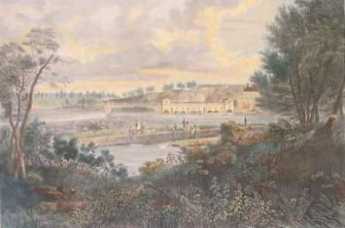
|
| Fairmount Park |
In view of the success of the Main Line jingle, it is tempting to compose small doggerel to assist remembering the forty or so points of interest in Fairmount Park. The old Park Trolley line stopped running in 1946, so we must look further for a logical modern sequence. Marion W. Rivinus has provided an ideal model in her charming little book "Lights Along the Schuylkill", now unfortunately out of print. The charming book contains a succession of sketches and comments about the houses and history of Fairmount Park. The book kindly begins and ends with a map of the park, the locations all numbered, in a sequence which is a perfectly acceptable guide to a complete tour by today's roads. There are a dozen acceptable ways you might wander around the Park, but to see everything would take a week and so for anyone to follow Mrs. Rivinus' tour precisely is improbable anyway. Nevertheless, her numbered sequence, without ever saying so, is the suggested itinerary of someone who knows and loves the park better than anyone. Since several members of her family were members of the original Park Commission, she comes by it all by inheritance, She's very small, and very sprightly, quickly dominates any group who are visiting one of the Park Houses for a party, and has lots and lots to say. She surely will not be offended to have it generalized that her age is North of 80; if she wants to adjust that statistic further, you will have to ask her. Philadelphia really needs to have her book republished.
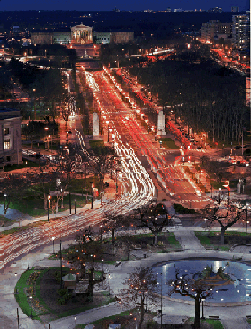
|
| Benjamin Franklin |
So, begin at the Art Museum with the portion of the park which is on the East side of the Schuylkill. The jingle we offer begins "An Eager Walker Brings Hot Chocolate" (Art Museum, Eakins Oval, Water Works, Boat House Row, Lemon Hill, Cliffs) for the visible and famous anchor of the Park, the culmination of the rather grand promenade of the Benjamin Franklin Parkway. Notice first the general lay of the land.

|
| City Hall |
The motorist driving West from City Hall starts to weave through traffic and then starts to careen around curves of the East River Drive, now called Kelly Drive. Absorbed in the intricacies of urban driving, the motorist often fails to look up to the right and notice that he is really driving past the end of an elevated plateau. The cliff end rises sharply enough that the modern commuter often does not realize how short a distance to the right it is to quite another world. The river makes two right-angle turns, with a large lake or reservoir along the top of the first point. The East Park Reservoir covers about twenty-five square blocks of land, with colonial-era houses along the river rim, and the very dense urban area stretching off on the other side of the reservoir. The western edge of the forty-five acres of Girard College comes pretty closes to the edge of the park. If you drive from the edge of the cliff overlooking the Schuylkill, around the reservoir, and then down the side wall of Girard College, it is quite a shock to go from 18th Century mansions, woods, and pastures suddenly into what cannot honestly be called anything but a slum. A huge teeming slum, that seems to stretch on, forever. But back at Laurel Hill on the western edge, you walk a few steps from the road to the front door; if you walk straight through to the back porch, it is only fifteen steps from a spectacular view of the wooded river valley, and the edge of a very steep cliff. Although the Randolph family lived here and gave it the current name, Laurel Hill was the country seat of the Rawle family, which also graces the name of the oldest law firm in the country.
The southern end of this central north-south ridge of Philadelphia is now called Lemon Hill. It was the site of William Penn's intended manor house, until he later relocated to Pennsbury, up near Trenton. In time 300 acres of the area became -- by way of Tench Francis -- the country home of Robert Morris, probably the richest man in America and masterful financier of the Revolution. There is little question The Hill became the most glamorous social center in America, with George Washington staying overnight many times, and Martha Washington becoming a firm fast friend of Robert Morris' wife Molly White Morris, sister of William White, first Episcopal Bishop in America. It's true there were real lemon trees on The Hills, also true the estate was sold at sheriff's sale when Morris got thrown into debtor's prison for three years. The cause of his financial collapse was not the Revolutionary War, but overzealous speculation in real estate in the District of Columbia when it was decided (against his loud objections) to move the Nation's capital to the swamps of the Potomac. Morris was a great patriot for his country and his city, but he was also a bold and reckless speculator. Eventually, it caught up with him. Since the loss of the Capital was the greatest defeat Philadelphia ever experienced, it could easily be supposed the judges of his bankruptcy were unsympathetic with his attempt to profit from the deal.
There is only a thin shelf of land, scarcely wide enough for the East River Drive, at the foot of the cliff from the Water Works to the Wissahickon Creek, so most of the interesting houses are up at the top of the ridge. It is all a driver can do to stay on the twisting road and notice Boat House Row, with skulls on the river, without looking up to the right to see what's interesting. Many of the houses, like Woodford of William Coleman (Ben Franklin's lawyer). Laurel Hill of Francis Rawle, Mount Pleasant that was almost sold to Benedict Arnold, the Thompson family's federalist mansion called Rockford, and Charles Thompson's Somerton, later acquired by Judge William Lewis and now called Strawberry Mansion, were homes of prominent leaders of the American Revolution. Other houses in the neighborhood belonged to Tories. The Franks of Woodford almost became Arnold's neighbors while David Franks was smuggling letters to Major Andre, Joseph Galloway was Provost Marshall of Philadelphia during the British occupation, so his home, Ormiston, was confiscated when he left town along with General Howe. Two houses were moved to the premises, sort of destroying the dream of the preservationists to have it just the way it once was. Although Hatfield House was built in 1760, it was originally on Hunting Park Avenue and moved, stone by stone, to Fairmount Park in 1930 at the expense of the Hatfield family. And finally, Grant's Cabin. It's really pretty interesting to see the two-room cabin where General and Mrs. Grant lived for five months, overlooking the James River while Grant was concluding his campaign that led to surrender at Appomattox, issuing orders to Sherman and Sheridan, and receiving the visits of Lincoln, Meade and the Confederate Commissioners suing for peace. It's highly interesting to have Grant's headquarters displayed in our park, but, well, it seems a little out of place if you know what place you are visiting.
Let's extend our little doggerel. It begins with "An Eager Walker Brings Hot Chocolate;" and goes on "Most real Olympic runners won't stop." That's Mount Pleasant, Rockland, Ormiston, Randolph, Woodford, and Strawberry Mansion.
Encampment At East Falls
The urban intersection at Queen Lane and Fox Avenue in East Falls is a busy one, and except for a few stately residences, it easily escapes notice by commuters. However, the landscape forms a bowl atop a steep hill, fairly near the Schuylkill River. George Washington had evidently picked it out as a strong military position near the Capital at Philadelphia, either to defend the city or from which to attack it, as circumstances might dictate.
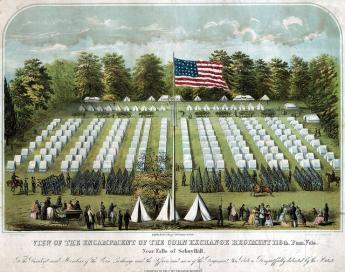
|
| Encampment at East Falls |
Washington's plans and thought processes are not precisely recorded, but when Lord Howe had sailed south from the Staten Island- New Brunswick area, he ordered his troops to head for an East Falls encampment at the southern edge of Germantown. Crossing the Delaware River at Coryell's Ferry (New Hope), the troops marched inland a few miles and then down the Old York Road to this encampment. Their stay at the beginning of August 1777 was quite brief because Washington changed his mind. When it took Howe's fleet longer than expected to appear in the Chesapeake, Washington became uneasy that Howe might be conducting a feint designed to draw the Continental troops south, and after cruising around the coast, might still return to attack down the undefended New Jersey corridor from Perth Amboy to Trenton. That proved wrong, but in Washington's defense, it must be said it was a plan that had actually been considered by the British. Anyway, Washington ordered his troops to pull out of the East Falls encampment and march back up Old York Road to Coryell's Crossing, which would be a more central place to keep his options open for the time when Howe's true intentions became clear. Washington and his headquarters staff went on ahead of the main body of troops, setting up headquarters at John Moland's House a little beyond Hatboro and a few miles west of Newtown, Buck's County. The Hatboro area was a pocket of Scotch-Irish settlement, without any local Tory sentiment, thus preferable to the rest of largely Quaker Buck's County.
To jump ahead chronologically, the East Falls encampment site must have seemed agreeable to the Continental Army, because a few weeks later it would be sought out as the main refuge and regrouping area, following the defeat at the Battle of Brandywine. The American troops were to withdraw from the Brandywine Creek when Washington realized he had been out-flanked, and head for Chester. Quickly recognizing that Chester was vulnerable, they headed for East Falls. Not only was Washington preparing to defend Philadelphia at that point, but was using the Schuylkill River as a defense barrier. As he had earlier done at the Battle of Trenton, he ordered all boats removed from the riverbanks, and artillery placed at any likely fording places, all the way up the Schuylkill to Norristown. Having accomplished that, this extraordinary guerrilla fighter then moved his troops from Germantown up the river to defend the fords. Meanwhile, Congress decided to move to the town of York on the Susquehanna, just in case.
Fairmount Park Historic Preservation Trust
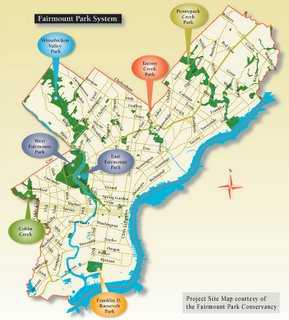
|
| Philadelphia's Fairmount Park |
New York's Central Park was created when it became clear there would be no park unless it was deliberately planned and its boundaries vigorously defended against real estate developers. Philadelphia's Fairmount Park, on the other hand, was to some degree a slum clearance project. The swift waters of the Wissahickon provide excellent power sources, provoking the construction of many mills. With steam power, they were abandoned, leaving desolate industrial hulks that blotted the landscape. Fairmount Park cleared out the remains of deserted mills, which had moved upriver to Manayunk, closer to a supply of coal. Fairmount Park was a creation of the Pennsylvania State Legislature, but the State never funded it. And it has thus always been somewhat larger than the City could afford.
In the early 1990s a beleaguered City government reached a public/private accord as a result of a commissioned study of the matter, which essentially urged that the city government should run the recreational programs in the parking area, and the private sector should be asked to do its best with land and historic building preservation. The William Penn Foundation, the Pew Charitable Trusts, and other philanthropic organizations banded together to form the Fairmount Park Historic Preservation Trust. Among its functions was to coordinate the many organizations which had been formed to preserve small areas of the park, as a result of the concerns of neighborhoods or descendants of former owners of historic homes. The Fairmount Park Trust finds itself in charge of over 400 houses, of which about 250 are genuine of historic value. They have to be preserved against vandalism and vagrants, mainly they have to be preserved against decay. Someone has to use them, and for that, someone has to spend money to fix them up and maintain them. If that is to happen, someone else has to set standards for preservation that balance the historic values with the need for some kind of present usage. Since few people would be willing to spend money and put up with uneconomical regulations if the building belongs to the park, the management of the Trust must manage and oversee very long-term leases. Obviously, the Trust must know what it is doing, have the wisdom to be innovative, and endure a fair amount of harangue by disappointed developers.
And it must supply some things which are hard to find, like advice and know-how about fixing up historic buildings of a certain age and history. The Trust has actually gone into the business of doing historic preservation for a fee, on its own property and elsewhere (Christ Church burial ground is an example). It thus generates some income to supplement philanthropic contributions. There is no requirement that prospective tenants must be non profit, only that the entity be of value to the neighborhood, and there are other signs that the Trust intends to be far-sighted and imaginative in the goal of making the Park something to be proud of, from the nearest to the farthest corner.
One idea suggested for further coordinated action might be to search for types of underbrush which would be repellent to deer who destroy the forest understory. Or, to search for particularly tasty "bait" shrubs which would draw the deer away from areas needing preservation. The combination of both ideas might lead to a natural balance, which would be unlikely to come about by the action of small local preservationists. Meanwhile, there are too many deer, and someone has to decide how and when to "cull the herd". That's how, in a small way, the trust got into the venison business.
So far, the Trust has preserved about 25 houses in the past ten years. That's a marvelous achievement, but it will take a century to complete the whole park unless momentum picks up. The Trust sort of needs an impresario of some kind or other to stir up public support.
Germantown After 1730
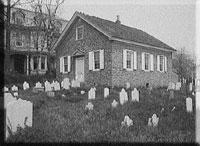
|
| German Quaker Home |
The early settlers of Germantown were Dutch or German-speaking Quakers. They were proud of the craftsman class but, unfortunately, that made them rather poor subsistence farmers. With a whole continent stretching beyond them, professional farmers would not likely choose to settle on a stony hilltop, two hours away from Philadelphia. Germantown's future lay in religious congregation, in papermaking, textile manufacture, publishing, printing and newspapers. Plenty of stones were lying around, so stone houses soon replaced the early wooden ones. Since Philadelphia in 1776 had only twenty or so thousand inhabitants, and only thirty wheeled vehicles other than wagons, it was not too difficult for Germantown to imagine it might eventually eclipse that nearby seaport full of Englishmen. Two wars and two epidemics brought those Germantown dreams to an end, but in a sense, those calamities were stimulants to the town, as well.
In 1730 real German peasants began to arrive in large numbers from the Palatinate section of the Rhine Valley. They arrived as survivors of a horrendous ocean sailing experience, packed in such density that it was not unusual to find dead bodies in the hold, of passengers that had only been supposed to have wandered into a different part of the ship. Quite often, they paid for their passage by selling themselves into what amounted to limited-time slavery, and a customary pattern was for parents to sell an adolescent child into slavery for eight or ten years in order to pay for the voyage of the family. They were uneducated, even ignorant, and often were proponents of small new religious sects. All of that made them seem to be a primitive tribe in the eyes of the earlier settlers. But they were professional farmers, and good at it. They knew, and a quick tour of Lancaster County today confirms their belief, that if you had a reasonable amount of very good land, you could live a life that approached that of the craftsmen in comfort, and usually far exceeded them in personal assets. They have therefore taken a long time to rise from farm to sophistication, while the already sophisticated craftsmen in Germantown wasted no time in abandoning farming. The peasant newcomers arrived in Philadelphia, made their way to nearby Germantown, learned a little about the new country and the refinements of their Protestant culture -- and then pressed on to the great fertile valley to the West, where the way had been paved by those twenty-five German families who had landed on the Hudson River several decades earlier and come down the Susquehanna via Cooperstown. Only a minority of the after-1730 Germans stayed on permanently in that steadily growing little German metropolis on a hill, and none of the very earliest German pioneers further west had even landed in Philadelphia.
During this period, this Athens of German America also invented the Suburb. The pioneer of this concept was Benjamin Chew, the Chief Justice, who built a magnificent stone mansion on Germantown Avenue, which was to become the main fortress of the Battle of Germantown in the Revolutionary War. Present-day visitors are still impressed with the immensity and sturdy mass of this home. Grumblethorpe, Stenton and a score of other country homes were placed there. Germantown in 1750 still wasn't a very big town, but it was plenty comfortable, quiet, safe, intellectual and affluent. Its first disruption came from the French and Indian War.
Germantown and the French and Indian War
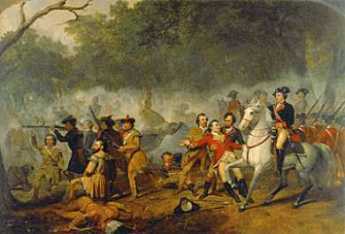
|
| The survivors of General Braddock's defeated army |
Allegheny Mountains from which to trade with, and possibly convert the Indians, the French had a rather elegant strategy for controlling the center of the continent. It involved urging their Indian allies to attack and harass the English-speaking settlements along the frontier, admittedly a nasty business. The survivors of General Braddock's defeated army at what is now Pittsburgh reported hearing screams for several days as the prisoners were burned at the stake. Rape, scalping and kidnapping children were standard practice, intended to intimidate the enemy. The combative Scotch-Irish settlers beyond the Susquehanna, which was then the frontier, were never terribly congenial with the pacifism of the Eastern Quaker-dominated legislature. The plain fact is, they rather liked to fight dirty, and gouging of eyes was almost their ultimate goal in any mortal dispute. They had an unattractive habit of inflicting what they called the "fishhook", involving thrusting fingers down an enemy's throat and tearing out his tonsils. As might be imagined, the English Quakers in Philadelphia and the German Quakers in Germantown were instinctively hesitant to take the side of every such white man in every dispute with any redone. For their part, the Scotch-Irish frontiersmen were infuriated at what they believed was an unwillingness of the sappy English Quaker-dominated legislature to come to their defense. Meanwhile, the French pushed Eastward across Pennsylvania, almost coming to the edge of Lancaster County before being repulsed and ultimately defeated by the British.
In December 1763, once the French and Iroquois were safely out of range, a group of settlers from Paxtang Township in Dauphin County attacked the peaceable local Conestoga Indian tribe and totally exterminated them. Fourteen Indian survivors took refuge in the Lancaster jail, but the Paxtang Boys searched them out and killed them, too. Then, they marched to Philadelphia to demand greater protection -- for the settlers. Benjamin Franklin was one of the leaders who came to meet them and promised that he would persuade the legislature to give frontiersmen greater representation, and would pay a bounty on Indian scalps.
Very little is usually mentioned about Franklin's personal role in provoking some of this warfare, especially the massacre of Braddock's troops. The Rosenbach Museum today contains an interesting record of his activities at the Conference of Albany. Isaac Norris wrote a daily diary on the unprinted side of his copy of Poor Richard's Almanac while accompanying Franklin and John Penn to the Albany meeting. He records that Franklin persuaded the Iroquois to sell all of western Pennsylvania to the Penn proprietors for a pittance. The Delaware tribe, who really owned the land, were infuriated and went on the warpath on the side of the French at Fort Duquesne. There may thus have been some justice in 1789 when the Penns were obliged to sell 21 million acres to the Commonwealth of Pennsylvania for a penny an acre.
Subsequently, Franklin became active in raising troops and serving as a soldier. He argued that thirteen divided colonies could not easily maintain a coordinated defense against the unified French strategy, and called upon the colonial meeting in Albany to propose a united confederation. The Albany Convention agreed with Franklin, but not a single suspicious colony ratified the plan, and Franklin was disgusted with them. Out of all this, Franklin emerged strongly anti-French, strongly pro-British, and not a little skeptical of colonial self-rule. Too little has been written about the agonizing self-doubt he must have experienced when all of these viewpoints had to be reversed in 1775, during the nine months between his public humiliation at Whitehall, and his sailing off to meet the Continental Congress. Furthermore, as leader of a political party in the Pennsylvania Legislature, he also became vexed by the tendency of the German Pennsylvanians to vote in harmony with the Philadelphia Quakers, and against the interest of the Scotch-Irish who were eventually the principal supporters of the Revolutionary War. It must here be noticed that Franklin's main competitor in the printing and publishing business was the Sower family in Germantown. Franklin persuaded a number of leading English non-Quakers that the Germans were a coarse and brutish lot, ignorant and illiterate. If they could be sent to English-speaking schools, perhaps they could gradually be won over to a different form of politics.
Since the Germans of Germantown was supremely proud of their intellectual attainments, they were infuriated by Franklin's school proposal. Their response was almost a classic episode of Quaker passive-aggressive warfare. They organized the Union School, just off Market Square. It was eventually to become Germantown Academy. Its instruction and curriculum were so outstanding as to justify the claim that it was the finest school in America at the time. Later on, George Washington would send his adopted son (Parke Custis) to school there. In 1958 the Academy moved to Fort Washington, but needless to say, the offensive idea of forcing the local "ignorant" Germans to go to a proper English school was rapidly shelved. This whole episode and the concept of "steely meekness" which it reflects might be mirrored in the Japanese response, two centuries later, to our nuclear attack. Without the slightest indication of reproach, the Japanese wordlessly achieved the reconstruction of Hiroshima as now the most beautiful city in the modern world.
Germantown Before 1730
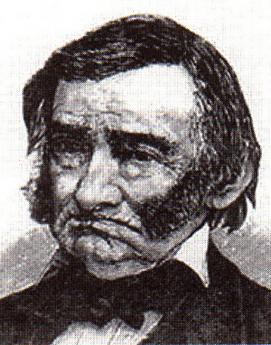
|
| Rev. Wilhelm Rittenhausen |
The flood of German immigrants into Philadelphia after 1730 soon made Germantown, into a German town, indeed. From 1683 to 1730, however, Germantown had been settled by Dutch and Swiss Mennonites, attracted by the many similarities between themselves and the Quakers of England. They spoke German dialects to preserve their separateness from the English-speaking majority but belonged to distinctive cultures which were in fact more than a little anti-German. This curiosity becomes easier to understand in the context of the mountainous Swiss burned at the stake by their Bavarian neighbors, Rhinelanders who sheltered them from various warring neighbors, and Dutchmen at the mouth of the Rhine, all adherents of Menno Simon the Dutch Anabaptist, but harboring many differences of viewpoint about the tribes which surrounded them.
Anabaptism is the doctrine that a child is too young to understand religion, and must be re-baptized later when his testimony will be more binding. In retrospect, it seems strange that such a view could provoke such antagonism. These earlier refugees were often townspeople of the artisan and business class, rapidly establishing Germantown as the intellectual capital of Germans throughout America. This eminence was promoted further through the establishment by the Rittenhouse family (Rittinghuysen, Rittenhausen) of the first paper mill in America. Rittenhousetown is a little collection of houses still readily seen on the north side of the Wissahickon Creek, with Wissahickon Avenue nestled behind it. The road which now runs along the Wissahickon is so narrow and windy, and the traffic goes at such dangerous pace, that many people who travel it daily have never paid adequate attention to the Rittenhousetown museum area. It's well worth a visit, although the entrance is hard to find (try going west on Wissahickon Avenue then turning around, a little beyond the entrance).
Even today, printing businesses usually locate near their source of paper to reduce transportation costs. North Carolina is the present pulp paper source, several decades ago it was Michigan. In the Seventeenth and Eighteenth centuries, paper came from Germantown, so the printing and publishing industry centered here, too. When Pastorius was describing the new German settlement to prospective immigrants, he said, "Es ist nur Wald" -- it's just a forest. A forest near a source of abundant water. Some of the surly remarks of Benjamin Franklin about German immigrants may have grown out of his competition with Christoper Sower (Saur), the largest printer in America, and located of course in Germantown.
Francis Daniel Pastorius was sort of a local European flack for William Penn. He assembled in the Rhineland town of Krefeld a group of Dutch Quaker investors called the Frankford Company. When the time came for the group to emigrate, however, Pastorius alone actually crossed the ocean; so he was obliged to return the 16,000 acres of Germantown, Roxborough and Chestnut Hill he had been ceded. Another group, half Dutch and half Swiss, came from Krisheim (Cresheim) to a 6000-acre land grant in the high ground between the Schuylkill and the Delaware. The time was 1683. The heavily Swiss origins of these original settlers give an additional flavor to the term "Pennsylvania Dutch".
Where the Wissahickon crosses Germantown Avenue, a group of Rosicrucian hermits created a settlement, one of considerable musical and literary attainment. The leader was John Kelpius, and upon his death the group broke up, many going further west to the cloister at Ephrata. From 1683 to 1730 Germantown was small wooden houses and muddy roads, but there was nevertheless to be found the center of Germanic intellectual and religious ferment. Several protestant denominations have their founding mother church on Germantown Avenue, Sower spread bibles and prayer books up and down the Appalachians, and even the hermits put a defining Germantown stamp on the sects which were to arrive after 1730. The hermits apparently invented the hex signs, which were carried westward by a later, more agrarian, German peasant immigration, passing through on the way to the deep topsoil of Lancaster County.
Harriton House
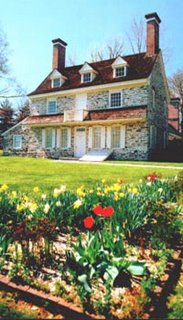
|
| Harriton House |
Three hundred years ago, in 1704, Roland Ellis acquired 700 acres of the Welsh Barony in what is commonly called Philadelphia Main Line and built a palatial house on it. He called his homestead Bryn Mawr, or great hill, after his ancestral home in Wales of the same name, thereby explaining why Bryn Mawr College and Bryn Mawr town have the name but are not notably situated on hills. The town of Bryn Mawr was once called Humphryville. But Bryn Mawr sounded nicer, even though there are plenty of Humphries still around to defend the older designation.
About fifty thousand acres were set aside by William Penn as the Welsh Barony, and there was the willingness to allow it to be self-governing, although that didn't much happens because the inhabitants saw no point in being self-governing. Nevertheless, the term isn't just an ethnic allusion, but has some historic meaning.
In any event, Ellis proved to be an unsuccessful manager of his estate, which rather soon passed into the hands of the Harrison family, who lived on it for about two hundred years until real estate development, and the taxes related thereunto, forced the creation of a complicated arrangement, with the township of Lower Merion owning the property and a non-profit group called the Harriton Association managing it. They have luckily obtained the services of a famous curator, Bruce Gill, who does research, writes papers, and organizes programs for visitors. The neighbors in the area, all living on land that formerly belonged to the Harrisons, are said to constitute the richest neighborhood in America. By building the original farmhouse rather far from the main road (Old Gulph) and remaining surrounded by neighbors who want to have privacy, Harriton House has fewer visitors than it deserves because it is so devilish hard to find.
There was a little local skirmishing during the Revolutionary War, but the main historical significance of the House was that Charles Thomson married a Harrison and lived there all throughout the period of the Revolution and the Articles of Confederation (1774-1789) as the Secretary of the Continental Congress. His little writing desk is, therefore, the most notable piece of furniture at Harriton House since every piece of official paper involved in the whole Revolutionary episode passed through it or over it. Modern organizations would do well to notice that Thomson was not given a vote and was expected to be totally unbiased about Congressional affairs. Even in those days, there must have been cautionary experience with secretaries who tinkered with the minutes for their own preferences. It certainly was entirely fitting that this last steward of the Articles of Confederation was designated to carry the news to George Washington at Mount Vernon, that he had been elected President of the new form of government. No doubt, Washington was pleased but unsurprised to learn of it.
While Harriton House is imposing on the exterior, and was the likely prototype of many characteristic Main Line stone mansions, the inside of the house is quite primitive. In those days it was cheap to build a big house but expensive to heat it. In 1704 surrounded by a continent of a forest, firewood may not have seemed a problem, but it quickly posed a transportation problem, and later houses tended to shrink in size. In any event, the interior of the house seems strangely bleak and bare, quite in keeping with the early Quaker principle of building a structure "without paint, or other adornments". Bruce Gill spent quite a lot of time and effort to determine that the random-width flooring had never received any shellac, varnish or wax. Those are beautiful floors, but the "finish" is just three hundred years of oxidized dirt.
The original Bryn Mawr, now called Harriton House, is well worth a visit. If you can find it; GPS is the modern solution.
Kenneth Gordon, MD, Hero of Valley Forge
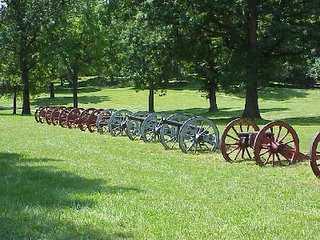
|
| Valley Forge |
There's no statue of Ken Gordon at Valley Forge National Park, although it would be appropriate. No building is named after him; it's probable he isn't even eligible to be buried there. But there would be no park to visit at Valley Forge without his strenuous exertions.
One day, Ken's seventh-grade daughter came home from school with the news that the father of one of her classmates said that Valley Forge Park was going to be turned into a high-rise development. That's known as hearsay, and lots of things you hear in seventh grade are best ignored. But this happened to be substantially true. At that time, the Park was owned by the Commonwealth of Pennsylvania, and Governor Shapp was finding the upkeep on the Park was an expense he needed to reduce. The historic area had two components, the headquarters area, and the encampment area. One part would become high-rise development and the other would become a Veteran's Administration cemetery. Although any form of rezoning has the familiar sound of politics to it, Dr. Gordon (a child psychiatrist) had the impression that Sharp was mostly interested in reducing state expenses, and had no particular objection to some better use of the historic area. At any rate, when Gordon went to see him, he said that he would agree to a historic park if Gordon could raise the money somehow. The Federal Government seemed a likely place to start.
Well, the sympathetic civil servants at the National Park Service told him how it was going to be. You get the consent of the local Congressman (Dick Schulze) and it will happen. If you don't get his consent, it won't happen. It seemed a simple thing to visit that Congressman, persuade him of the value of the idea, and it would be all done; who could refuse? After the manner of politicians, Schulze never did refuse, but somehow never got around to agreeing, either. It takes a little time to learn the political game, but after a reasonable time, the National Park employees told Gordon he was licked. Too bad, give up.
He didn't give up, he went to see his Senators, at that time Scott and Clark. They instantly thought it was a splendid idea, and instead of going pleasantly limp, they sent Citizen Gordon over to see Senator Johnson of Louisiana, the chairman of a relevant committee. Johnson also thought it was a great idea, and called out, "Get me a bill writer!" A bill writer is usually a government lawyer, tasked with listening to some citizen's idea and translating it into that strange language of laws -- section 8(34), sub-chapter X is hereby changed to, et cetera. Bill writers have to be pretty good at it, or otherwise, they will misunderstand the intent of the original idea, modified by the personal spin of the committee chairman, the comments of the authorizing committee, and later bargains struck in the House-Senate conference committee. Having negotiated all those hurdles, a bill has to be written in such a prescribed manner that it won't be found to have multiple loopholes when it later reaches the courts in a dispute. A good deal of the time of our courts is taken up with making sense of some careless wording by bill writers. That's what is known as the "Intent of Congress", an ingredient that may or may not survive the whole process.
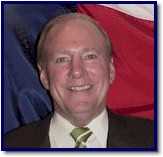
|
| Dick Schulze |
Ken Gordon had to go through this process, including testimony at hearings, for three separate congressional committees. To get everybody's attention, he organized several hundred supporters to write letters and get petitions signed by several thousand voters. These supporters, in turn, influenced the media and started a lot of what is known as buzz. All of this is an awful lot of work, but there is one thing about this case that can make us all proud. Not once did a politician suggest a campaign contribution was essential in this matter.
In time, ownership of the Park did in fact migrate from the Commonwealth to the U.S. Department of the Interior, hence to the National Parks Service. Everyone agrees it has been well managed, and increasing droves of visitors come here every year. It is now clearly a national treasure. Unfortunately, the encampment area got away and has been commercially developed, although not nearly as high-rise as originally contemplated. Along the way, many discouraging words were spoken about the futility of fighting against such odds. The outcome, however, is the embodiment of two slogans, the first by Ronald Reagan. "It's amazing what can be accomplished, if you don't care who gets the credit for it." The other slogan is older, and Quaker. All you need, to accomplish anything, is leadership. And leadership -- is one person.
One day Ken Gordon, the very busy doctor, was asked how much of his time was taken by this effort. His answer was, ten hours a week, every week for five years.
La Fayette, We Are Here
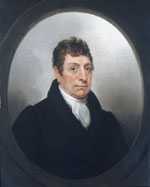 |
| Gilbert du Motier, marquis de La Fayette |
It will be recalled that La Fayette was 19 years old at Valley Forge, spoke no English, had no previous military experience. He nevertheless demanded, and got, a commission as Major General on the prudent condition that he have no troops under his command, at least for a while. Washington had been strongly reminded by various people that this young Frenchman was one of the richest men in France, a personal friend of the Queen, and thus critical to the project of enlisting French assistance in the war. Under the circumstances, it was shrewd to send him on the project of enlisting Indian allies among the Iroquois, since many tribes, particularly the Oneida, spoke French and held their former allies in the French and Indian War in great esteem. The chief of the Oneida Wolf clan (Honyere Tiwahenekarogwen) was visiting General Philip Schuyler in Albany at about the time LaFayette showed up on his mission to get some help for Valley Forge. General Horatio Gates was busy at the time rallying a colonist army to defend against the British under Burgoyne, coming down from Quebec, eventually to collide at the Battle of Saratoga.
Earlier in the war, Honyere's Oneida tribe had tangled with their fellow Iroquois under the leadership of Joseph Brandt (the Dartmouth graduate who was both biblical scholar and commander of several frontier massacres); the Oneida had many new scores to settle with the English-speaking Iroquois tribes. Honyere made the not unreasonable request that before his warriors went off to war, his new American allies would please build a fortification to protect his women and children from Brandt's Mohawks. LaFayette readily put up the money for this project, quickly becoming the Great French Father of the Oneidas. After some scouting and patrolling for Gates, Honyere and about fifty of his braves followed LaFayette to Valley Forge, where they soon made a nuisance of themselves to the Great White Father George Washington. Finally, word of the official French alliance with the colonists reached London, Howe was replaced by Clinton, and the British began to withdraw from their isolated position at Philadelphia.
It was thus that the jubilant rebels at Valley Forge learned that the fortunes of war had turned in their favor, and the French alliance was the source of it. With the British making preparation to abandon Philadelphia, it seemed a safe thing for Washington to give LaFayette command of two thousand troops, including the fifty Oneida Indians, and post them to Barren Hill (now LaFayette Hill), along Ridge Pike near Plymouth Meeting. Washington gave the strictest orders that they were to take no chances with anything, and particularly were to remain mobile, moving camp every day. This was not exactly what the richest man in France was anticipating, and wouldn't make a very saucy story to tell Marie Antoinette about. So, he promptly set about fortifying Barren Hill. Local Tory spies quickly spread this news to General Clinton, who promptly led eight thousand redcoats up the Ridge Pike to capture the bloody Frog. Clinton's plan was good; a detachment went around LaFayette in the woods and came back down Ridge Pike from the other direction, driving the Americans down the Pike into the open arms of the main body of British troops, coming up Ridge Pike. From this point onward, two entirely different stories have been told.
The more widely-held account has LaFayette climbing the steeple of the local church and noticing that there was an escape path, leading down the hill to the Schuylkill River at Matson's Ford. The Indian scouts were sent forward to hold off the British while the troops made their escape. Clinton sent a cavalry charge of Dragoons forward, yelling and waving their sabers, generally making a terrifying spectacle. The Indian scouts, as was their custom, were lying in the brush shoulder to shoulder, and at command by Honyere rose from the ground to let out a resounding chorus of war whoops. The Indians had never seen a cavalry charge, the Dragoons had never heard a war whoop, so both sides fled the battlefield without doing much damage. Meanwhile, LaFayette and his troops escaped to safety on the far side of the Schuylkill.
Other accounts of this episode relate that when Washington heard of it he remarked sourly that either they were pretty lucky, or else the enemy was pretty sluggish. In any event, a few soldiers were killed on both sides, the Americans crossing the River were described as "kegs bobbing on the pond", and it does seem the British army mostly just watched them do it. In the confusion, of course, everyone involved was fearful of being surrounded by unseen troops, and the British may well have worried the whole thing was a trap.
The saddest postscript to the Battle of Barren Hill is the fate of the Indians. After the war was over in 1783, the colonists busied themselves with taking over Indian land. Honyere pitifully petitioned the New York legislature for some consideration of his tribe's wartime service. They ignored him.
Lansdowne
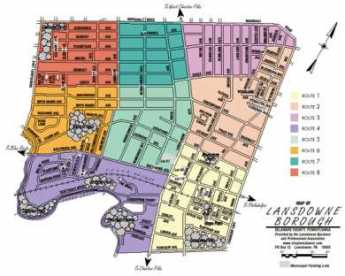
|
| Lansdowne Map |
The Granville, or Lansdowne, the family had so many members important in English history, that the Lansdowne name adorns countless schools, boroughs, colleges, museums and other monuments around the former British empire. It would require undue effort to sort out just why each memorial is named after just which member of the family. In the Philadelphia region, Lansdowne is the name of a small borough in Delaware County,
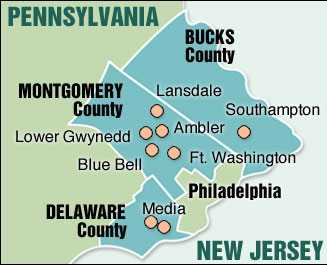
|
| Lansdale |
often annoyingly confused with Lansdale, a small borough in Montgomery County. However, it really seems more appropriate to focus reverence on the Lansdowne mansion, which from 1773 to 1795 was the home in now Fairmount Park of the last colonial Governor. That would have been John Penn, who was one of several Penns who still shared the Proprietorship until 1789, and who shared in the miserly payment which the Legislature of the new Commonwealth made as compensation for expropriating twenty-five million acres of their property. The French Revolution was going on at that time, so there were probably some patriots who would scoff that John Penn was lucky not to be guillotined.
The Penn family could see the Revolution coming, and like everyone else was uncertain who would win. Real decision-making for the Proprietorship rested with Thomas Penn in London, a close friend of the King and his ministers. The strategy employed in this difficult situation was to surrender the right to govern the colony conferred by its original charter and to become mere real estate owners with John their local representative pledging local allegiance. That might have worked for a while, until General Howe's troops captured Philadelphia. Soldiers were dispatched to Lansdowne to tell John Penn he was under detention, to reduce his potential utility to the occupying army.
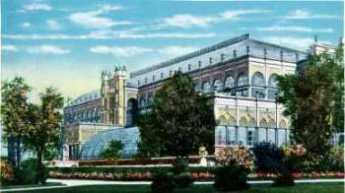
|
| Horticultural Hall |
As matters eventually worked out, some of the Penn descendants remained fairly wealthy after the Revolution, especially those whose wives had inherited substantial assets from other sources. But some were severely impoverished. The stately Georgian mansion burned down in 1854, and the site was then occupied by the Horticultural Hall of the 1876 Centennial Exposition. Perhaps because of misplaced patriotic fervor, it is now difficult to find a picture of Lansdowne.
The elegance of the place, on 140 acres, is suggested by the fact that William Bingham the richest man in America at the time, apparently acquired it from James Greenleaf the partner of Robert Morris, and the nephew by marriage of John Penn, who acquired it from Penn's estate but probably had to give it up in the financial disasters of Morris and his firm. Lansdowne was still a grand manner when it was briefly acquired by Joseph Bonaparte, the former King of Spain. In view of the fact that Bingham had provided President Jefferson with the gold to finance the Louisiana Purchase from Napoleon Bonaparte, and earlier had practically forced the Congress to call off an impending war with France, there was likely a connection here.
And to some extent, the ill-treatment which John Penn received from the Pennsylvania legislature (roughly fifteen cents an acre) in the Divestment Act of 1779 can possibly be traced to the unrelenting hatred by Benjamin Franklin, Pennsylvania's icon. History does not tell us what made these two former friends fall out in 1754, sufficient to make Franklin willing to spend years in London trying to get the colony away from the Penns. The feeling was surely mutual. When John Penn was offered the patronship of the American Philosophical Society, he declined, just because Franklin was its president. In retrospect, that sounds unwise.
Potts
Rebecca Potts used to say there were three towns in Pennsylvania named after her family -- Pottstown, Pottsville,
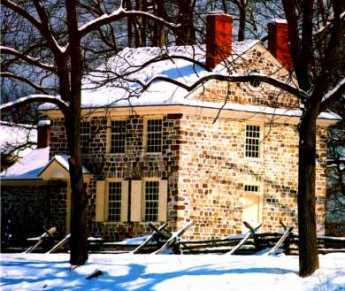
|
| Pottsville biennial |
and Chambersburg. Becky never designed to explain whether Chambersburg was just a joke or whether her very extensive family really had connections in Chambersburg. It's possible either way; there were certainly Potts inValley Forge where Washington's Headquarters, which everyone visits, had been home to Isaac Potts, the third generation of Dutchmen named Potts to live there. Isaac ran a grist mill, the others mostly were ironmasters. The family seat in Pottstown was named Pottsgrove, still open for visitors. Holland Dutch they may have been, but Pottsgrove architecture is definitely of the Welsh style.
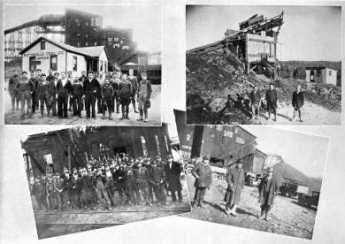
|
| Pottsville Coal |
Pottsville, much further up in the anthracite region, became notable through the novels of John O'Hara, a native son. For a whole generation, just about everybody in Pottsville was uneasy that O'Hara would confirm just who certain characters in his moderately raunchy novels represented in real life. Pottsville's main business for a century was extracting coal for the Girard Estate, which had its coal-mining headquarters in the town, based on Stephen Girard's shrewd purchase of nearly all of Schuylkill County.
The broad sweeping view from the interstate highway going north from Valley Forge makes it easy to see how Pottstown was created by the upheaval of a mountain ridge, which split open to let the Schuylkill River wind through. Pottstown is a water gap. The huge cooling towers of The Limerick nuclear power plant dominate one side of the river cliff and can be seen for miles. The cliff on the other side of the river, behind which hides the town of Pottstown, used to shelter the Wright aircraft factory, much of which was underground. That gave it a railroad (The Reading RR) and ready access to the river, plus privacy from the land side. Down to the right a mile is the Pottstown Hospital, on the edge of town, quite near the campus of the famous Hill School, fierce competitors of the Lawrenceville School in sports. Just about everything in this area is on top of some kind of hill.
Just back of the hospital, seemingly on the grounds of it, rises a peculiar steel tower, which the local workmen report is a sending station for cellular telephones. However, one of the doctors of the hospital relates a somewhat different history. He says he was once called on a medical emergency, told to ring the elevator at the little house beside the steel antenna, and travel down, down, into secret depths. He found himself in the headquarters of the Northeastern Air Defense Command, which was certainly hidden in an ideal place if the story has any truth to it. Unfortunately, that story-teller was a famous cocktail-party raconteur whose wild tales were never to be taken completely seriously. For many years, the hospital on a cliff was surrounded by corn fields, and it is certainly true you could look out the windows at a sea of corn, never suspecting you were very close to a railroad and a river, quite possibly right over an underground aircraft factory. Someday it may be possible to find out the truth of these tales of the Dutch country.
During the American Revolution, the British blockaded the coast and landed troops on the main coastal highways. The Americans responded in a quite natural way by building an inland north-south forest trail, sort of on the order of the Ho Chi Minh Trail. Pottstown was one natural stop on this trail, which tended to intersect with many roads coming up along the banks of the coastal rivers. In one very famous episode, wagon loads of Philadelphia Quakers were arrested and taken up the Schuylkill to Pottstown, then south to internment at Winchester, Virginia. They weren't exactly Tories, but they certainly were not sympathetic to revolutions. One of the most famous of these semi-prisoners was Israel Pemberton, one of the leaders of the Quaker colony. He later reported he was treated well, but onlookers in Pottstown described him as being thoroughly abused.
Pottstown had a century of prosperity during the industrial age, then declined and decayed. In recent years. The interstate highway has brought a migration of exurbanites whose taste in architecture tends toward McMansions. Let's hope they can acquire a dose of local history, starting a new historical revival of a town with great potential, considerable past glory, and a wonderful natural setting.
Radioactive River Bend
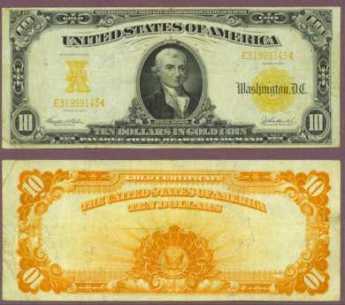
|
| Gold Cert |
A mile or two south of Pottstown, the Schuylkill River encounters a rocky ridge several hundred feet high and makes a bend around it. The first Treasurer of the United States, Michael Hillegas, built a colonial mansion on the point of the bend, and it has been lovingly restored and preserved by a noted Philadelphia surgeon and his wife. Alexander Hamilton, the first Secretary of the Treasury under the Constitution, has his picture on the modern version of a ten-dollar bill. So it is appropriate that Hillegas, the first Treasurer under the Articles of Confederation, had his picture on many versions of a ten-dollar gold note, back in the days when the American dollar was as good as gold. River Bend Farm is not only colonial, charming and maintained in mint condition, but it is also tucked away between the bend in the river and the high ridge to one side, giving it seclusion and privacy.
A high ridge near a river is unfortunately also an ideal place to build a nuclear power plant, and that's where the Limerick plant now looms up, glowing at night, occasionally making faint humming noises. There's a limited-access highway from Philadelphia to Reading which swoops up the valley, and the two high cooling towers of Limerick dominate the landscape for twenty miles. Because of the river bend, you aim straight for those towers for a long time before you swerve off, and the view is much like that from the bomber cockpit of the final scene in the movie "Dr. Strangelove". It gets your attention harmlessly, but it's hard to ignore. In spite of all sorts of official reassurance, everybody knows about Three-Mile Island, and Chernobyl, but few people emphasize there has never been a single injury from an American nuclear plant.
So, in 1981, everybody was ready to go into orbit when a worker named Watrus showed up for work at the nuclear plant and set off all manner of clanging alarms from radioactivity detectors. Panic and pandemonium for weeks, until a remarkable phenomenon was discovered. Watrus wasn't radioactive from the nuclear plant at all, but from having his work clothes laundered in his own basement. It slowly developed that radon gas seeps through the ground in many places in the United States, particularly over rocky ground. The gas then rises into the basement of houses and gets trapped. The more tightly the storm windows are applied and the more carefully sealed the seams of the house, the harder it is for the radon to escape. The Pennsylvania Dutchmen who live around Limerick are a little skeptical of this story and are not inclined to live any closer to the power plant that they have to. They are just as much in favor of oil self-sufficiency as anyone else, but still, no one likes being close to it.
The big winners from all this confusion are the people with radiation detectors, who go around the country testing people's basements for radon, for a fee. But unless you are willing to go live on the Sahara Desert, it isn't easy to see where you are going to go to avoid radon.
Rubberneck Tours of Philadelphia (1)
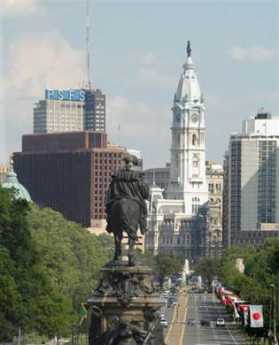
|
| Center City Philadelphia |
To qualify as a rubberneck tour, a route can be traveled in two hours by car, avoids the unsightly parts of town, strings together a lot of interesting sights which are of interest to visitors from out of town -- and educates the life-long residents as well. Several tours qualify, and it's a pity you can't go to someplace near City Hall and select one of them from a line of buses. Perhaps in time tourism will reach the point where this is possible.
For a start, go West from the center of town, out Walnut Street to 33rd Street, turn right. You won't see all of the University of Pennsylvania, but you will see a lot of it, followed by the campus of Drexel University. This was once a very elegant district, and many Victorian mansions can be seen as you go out to the Zoo. Navigate around a little with a map and get on Belmont Avenue. Be sure to get a glimpse of Sweet Briar mansion, peeping through on the right. You will be able to see Memorial Hall and other remnants of the 1876 Exhibition, soon to be the site of the Please Touch Museum. Keep going on Belmont, past the Ohio House which dates from the Exhibition, and on out Belmont Avenue to City Line Avenue. Here's the surprise.
Cross over City Line Avenue into Montgomery County and keep going. You will go past some lovely houses on the left, and the borders of Laurel Hill Cemetery on the right. You are going downhill now, through the woods, and you sweep around the right to the bridge over the Schuylkill. Didn't expect to go out of the city into the woods so abruptly, did you?
And now, crossing the Schuylkill, turn abruptly right on to Main Street in Manayunk. Another scenic shock, as you emerge from a country lane onto several miles of a gentrified abandoned factory town. In the summer, there are an awful lot of people sitting at sidewalk tables, talking about who knows what. Perhaps they are mostly resting their feet from shopping, whatever that means, in all the little stores now selling shoes and kerchiefs, apartment furniture, and knick-knacks. After a while, Main Street turns into Ridge Avenue, which eventually leads you back to the Benjamin Franklin Parkway, and back to City Hall. A somewhat prettier drive is closer to the river, with the landscaping and boathouses of the Schuylkill Navy.

|
| Fairmount Park |
But continuing on Ridge Avenue allows you the option of an abrupt turn left on Schoolhouse Lane, where it's admittedly a little hard to find and navigate a left turn, scooting you abruptly back up a steep hill and into the woods again. Turn right on Vaux, right again on Warden Drive, and then left to Midvale, following it down to rejoin Ridge Avenue at the bottom of the hill. This little side-trip allows you to see some pretty unexpected woody suburbs, and if you have been told where to look, the former home of Grace Kelly, and the homes of Senator Spector and Governor Rendell.
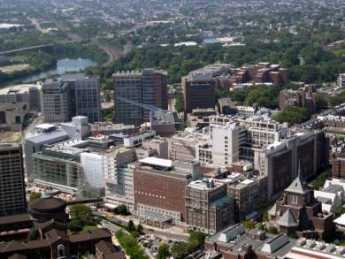
|
| UPENN |
Give it a few years, and Ridge Avenue at this point is sure to get gentrified like Main Street, back up that hill in Manayunk. Now, either take Kelly Drive back into town, or continue down Ridge past old (East) Laurel Hill Cemetery and a brief spin into Sedgely and the mansions along the cliff in East Fairmount Park. Or a brief detour over the Girard Street bridge to the edge of West Fairmount Park is worth a few minutes, returning by the Spring Garden Street bridge to the back of the Art Museum, and then down the Parkway.
You've just had a pleasant two-hour tour, researched and designed by the history department of the University of Pennsylvania to illustrate Philadelphia's role in the days of the Civil War. Back then, the area roughly enclosed by our rubberneck tour #1 was just beyond the edge of the town, an ideal spot for many training camps for the Union Army. Further south on the Schuylkill at that time was a collection of factories known as the "arsenal of the North". This more northerly part of town, now filled with thousands of brick row houses, was once let us say, the boot camp of the North.
Sugarloaf

|
| Germantown Map |
Germantown Avenue goes continuously uphill from its start at the Philadelphia waterfront until it reaches Sugarloaf in Chestnut Hill. It follows an old Indian Trail, and that's where the Indians apparently wanted to go. From Sugarloaf northward, it's all downhill.
The name derives from the shape of the hill at that point and is a fanciful description of the sudden shift from Wissahickon gorge to the Whitemarsh Valley, which occurs at that point. The underlying rock changes from hard "gneiss" to limestone. In early times, this was the location of the farm of William D.Stroud, whose son was Teddy Roosevelt's doctor and the first one to introduce the electrocardiogram to this country. Around 1928, James Page built an imposing mansion with a wrap-around porch at the top of the 40-acre estate, naming it Wycliffe. Around twenty years later, the real estate magnate Albert M. Greenfield acquired the property, which eventually was given to Temple University as a conference center, although a fire destroyed the wrap-around building. That's Sugarloaf, and you can visit it.
Two stories about Greenfield, himself, still circulate around town. The first concerns a banker who met Greenfield at the corner of 15th and Walnut Streets.
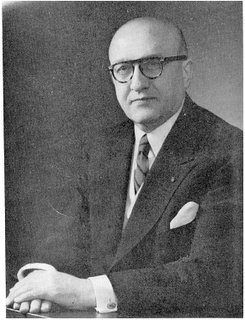
|
| Albert Greenfield |
The real estate man was looking up at the massive old Drexel building, where Anthony Drexel and J.P.Morgan were partners, and where Edward T. Stotesbury made lots of waves during the 1920s. Stotesbury acquired a personal wealth of about $100 million as "the richest Morgan partner" and was determined to spend every penny of it before he died in 1938. The stories of the extravagance of this birthright Quaker, and particularly his wife, are legendary. Anyway, Stotesbury held court at a big desk, just inside the door at 15th and Walnut. Greenfield was standing outside that door, chatting with his banker friend.
"Do you remember that big desk where Stotesbury used to sit?" Yes. "Well, I used to sell newspapers at the corner here and watched Stotesbury go in and out. I want you to know I just bought that building, myself, and I'm going to put my desk right where Stotesbury used to sit."
Unfortunately, he never did. Within two months, he was dead of pancreatic cancer.
The other story was told of Greenfield's integrity, the sort of thing that was central to the long-standing success of Philadelphia businessmen in commerce and banking. When bargains are stuck in a conversation, the deal is sealed with a handshake, and you better be as good as your word.
Hubert Horan, the Chairman of the Broad Street Trust, was interested in a piece of property, and over lunch agreed to pay Greenfield three million dollars for it. Before any papers were signed, another man came rushing into Greenfield's office and excitedly announced he wanted to buy the property. "I'm sorry," said Greenfield, "I just sold it to Hubert Horan". How much? "He agreed to pay three million for it." Did you sign anything? "No." Fine, I'm willing to pay you FOUR million for it."
"Well," said Greenfield, "I suggest you go see Hubert Horan. He owns it."
West Fairmount Park
Fairmount Park is considerably larger on the west bank of the Schuylkill than on the east, and the points of interest are somewhat more diluted by woods and pasture. Partly, that is a consequence of being the site of the 1876 Centennial Exhibition , and partly that urban growth had not encroached so much into the farmland at the time the park was created. On the west bank at the time of the Revolution, there were still 300-400 acre farms, whereas the east bank farms had been cut up into gentleman's
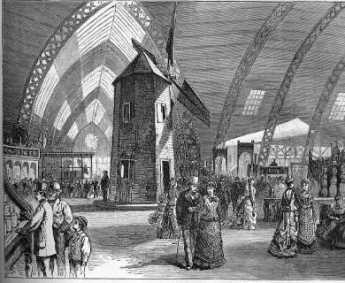
|
| Centennial Exhibition |
estates. The Schuylkill takes two 90-degree turns within the Park limits, leaving a point of high land on either side of the river. On the east side, the East Park reservoir is at the apex, and on the west side, the dominant point is Belmont Mansion. For a while, there was a restaurant at Belmont, but at the moment it's a pity but little advantage is taken of a very scenic view. Two judges once lived in the mansion, William Peters, and his nephew Richard Peters. William was a Tory and had to flee to England. Richard made a better guess and as a rebel, therefore could live on in scenic splendor.
For orientation, the West Park mansions extend in an arc from The Solitude in the south to Chamonix in the north. For the moment limiting our list to houses present when the Park was created, there is Sweetbrier, The Pig-Eye Cottage, Belmont, Ridgeland, Greenland, and the Lilacs. The last three houses belonged to three well-known Philadelphia families, Garrett, J.B. Lippincott, and Walnut, who established themselves in 19th Century commerce rather than 18th Century politics. Sweetbrier was one of those centers of French Philadelphia, when Samuel Breck continued his father's close relationship developed as the fiscal representative of French Forces in America, entertaining LaFayette and other such friends of the new Republic. The Pig-eye cottage is used by the Park administration, and closely resembles the Caleb Pusey house, but otherwise has no remarkable history. Solitude, on the other hand, really was the retreat for John, then Richard, then Granville. John Penn entertained George Washington here while he was presiding over the Constitutional Convention.
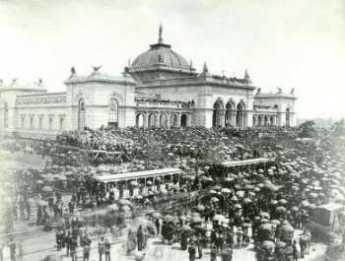
|
| fair |
Fairmount Park is notable for some buildings which are unfortunately no longer there, and some other buildings that were transplanted there. The East Park is a historical monument, while the West Park is more a house museum. Governor Mifflin's house is gone from the Falls area, Powelton is gone, and Lansdowne the estate where the Proprietor John Penn was seized by rebel soldiers. His family was later paid less than a penny an acre for the 21 million acres of Pennsylvania land they clearly owned. Sedgley is also gone, and all of these places have a place in history. On the other hand, it is well to remember that all of the industrial slums along the river were cleared away to be replaced by the charm of Boat House Row.
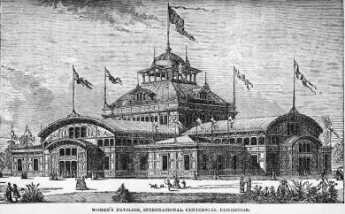
|
| Exhibition |
It keeps being repeated that Fairmount Park is the largest urban park in America, but the fact is it is bigger than the city can afford to maintain, just as a monument to the colonial style of life. It was a grand place to have a World's Fair in 1876, and Memorial Hall remains, along with the Japanese pavilion, a truly priceless reproduction of Japan under the Shogun. Fairmount Park has the first Zoo in America, still a place of note in zoological circles, and many ballparks, summer music halls, and other modern recreational attractions. It contains Cedar Grove, a splendid Quaker homestead in Welsh style, transported from its original location in Frankford. The Letitia Street House was too fine an example of 17th Century urban architecture to lose, so it was moved to the Park from Letitia Street, approximately 2nd and Market Streets. William Penn lived for a while on Letitia Street, named after his daughter, but it is not entirely clear who lived in this particular little house. There doesn't seem to be anything you can do about people calling it the William Penn House.
Fairmount Park is the largest urban park. It doesn't have roley coasters, but we don't miss them, and it doesn't have Mickey Mouse, at least so far. There is absolutely nothing like it anywhere. Anyway even if there were, Philadelphians wouldn't notice.
Fair Mount
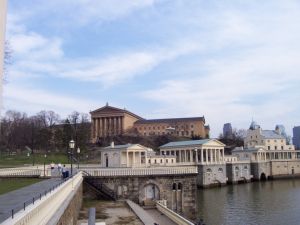 |
| THE FAIRE MOUNT |
Although the Art Museum now dominates the end of the Benjamin Franklin Parkway, the earlier focus of the acropolis once called Fair Mount is just down the hill behind it, in the old Grecian complex of the Philadelphia waterworks. When the Schuylkill was dammed at that point, the effect was to calm the rapids, drown the falls at Midvale Avenue upstream, and turn this portion of the river into a placid fresh-water lake. Fairmont Park was then created upstream in an effort (originally stimulated by the College of Physicians of Philadelphia) to reduce pollution of Philadelphia's water supply going into the pumps at the Waterworks, by replacing, with parkland, the wards, and industrial slums at the terminus of the canal bringing anthracite from upstate. The result was the creation of an ideal place for public boating and skating.
The transformation of this area can be seen in retrospect as an impressive civic response to economic upheaval. The War of 1812 (by cutting off ocean access to bituminous via the Chesapeake) had first forced Philadelphia to use anthracite hard coal, and the discovery of anthracite's superiority in making steel caused a continuing reliance on it and the canals
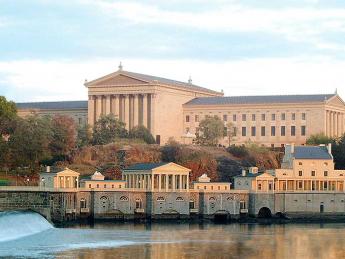
|
| Philadelphia's Water Works |
that brought it here. By 1850, the Philadelphia and Reading Railroad made the canals obsolete and created this splendid opportunity for urban renewal. The waterfalls had created a natural boundary between industry oriented to upstate coal and other industry oriented to oil and commerce coming up Delaware. It is a great pity that the lower section of the Schuylkill, once so famously beautiful, has never stimulated the same vision and imagination in response to the eventual decline of the industrialization which defaced it.
To return to Boathouse Row, a large azalea garden starts the Park, and then the East River Driver winds along the attractively landscaped riverbank. Just beyond the azalea garden, the first of ten Victorian-style boathouses starts the home of the Schuylkill Navy, an association of rowing clubs which are now a century and a half in residence there. When the Schuylkill auto expressway was created on the other side of the river, someone had the bright idea of decorating the rowing houses with lights along their edges in the manner used for Christmas decorations in South Philadelphia, especially on Smedley and Colorado Streets. Ever since the entrance to Philadelphia from the West has become one of its most arresting beauties.
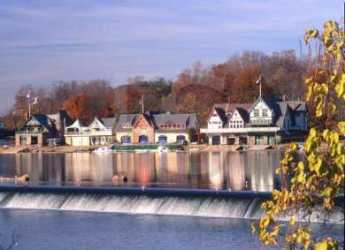 |
| BOATHOUSE ROW |
Add a few cherry blossom trees in the spring, and you have quite a memorable centerpiece. Rowing sometimes called crewing, or sculling, is a central focus of Philadelphia society, and is curiously not something in which the city can claim to be first or the oldest. As you might expect, "regatta" is a word invented in Venice five hundred years ago, there are records of rowing races as far back as 400 BC, and New York -- ye Gods! -- had the first American boating club. The Philadelphia Schuylkill Navy was formed as an association of rowing clubs in 1858, and the oldest member, the Bachelor's Barge, was only formed in 1856. The development was largely spontaneous and is said to have been briskly stimulated by a beer garden nearby, run by a former Philadelphia sheriff. About the same time, the British became crazy about the sport, having the Henley Races as the most famous regatta in the world, and both the Australians and the Bostonians occasionally have the largest, most expensive, most widely advertised regattas. Foo. Philadelphia has the Schuylkill Navy, and it is central to our existence.
There are a couple of things which are unique about rowing. In the first place, it is hard to think of a way to cheat. You can hire engineers to redesign the shape and size of your boat, but engineering really doesn't make a lot of difference once the basic development of oarlocks and movable seats was perfected. A good boat can cost as much as $30,000, but that is large because all boats approach the limit of speed. If you have heavier or stronger oarsmen, it doesn't make that much difference. What matters is coordination, and in the longer boats, teamwork. Pull up with your shoulders, push with your legs, don't start with your buttocks, the art of rowing involves your whole body. The greatest champion of all time, Edward "Ned" Hanlan,
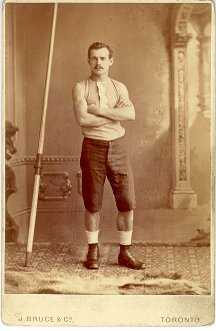 |
| EDWARD HANLAN |
only weighed 155 pounds. Not only was he world champion from 1876 to 1884, he was undefeated in any race during the last four years. True, he was born in Toronto, and eventually he was thrown out of polite Philadelphia racing for deliberately ramming another boat, but those are private Philadelphia comments, not something you want to talk too much about. The whole secret of rowing is to manage the fact that the boat travels farther between strokes than while the oars are in the water; if you row too fast, you actually slow the boat. There are two other Philadelphia names associated with the Schuylkill Navy. One is Thomas Eakins, the great American painter, one of whose most famous pictures is that of Max Schmitt in a Single Scull (on the Schuylkill). The other name is Kelly.
John B. Kelly of Philadelphia won two Olympic gold medals in 1920 and did it within one hour. He won a Third Olympic gold medal in 1924. But when he tried to race in the Henley Regatta, he was declared ineligible to row, because he had worked with his hands (summer work as a bricklayer), and thus could not really be called a gentleman. Anyone who has ever heard Irishmen talk about Englishmen can imagine the reaction this caused in the Kelly family. The resentment took the form of pushing his son, Jack, into racing, and in 1947 John B. Kelly, Jr. won the Diamond Sculls at Henley. Meanwhile, the father vindicated himself in other ways. The firm of Kelly for Brickwork was an enormous financial success, right up there next to Matthew H. McCloskey and John McShain, the political builders of the Pentagon and numerous other government buildings. John B. Kelly unsuccessfully ran for Mayor of Philadelphia in 1935 during the 75-year period when Philadelphia Mayors were always Republicans, but for decades was in the much more powerful position of head of the local Democratic party. The Republicans at that time would meet for lunch at the Union League, and so John Kelly reserved a lunch table at the Bellevue Hotel, next door, where he could be seen holding court every day.
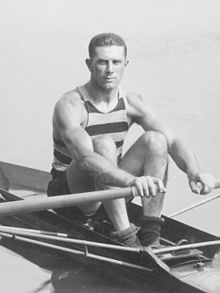
|
| John B Kelly |
The result was not entirely favorable for the Bellevue; more than one wedding reception was rescheduled to some other hotel in order to avoid the Democrat taint. But you always knew where you could find Kelly at lunch, and it was fun to watch the various minions come forward to the table, almost as if they were in chains, to pay homage which involved provoking loud laughter from the great man with a salacious joke. The rowing clubs are mostly big barns with old boats high up on the walls, and silver cups and wooden memorial plaques lower down. They have lockers and showers, but no dining rooms, except at catered in the evening for parties. For a century, no women came there, but now almost half of the rowers are female. Membership is not difficult to obtain, although you have to be good to get on the club teams, and the dues are not expensive. If you show promise, you are expected to spend most of your waking hours working at it. Jack Kelly was famous for rowing three hours every morning, going to lunch, and then coming back for a couple of hours of more rowing. That doesn't leave much time in your life for anything else, so the friendships developed among active club members are very strong, just like the horsemen over at the City Troop. They sort of life in the past a little, with many anecdotes about a skull that broke apart and sank in the midst of a race, or a race that was lost because of too much recreation the night before. The lingo has to do with the fine points. A race can be between "eights" or "fours", or doubles, or singles. It can have a coxswain, or not, and be coxed or unboxed. When a pair of rowers have two oars apiece, it is the normal arrangement. A much more difficult boat to control has two rowers, with one oar apiece. Like Hercules or Achilles, stories are told of Hanlan, great Hanlan, who sometimes would win a one-mile race by eleven lengths. Or who would get so far ahead of his competitors that he would lie down in the boat and wait for another boat to catch up -- and then race ahead to beat him. This sort of person can be a little hard to take, and it is privately muttered that Hanlan was sent off to Australia, where people do that sort of thing more commonly.
The Schools of School House Lane

|
| Union School founded in 1759 |
The region of Philadelphia defined as Germantown is recorded by the last census as having about 50,000 inhabitants today, 40,000 of whom are of the black race. Germantown has always had an unusual concentration of schools of the highest quality, and here on one street alone there are four. School House Lane runs off to the West of Germantown Avenue, and was originally right at the center of town, the center of the action during the Revolutionary War. The most historic of the schools, the Union School founded in 1759, changed its name to Germantown Academy, and more recently picked up and moved to new quarters in Fort Washington. George Washington sent his nephew there, and its building served as a hospital for the wounded in the Battle of Germantown. When Germantown Academy moved out of Germantown, the Pennsylvania School for the Deaf moved into the vacated quarters. This school had been originally founded in 1820, and is one of nearly a hundred special schools for the deaf in the United States, operating as a quasi-public institution for about 170 students. A remarkable thing about all schools for the deaf is the high IQ of their students. Perhaps deaf underachievers are somehow filtered out by the struggle to adapt before they apply for admission, or perhaps there is something about being deaf that makes you smart. In any event, the average SAT scores of students from PSD, like all schools for the deaf, are always in the very highest ranks among secondary schools.
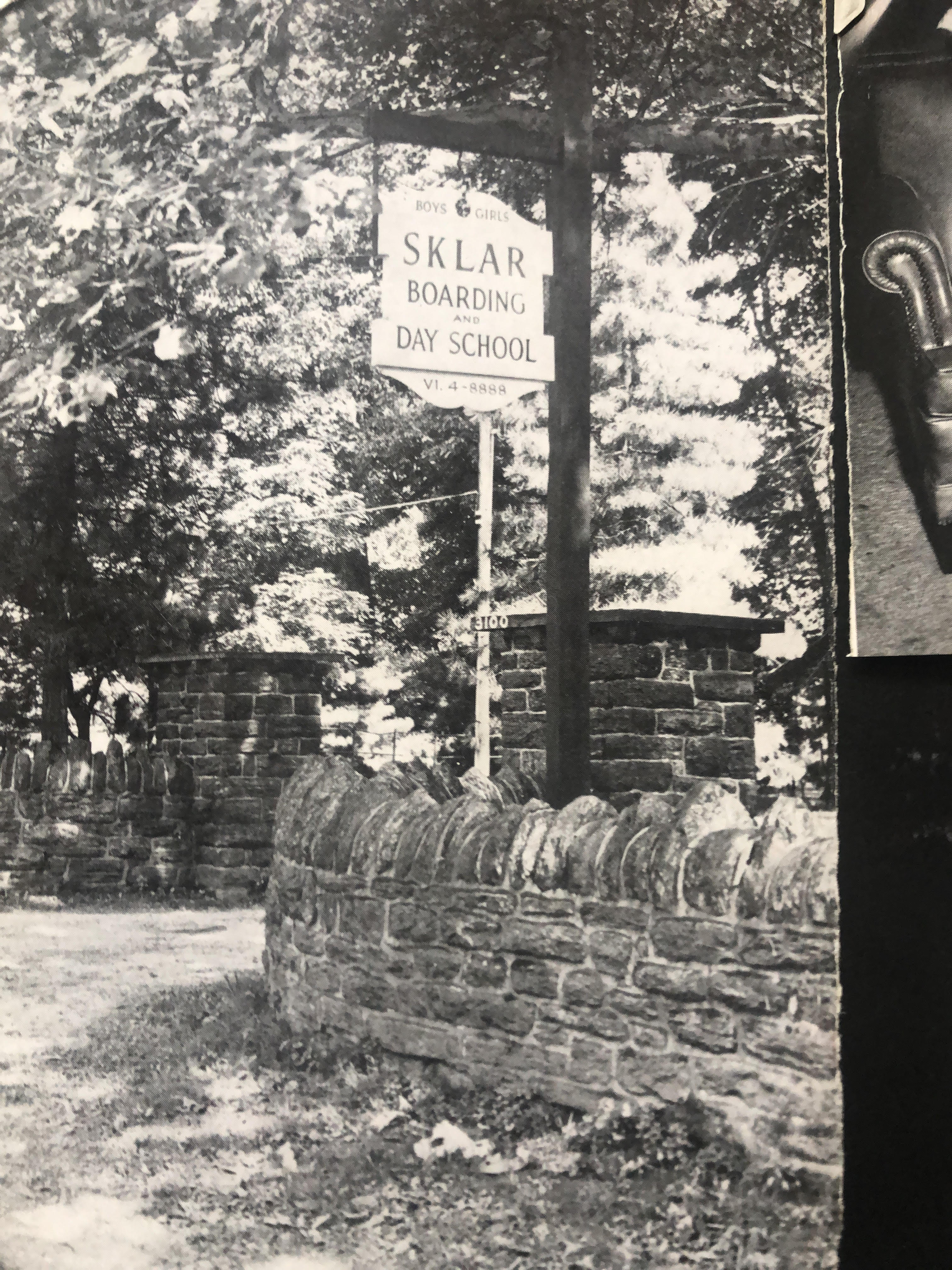
|
| Sklar School Entrance |
More or less next door to it, fronting on Coulter Street, is the Germantown Friends School(GFS), which enjoys and deserves the reputation of the most intellectually rigorous school in the Philadelphia region. There is little question about the Quakers of this school, founded in 1845, but relatively few of the students are now Quaker children. It's pretty expensive and quite uncompromising about its academic standards, but if you want to be accepted by a famous University, this is the place that can boast the most achievement of that variety. By no means all of its graduates become teachers, but alumni of this school do tend to gravitate to the top of academia. That could eventually put them on college admission committees, of course, and perhaps the admission process promotes itself. There can be little doubt that if most of a given college's admission committee happened to play the tuba, that university would soon fill up with tuba players.
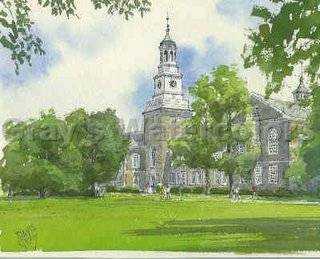
|
| William Penn Charter School |
Further West on School House Lane, is the William Penn Charter School. It's also Quaker, and while it doesn't work quite so hard at it as GFS does, it has plenty of social mission, a great deal more discipline, and plenty of competitive athletics. A minority of its students, also, are Quakers; but as a guess, most of its graduates are headed for disproportionate affluence anyway. The middle school is named for, and was donated by, the former chairman of Morgan Stanley back before Morgan Stanley sold itself to Dean Witter. This school was founded in 1689, and for a long time was located at 12th and Market Streets in Philadelphia, right where the famous PSFS building was built, the one that later converted to Lowe's Hotel .
Finally, near the crossing of Henry Avenue with Schoolhouse Lane, is the Philadelphia University. Since it was founded in 1999 it is the youngest of the schools on School House Lane, specializing in architecture and design, and seems headed for even broader curriculum. The University was formed by the merger of Ravenhill Academy for Girls, and the Philadelphia Textile School. The Textile School was itself formed during the 1876 Philadelphia Centennial, when local industrialists became concerned with how backward America seemed in its quality and design of textiles, compared with other nations which exhibited at that World's Fair. Next door, was once the home of William Weightman, a chemical manufacturer who was reputed to be the richest man in Pennsylvania. After his death, the rather grand estate became the site of the Ravenhill School for Girls, which was the school which could boast Grace Kelly for an alumna. That was natural enough since she lived just around the corner on Henry Avenue and could walk to school. The contrast between the two ends of School House Lane, Henry Avenue on one end, and Germantown Avenue on the other, is just astounding.
So there you have School House Lane. A few short blocks with three distinguished preparatory schools and a university. Plus, the site of three other famous schools which have either moved or merged. You might think Germantown was the home of myriads of school teachers, but that isn't exactly so. It's hard to say just what this complex anomalous situation proves, except to voice the opinion that it is somehow at the heart of what Philadelphia really is.
Note, kind readers have also sent me the names of six more schools on Schoolhouse Lane. Some of them may only be name changes, but the list includes Parkway Day School, Sklar School, Philadelphia Textile and Science, Germantown Stevens Academy, Germantown Lutheran Academy, Greene Street Friends School. (See Comments.)
The Quaker Who Would Be King
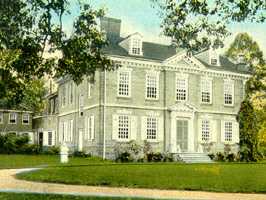
|
| Cliveden |
Two decades passed. What we now call the American Revolution started rumbling in far-off Lexington and Concord, soon moved to New York and New Jersey. General William Howe, the illegitimate uncle of King George III, then decided to occupy the largest city in the colonies, tried to get his brother's Navy up Delaware but hesitated to persist in a naval attack on the chain barrier blocking the river. He considered but abandoned trying to outflank the New Jersey fort at Red Bank, the land-based artillery at Fort Muffling, and heaven knows what else along the twisting shaggy Delaware river. Giving up on that approach, Howe sent the navy down to Norfolk and back up the Chesapeake, landing the troops at the head of the Elk River. Washington was outflanked at the Battle of the Brandywine Creek trying to head him off, although he suffered far fewer casualties than the British. A rainstorm, presumably a fall hurricane, disrupted his planned counterattack near Paoli. So Howe invested Philadelphia, organizing his main defensive position in the center of Germantown. His headquarters were in Stenton and Morris House, General James Agnew was at Grumblethorpe The Center of British defense was at set up at Market Square where Germantown Avenue crosses Schoolhouse Lane. With Washington retreating to Valley Forge, that should take care of that. Raggedy rebels were unlikely to attack a prepared hilltop position with a river on either side, defended by a large number of British regulars.
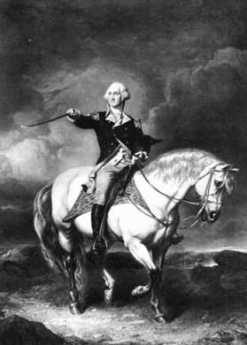
|
| George Washington |
Washington did not look at things that way, at all. Cut off from their fleet, the British situation would be precarious until Delaware could be re-opened. He had watched General Braddock conduct with bravado an arrogant suicide mission in the woods near Ft. Duquesne, and also knew the British always based as much strategy as possible on their navy. Washington's plan was to attack frontally down the Skippack Pike with the troops under his direct command, while Armstrong would come down Ridge Avenue and up from the side. General Greene would attack along Limekiln Road, while General Smallwood and Foreman would come down Old York Road. In the foggy morning of October 3, the main body of American troops reached Benjamin Chew's massive stone house, now occupied by determined British troops, and General Knox decided this was too strong a pocket to leave behind in his rear. Precious time was lost with an artillery bombardment, and unfortunately, the flanking troops down the lateral roads were late or did not arrive at all. The forward movement stopped, then the British counter-attacked. Washington was therefore forced to retreat, but he did so in good order. The battle was over, the British had won again.
But maybe not. Washington hadn't routed the British Army or forced them to leave Philadelphia. They did leave the following year, however, and there was meanwhile no great desertion from the Colonial cause. Washington's troops suffered terrible privation and discouragement at Valley Forge, but the crowned heads of Europe didn't know that. For reasons of their own, the French and German monarchs were pondering whether the American rebellion was worth supporting, or whether it would soon collapse in a round of public hangings. From their perspective, the Americans didn't have to win, in fact, it might be useful if they didn't. But if they were spirited and determined, led by a man who was courageous and resolute, their damage to the British interests might be worth what it would cost to support them. The Battle of Germantown can thus be reasonably argued to have been an advancement of colonial goals, even if it could not be called a victory. However, when the news of Burgoyne's defeat at Saratoga soon reached them, the European enemies of England decided the colonists would be useful allies.
In Germantown itself, the process of turning a military defeat into a strategic victory soon began, with severe alienation of the German inhabitants against the destructive experiences of British military occupation. After a winter of near starvation, Germantown would never again see itself as the capital city of a large German hinterland. It was on its way to becoming part of the city of Philadelphia.
Battle of the Clouds: September, Remember
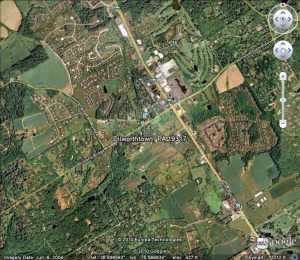
|
| Dilworthtown |
Weather satellites, television and so on have taught us much about hurricanes that was unknown in 1777. Benjamin Franklin, it should be noted, was the first to observe that Atlantic Coast "Nor'easters" actually begin in the South and work North, even though the wind seems to be blowing in the opposite way; what's moving toward the northeast is a low-pressure zone. We now know that hurricanes begin in Africa, travel West and then veer North when they reach Florida. A great deal is still to be learned about hurricanes, but the most important thing about their timing is contained in a maritime jingle:
June, too soon.
July, stand by.
And then: September, remember.
October, all over.
Along the Atlantic east coast, the end of August to the middle of September, is hurricane season. That's when houses blow down in Florida, and heavy rains hit Pennsylvania. Admiral Howe might have had some clue to this, since Franklin made his observation around 1750, and storms are important to Admirals. But very likely his brother the General just thought it was one of those things when the British landing at Elkton, Maryland in late August 1777 was greeted with an unusually severe downpour of rain. Howe had planned to surprise Philadelphia from the rear by hitting the ground running on horseback. However, he underestimated the debilitating effect on the horses of three weeks at sea on sailboats; to unload and forage horses during a hurricane was almost too much for the plan. For that purpose, he had given orders for the troops to disembark without waiting to pitch camp, or unpacking their gear. But the drenching rain gave Washington several extra days to organize a defense, although he has been given too little credit for the strenuous accomplishment of moving an army from Bucks County to the banks of the Brandywine in that weather. Howe, whose trademark was surprise, deception, outflanking, had anticipated a sudden cavalry thrust into the backyards of unprepared Philadelphia. What he got was 2000 casualties in the biggest battle of the Revolutionary War, against Washington's well-prepared defense along the steep-sided Brandywine Creek.
Howe won this battle, in the sense that Washington was forced to withdraw, because Howe employed another British military trademark, of driving his own troops beyond humane limits in a huge outflanking movement. The countryside around Kennett Square is hilly and broken almost to West Chester, and the American Army felt reasonably prepared along a front of ten or twelve miles. But Howe drove the main force of his army seventeen miles to the north, to Dillworthtown, before turning the unprepared American right flank. And, in the now hot August weather in full uniform and battle pack, the drive continued for twenty-four consecutive hours until Washington saw he had to withdraw. This was what the British meant when they boasted of seasoned regular troops; you win by enduring more than your opponent can endure.
One has to have equal admiration for Washington. Although he was dislodged from his position, losing the opportunity to catch the British in a hostile region without a reliable source of supplies once the fleet weighed anchor, he preserved his army of marksmen and deer hunters intact during the retreat. The two armies started at roughly the same size, and Washington had only about 1300 casualties; his men had more certain supply sources, and they were fighting for their homes. The British, somewhat outnumbered, had the prospect of fighting their way without resupply through an enemy's home territory, capturing the enemy's capital, but still facing the possibility that the British fleet might not get past the Delaware River defenses. If that happened, they could celebrate their victory by starving to death. Just about the only weakness of the Continental Army was its discomfort with bayonet warfare. They could hit a squirrel at a hundred yards, but those long bayonets on the end of very long muskets were designed to protect foot soldiers from cavalry charges. It takes training to put the butt of the musket against a stone on the ground, hold your ground against an oncoming gallop of horsemen, and trust that at the last moment the horses will rear back and throw the riders. But it also takes naked bravado to wave a sword and ride full tilt into a forest of pointing bayonets, trusting that at the last moment the defenders will break and run.
But Washington knew what he was doing. He pulled the troops back to Chester, then over the Schuylkill to the Germantown encampment at Fox and Queen Lane, then up the Schuylkill to Norristown, the first ford in the river that Howe must use when the boats and bridges were destroyed. The river would hold the British while the Americans came at them from the rear; this was essentially the same river strategy he used at the battle of Trenton. Washington picked his battlefield in Chester County and got ready to fight the second installment of the Battle of Brandywine. The campus of Immaculata University now occupies the site.
And then it rained, again. Hard. The gunpowder on both sides was soaked, useless. In what has come to be known as the "Battle of the Clouds", the fighting was called off by mutual agreement. The second hurricane of the year had arrived, and Washington more or less helplessly had to watch Howe take over Philadelphia unopposed. He lost the capital, provoking dismay among the colonists, but his masterful strategy taught the British to respect him. When the British were later considering whether to hold or abandon Philadelphia, this growing respect for their adversary helped tilt their thinking toward prudence.
But that was not before Howe once more showed he too was not the lazy slacker that others had called him. General "Mad Anthony" Wayne was dispatched with fifteen hundred troops to hassle the rear of Howe's army. Wayne was confident he could hide his troops in the Radnor area where he had been brought up, but the region in fact had many Torys to report his movements. Howe ordered Major General Lord Charles Grey to take the flints from his troops' muskets, attack the American camp near Paoli's tavern in the night, and use only bayonets. Waynes' troops were scattered and slaughtered, in what came to be known as the Paoli massacre.
The Center of Town
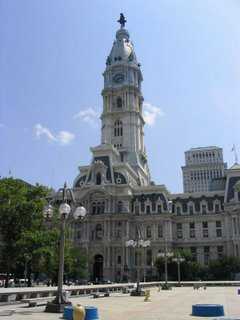
|
| city hall |
It took two hundred years for the inhabited part of the city to reach the square which William Penn had envisioned for the center of his green country town, and by the time it did, the area around City Hall had come to resemble the town planning concepts ordinarily associated with the Scotch-Irish immigrants.
It sort of goes like this: the Scotch-Irish had been kicked out of Scotland and they were soon kicked out of Ireland, so they were far less emotionally attached to their local soil than other European groups. So they were probably the first group to regard real estate as a commodity rather than a repository of wealth, or a religious shrine, as other groups often do. It soon became evident to them that the best real estate was usually found at the crossroads, and the more important the intersecting roads, the more valuable that real estate was going to be someday. Accordingly, early Scotch-Irish settlers roamed around their new country, looking for likely crossroads, and buying up the local property for speculation.
The pattern of the diamond appeared, with a town square placed at the crossroads, traffic diverted around the square, and commercial real estate established around the rim of the square which usually had a flagpole placed in the middle of the central park. New England had city centers and town commons, but the two were usually not the same thing. The diamond pattern is very characteristic of rural Pennsylvania, and up and down the Appalachian valleys where the Scotch Irish had spread. It is the pattern of Philadelphia City Hall Square, no matter whose idea it was originally. Let's face it. City Hall is at a crossroad of the two main traffic arteries, Broad and Market Streets, wide and straight, stretching for miles in each direction.
Charles Dickens Doesn't Like Our Nice Penitentiary
In 1842, Philadelphia's Eastern Penitentiary was innovative and unique. It was an important tourist stop, especially for foreign visitors, and Charles Dickens naturally had to pay it a visit when he toured America in 1842. He didn't like it, and he said so, as follows :
In the outskirts, stands a great prison, called the Eastern Penitentiary: conducted on a plan peculiar to the state of Pennsylvania. The system here is rigid, strict, and hopeless solitary confinement. I believe it, in its effects, to be cruel and wrong.
In its intention, I am well convinced that it is kind, humane, and meant for reformation; but I am persuaded that those who devised this system of Prison Discipline, and those benevolent gentlemen who carry it into execution, do not know what it is that they are doing. I believe that very few men are capable of estimating the immense amount of torture and agony which this dreadful punishment, prolonged for years, inflicts upon the sufferers; and in guessing at it myself, and in reasoning from what I have seen written upon their faces, and what to my certain knowledge they feel within, I am only the more convinced that there is a depth of terrible endurance in it which none but the sufferers themselves can fathom, and which no man has a right to inflict upon his fellow-creature. I hold this slow and daily tampering with the mysteries of the brain, to be immeasurably worse than any torture of the body: and because its ghastly signs and tokens are not so palpable to the eye and sense of touch as scars upon the flesh; because its wounds are not upon the surface, and it extorts few cries that human ears can hear; therefore I the more denounce it, as a secret punishment which slumbering humanity is not roused up to stay. I hesitated once, debating with myself, whether, if I had the power of saying 'Yes' or 'No,' I would allow it to be tried in certain cases, where the terms of imprisonment were short; but now, I solemnly declare, that with no rewards or honours could I walk a happy man beneath the open sky by day, or lie me down upon my bed at night, with the consciousness that one human creature, for any length of time, no matter what, lay suffering this unknown punishment in his silent cell, and I the cause, or I consenting to it in the least degree.
I was accompanied to this prison by two gentlemen officially connected with its management, and passed the day in going from cell to cell, and talking with the inmates. Every facility was afforded me, that the utmost courtesy could suggest. Nothing was concealed or hidden from my view, and every piece of information that I sought, was openly and frankly given. The perfect order of the building cannot be praised too highly, and of the excellent motives of all who are immediately concerned in the administration of the system, there can be no kind of question.
Between the body of the prison and the outer wall, there is a spacious garden. Entering it, by a wicket in the massive gate, we pursued the path before us to its other termination and passed into a large chamber, from which seven long passages radiate. On either side of each, is a long, long row of low cell doors, with a certain number over every one. Above, a gallery of cells like those below, except that they have no narrow yard attached (as those in the ground tier have), and are somewhat smaller. The possession of two of these, is supposed to compensate for the absence of so much air and exercise as can be had in the dull strip attached to each of the others, in an hour's time every day; and therefore every prisoner in this upper story has two cells, adjoining and communicating with, each other.
Standing at the central point, and looking down these dreary passages, the dull repose, and quiet that prevails is awful. Occasionally, there is a drowsy sound from some lone weaver's shuttle, or shoemaker's last, but it is stifled by the thick walls and heavy dungeon-door, and only serves to make the general stillness more profound. Over the head and face of every prisoner who comes into this melancholy house, a black hood is drawn; and in this dark shroud, an emblem of the curtain dropped between him and the living world, he is led to the cell from which he never again comes forth, until his whole term of imprisonment has expired. He never hears of wife and children; home or friends; the life or death of any single creature. He sees the prison-officers, but with that exception, he never looks upon a human countenance or hears a human voice. He is a man buried alive; to be dug out in the slow round of years, and in the meantime dead to everything but torturing anxieties and horrible despair.
His name, and crime, and term of suffering are unknown, even to the officer who delivers him his daily food. There is a number over his cell-door, and in a book of which the governor of the prison has one copy, and the moral instructor another: this is the index of his history. Beyond these pages the prison has no record of his existence: and though he lives to be in the same cell ten weary years, he has no means of knowing, down to the very last hour, in which part of the building it is situated; what kind of men there are about him; whether in the long winter nights there are living people near, or he is in some lonely corner of the great jail, with walls, and passages, and iron doors between him and the nearest sharer in its solitary horrors.
Every cell has double doors: the outer one of sturdy oak, the other of grated iron, wherein there is a trap through which his food is handed. He has a Bible, and a slate and pencil, and, under certain restrictions, has sometimes other books, provided for the purpose, and pen and ink and paper. His razor, plate, and can, and basin, hang upon the wall or shine upon the little shelf. Freshwater is laid on in every cell, and he can draw it at his pleasure. During the day, his bedstead turns up against the wall and leaves more space for him to work in. His loom, or bench, or wheel, is there; and there he labors, sleeps and wakes, and counts the seasons as they change, and grows old.
The first man I saw, was seated at his loom, at work. He had been there six years and was to remain, I think, three more. He had been convicted as a receiver of stolen goods, but even after his long imprisonment, denied his guilt, and said he had been hardly dealt by. It was his second offense.
He stopped his work when we went in, took off his spectacles, and answered freely to everything that was said to him, but always with a strange kind of pause first, and in a low, thoughtful voice. He wore a paper hat of his own making and was pleased to have it noticed and commanded. He had very ingeniously manufactured a sort of Dutch clock from some disregarded odds and ends, and his vinegar-bottle served for the pendulum. Seeing me interested in this contrivance, he looked up at it with a great deal of pride, and said that he had been thinking of improving it and that he hoped the hammer and a little piece of broken glass beside it 'would play music before long.' He had extracted some colors from the yarn with which he worked, and painted a few poor figures on the wall. One, of a female, over the door, he called 'The Lady of the Lake.'
He smiled as I looked at these contrivances to while away the time; but when I looked from them to him, I saw that his lip trembled, and could have counted the beating of his heart. I forget how it came about, but some allusion was made to his having a wife. He shook his head at the word, turned aside, and covered his face with his hands.
' But you are resigned now!' said one of the gentlemen after a short pause, during which he had resumed his former manner. He answered with a sigh that seemed quite reckless in its hopelessness, 'Oh yes, oh yes! I am resigned to it.' 'And are a better man, you think?' 'Well, I hope so: I'm sure I hope I may be.' 'And time goes pretty quickly?' 'Time is very long gentlemen, within these four walls!'
He gazed about him - Heaven only knows how wearily! - as he said these words; and in the act of doing so, fell into a strange stare as if he had forgotten something. A moment afterward he sighed heavily, put on his spectacles, and went about his work again.
In another cell, there was a German, sentenced to five years' imprisonment for larceny, two of which had just expired. With colors procured in the same manner, he had painted every inch of the walls and ceiling quite beautifully. He had laid out the few feet of ground, behind, with exquisite neatness, and had made a little bed in the center, that looked, by-the-bye, like a grave. The taste and ingenuity he had displayed in everything were most extraordinary; and yet a more dejected, heart-broken, wretched creature, it would be difficult to imagine. I never saw such a picture of forlorn affliction and distress of mind. My heart bled for him; and when the tears ran down his cheeks, and he took one of the visitors aside, to ask, with his trembling hands nervously clutching at his coat to detain him, whether there was no hope of his dismal sentence being commuted, the spectacle was really too painful to witness. I never saw or heard of any kind of misery that impressed me more than the wretchedness of this man.
In a third cell, was a tall, strong black, a burglar, working at his proper trade of making screws and the like. His time was nearly out. He was not only a very dexterous thief, but was notorious for his boldness and hardihood, and for the number of his previous convictions. He entertained us with a long account of his achievements, which he narrated with such infinite relish, that he actually seemed to lick his lips as he told us racy anecdotes of stolen plate, and of old ladies whom he had watched as they sat at windows in silver spectacles (he had plainly had an eye to their metal even from the other side of the street) and had afterward robbed. This fellow, upon the slightest encouragement, would have mingled with his professional recollections the most detestable cant; but I am very much mistaken if he could have surpassed the unmitigated hypocrisy with which he declared that he blessed the day on which he came into that prison and that he never would commit another robbery as long as he lived.
There was one man who was allowed, as an indulgence, to keep rabbits. His room having rather a close smell in consequence, they called to him at the door to come out into the passage. He complied of course and stood to shake his haggard face in the unwonted sunlight of the great window, looking as wan and unearthly as if he had been summoned from the grave. He had a white rabbit in his breast; and when the little creature, getting down upon the ground, stole back into the cell, and he, being dismissed, crept timidly after it, I thought it would have been very hard to say in what respect the man was the nobler animal of the two.
There was an English thief, who had been there but a few days out of seven years: a villainous, low-browed, thin-lipped fellow, with a white face; who had as yet no relish for visitors, and who, but for the additional penalty, would have gladly stabbed me with his shoemaker's knife. There was another German who had entered the jail but yesterday, and who started from his bed when we looked in, and pleaded, in his broken English, very hard for work. There was a poet, who after doing two days' work in every four-and-twenty hours, one for himself and one for the prison, wrote verses about ships (he was by trade a mariner), and 'the maddening wine-cup,' and his friends at home. There were very many of them. Some reddened at the sight of visitors, and some turned very pale. Some two or three had prisoner nurses with them, for they were very sick; and one, a fat old negro whose leg had been taken off within the jail, had for his attendant a classical scholar and an accomplished surgeon, himself a prisoner likewise. Sitting upon the stairs, engaged in some slight work, was a pretty colored boy. 'Is there no refuge for young criminals in Philadelphia, then?' said I. 'Yes, but only for white children.' Noble aristocracy in crime.
There was a sailor who had been there upwards of eleven years, and who in a few months' time would be free. Eleven years of solitary confinement!
' I am very glad to hear your time is nearly out.' What does he say? Nothing. Why does he stare at his hands, and pick the flesh upon his fingers, and raise his eyes for an instant, every now and then, to those bare walls which have seen his head turn grey? It is a way he has sometimes.
Does he never look men in the face, and does he always pluck at those hands of his, as though he were bent on parting skin and bone? It is his humor: nothing more.
It is his humor too, to say that he does not look forward to going out; that he is not glad the time is drawing near; that he did look forward to it once, but that was very long ago; that he has lost all care for everything. It is his humor to be a helpless, crushed, and broken man. And, Heaven be his witness that he has his humor thoroughly gratified!
There were three young women in adjoining cells, all convicted at the same time of a conspiracy to rob their prosecutor. In the silence and solitude of their lives, they had grown to be quite beautiful. Their looks were very sad and might have moved the sternest visitor to tears, but not to that kind of sorrow which the contemplation of the men awakens. One was a young girl; not twenty, as I recollect; whose snow-white room was hung with the work of some former prisoner, and upon whose downcast face the sun in all its splendor shone down through the high chink in the wall, where one narrow strip of bright blue sky was visible. She was very penitent and quiet; had come to be resigned, she said (and I believe her); and had a mind at peace. 'In a word, you are happy here?' said one of my companions. She struggled - she did struggle very hard - to answer, Yes; but raising her eyes, and meeting that glimpse of freedom overhead, she burst into tears, and said, 'She tried to be; she uttered no complaint, but it was natural that she should sometimes long to go out of that one cell: she could not help THAT,' she sobbed, poor thing!
I went from cell to cell that day; and every face I saw, or word I heard, or incident I noted, is present to my mind in all its painfulness. But let me pass them by, for one, more pleasant, a glance of a prison on the same plan which I afterward saw at Pittsburgh.
When I had gone over that, in the same manner, I asked the governor if he had any person in his charge who was shortly going out. He had one, he said, whose time was up the next day; but he had only been a prisoner two years.
Two years! I looked back through two years of my own life - out of jail, prosperous, happy, surrounded by blessings, comforts, good fortune - and thought how wide a gap it was, and how long those two years passed in solitary captivity would have been. I have the face of this man, who was going to be released the next day, before me now. It is almost more memorable in its happiness than the other faces in their misery. How easy and how natural it was for him to say that the system was a good one; and that the time went 'pretty quick - considering;' and that when a man once felt that he had offended the law, and must satisfy it, 'he got along, somehow:' and so forth!
'What did he call you back to say to you, in that strange flutter?' I asked of my conductor when he had locked the door and joined me in the passage.
'Oh! That he was afraid the soles of his boots were not fit for walking, as they were a good deal worn when he came in; and that he would thank me very much to have them mended, ready.'
Those boots had been taken off his feet, and put away with the rest of his clothes, two years before!
I took that opportunity of inquiring how they conducted themselves immediately before going out; adding that I presumed they trembled very much.
'Well, it's not so much a trembling,' was the answer - 'though they do quiver - as a complete derangement of the nervous system. They can't sign their names to the book; sometimes can't even hold the pen; look about 'em without appearing to know why, or where they are; and sometimes get up and sit down again, twenty times in a minute. This is when they're in the office, where they are taken with the hood on, as they were brought in. When they get outside the gate, they stop, and look first one way and then the other; not knowing which to take. Sometimes they stagger as if they were drunk, and sometimes are forced to lean against the fence, they're so bad:- but they clear off in course of time.'
As I walked among these solitary cells, and looked at the faces of the men within them, I tried to picture to myself the thoughts and feelings natural to their condition. I imagined the hood just taken off, and the scene of their captivity disclosed to them in all its dismal monotony.
At first, the man is stunned. His confinement is a hideous vision, and his old life a reality. He throws himself upon his bed and lies there abandoned to despair. By degrees, the insupportable solitude and barrenness of the place rouse him from this stupor, and when the trap in his grated door is opened, he humbly begs and prays for work. 'Give me some work to do, or I shall go raving mad!'
He has it; and by fits and starts applies himself to labour; but every now and then there comes upon him a burning sense of the years that must be wasted in that stone coffin, and an agony so piercing in the recollection of those who are hidden from his view and knowledge, that he starts from his seat and striding up and down the narrow room with both hands clasped on his uplifted head, hears spirits tempting him to beat his brains out on the wall.
Again he falls upon his bed, and lies there, moaning. Suddenly he starts up, wondering whether any other man is near; whether there is another cell like that on either side of him: and listens keenly.
There is no sound, but other prisoners may be near for all that. He remembers to have heard once, when he little thought of coming here himself, that the cells were so constructed that the prisoners could not hear each other, though the officers could hear them.
Where is the nearest man - upon the right, or on the left? or is there one in both directions? Where is he sitting now - with his face to the light? or is he walking to and fro? How is he dressed? Has he been here long? Is he much worn away? Is he very white and specter-like? Does HE think of his neighbor too?
Scarcely venturing to breathe, and listening while he thinks, he conjures up a figure with his back towards him and imagines it moving about in this next cell. He has no idea of the face, but he is certain of the dark form of a stooping man. In the cell upon the other side, he puts another figure, whose face is hidden from him also. Day after day, and often when he wakes up in the middle of the night, he thinks of these two men until he is almost distracted. He never changes them. There they are always as he first imagined them - an old man on the right; a younger man upon the left - whose hidden features torture him to death, and have a mystery that makes him tremble.
The weary days pass on with solemn pace, like mourners at a funeral; and slowly he begins to feel that the white walls of the cell have something dreadful in them: that their color is horrible: that their smooth surface chills his blood: that there is one hateful corner which torments him. Every morning when he wakes, he hides his head beneath the coverlet and shudders to see the ghastly ceiling looking down upon him. The blessed light of day itself peeps in, an ugly phantom face, through the unchangeable crevice which is his prison window.
By slow but sure degrees, the terrors of that hateful corner swell until they beset him at all times; invade his rest, make his dreams hideous, and his nights dreadful. At first, he took a strange dislike to it; feeling as though it gave birth in his brain to something of corresponding shape, which ought not to be there, and racked his head with pains. Then he began to fear it, then to dream of it, and of men whispering its name and pointing to it. Then he could not bear to look at it, nor yet to turn his back upon it. Now, it is every night the lurking-place of a ghost: a shadow:- a silent something, horrible to see, but whether bird, or beast, or muffled human shape, he cannot tell.
When he is in his cell by day, he fears the little yard without. When he is in the yard, he dreads to re-enter the cell. When night comes, there stands the phantom in the corner. If he has the courage to stand in its place, and drive it out (he had once: being desperate), it broods upon his bed. In the twilight, and always at the same hour, a voice calls to him by name; as the darkness thickens, his Loom begins to live; and even that, his comfort, is a hideous figure, watching him till daybreak.
Again, by slow degrees, these horrible fancies depart from him one by one: returning sometimes, unexpectedly, but at longer intervals, and in less alarming shapes. He has talked upon religious matters with the gentleman who visits him, and has read his Bible, and has written a prayer upon his slate, and hung it up as a kind of protection, and an assurance of Heavenly companionship. He dreams now, sometimes, of his children or his wife, but is sure that they are dead, or have deserted him. He is easily moved to tears; is gentle, submissive, and broken-spirited. Occasionally, the old agony comes back: a very little thing will revive it; even a familiar sound, or the scent of summer flowers in the air; but it does not last long, now: for the world without, has come to be the vision, and this solitary life, the sad reality.
If his term of imprisonment be short - I mean comparatively, for short it cannot be - the last half year is almost worse than all; for then he thinks the prison will take fire and he be burnt in the ruins, or that he is doomed to die within the walls, or that he will be detained on some false charge and sentenced for another term: or that something, no matter what, must happen to prevent his going at large. And this is natural and impossible to be reasoned against, because, after his long separation from human life, and his great suffering, any event will appear to him more probable in the contemplation, than the being restored to liberty and his fellow-creatures.
If his period of confinement has been very long, the prospect of release bewilders and confuses him. His broken heart may flutter for a moment, when he thinks of the world outside, and what it might have been to him in all those lonely years, but that is all. The cell-door has been closed too long on all its hopes and cares. Better to have hanged him in the beginning than bring him to this pass, and send him forth to mingle with his kind, who are his kind no more.
On the haggard face of every man among these prisoners, the same expression sat. I know not what to liken it to. It had something of that strained attention which we see upon the faces of the blind and deaf, mingled with a kind of horror, as though they had all been secretly terrified. In every little chamber that I entered, and at every grate through which I looked, I seemed to see the same appalling countenance. It lives in my memory, with the fascination of a remarkable picture. Parade before my eyes, a hundred men, with one among the newly released from this solitary suffering, and I would point him out.
The faces of the women, as I have said, it humanizes and refines. Whether this is because of their better nature, which is elicited in solitude, or because of their being gentler creatures, of greater patience and longer suffering, I do not know; but so it is. That the punishment is nevertheless, to my thinking, fully as cruel and as wrong in their case, as in that of the men, I need scarcely add.
My firm conviction is that, independent of the mental anguish it occasions - an anguish so acute and so tremendous, that all images of it must fall far short of the reality - it wears the mind into a morbid state, which renders it unfit for the rough contact and busy action of the world. It is my fixed opinion that those who have undergone this punishment MUST pass into society again morally unhealthy and diseased. There are many instances on record, of men who have chosen, or have been condemned, to lives of perfect solitude, but I scarcely remember one, even among sages of strong and vigorous intellect, where its effect has not become apparent, in some disordered train of thought, or some gloomy hallucination. What monstrous phantoms, bred of despondency and doubt, and born and reared in solitude, have stalked upon the earth, making creation ugly, and darkening the face of Heaven!
Suicides are rare among these prisoners: are almost, indeed, unknown. But no argument in favor of the system can reasonably be deduced from this circumstance, although it is very often urged. All men who have made diseases of the mind their study, know perfectly well that such extreme depression and despair as will change the whole character, and beat down all its powers of elasticity and self-resistance, may be at work within a man, and yet stop short of self-destruction. This is a common case.
That it makes the senses dull, and by degrees impairs the bodily faculties, I am quite sure. I remarked to those who were with me in this very establishment at Philadelphia, that the criminals who had been there long, were deaf. They, who were in the habit of seeing these men constantly, were perfectly amazed at the idea, which they regarded as groundless and fanciful. And yet the very first prisoner to whom they appealed - one of their own selection confirmed my impression (which was unknown to him) instantly, and said, with a genuine air it was impossible to doubt, that he couldn't think how it happened, but he WAS growing very dull of hearing.
That it is a singularly unequal punishment, and affects the worst man least, there is no doubt. In its superior efficiency as a means of reformation, compared with that other code of regulations which allows the prisoners to work in a company without communicating together, I have not the smallest faith. All the instances of reformation that were mentioned to me were of a kind that might have been - and I have no doubt whatever, in my own mind, would have been - equally well brought about by the Silent System. With regard to such men as the negro burglar and the English thief, even the most enthusiastic have scarcely any hope of their conversion.
It seems to me that the objection that nothing wholesome or good has ever had its growth in such unnatural solitude, and that even a dog or any of the more intelligent among beasts, would pine, and mope, and rust away, beneath its influence, would be in itself a sufficient argument against this system. But when we recollect, in addition, how very cruel and severe it is, and that a solitary life is always liable to peculiar and distinct objections of a most deplorable nature, which have arisen here, and call to mind, moreover, that the choice is not between this system and a bad or ill-considered one, but between it and another which has worked well, and is, in its whole design and practice, excellent; there is surely more than sufficient reason for abandoning a mode of punishment attended by so little hope or promise, and fraught, beyond dispute, with such a host of evils.
As a relief to its contemplation, I will close this chapter with a curious story arising out of the same theme, which was related to me, on the occasion of this visit, by some of the gentlemen concerned.
At one of the periodical meetings of the inspectors of this prison, a working man of Philadelphia presented himself before the Board, and earnestly requested to be placed in solitary confinement. On being asked what motive could possibly prompt him to make this strange demand, he answered that he had an irresistible propensity to get drunk; that he was constantly indulging it, to his great misery and ruin; that he had no power of resistance; that he wished to be put beyond the reach of temptation; and that he could think of no better way than this. It was pointed out to him, in reply, that the prison was for criminals who had been tried and sentenced by the law, and could not be made available for any such fanciful purposes; he was exhorted to abstain from intoxicating drinks, as he surely might if he would; and received other very good advice, with which he retired, exceedingly dissatisfied with the result of his application.
He came again, and again, and again, and was so very earnest and importunate, that at last they took counsel together, and said, 'He will certainly qualify himself for admission if we reject him any more. Let us shut him up. He will soon be glad to go away, and then we shall get rid of him.' So they made him sign a statement which would prevent his ever sustaining an action for false imprisonment, to the effect that his incarceration was voluntary, and of his own seeking; they requested him to take notice that the officer in attendance had orders to release him at any hour of the day or night, when he might knock upon his door for that purpose; but desired him to understand, that once going out, he would not be admitted any more. These conditions agreed upon, and he still remaining in the same mind, he was conducted to the prison, and shut up in one of the cells.
In this cell, the man, who had not the firmness to leave a glass of liquor standing untasted on a table before him - in this cell, in solitary confinement, and working every day at his trade of shoemaking, this man remained nearly two years. His health beginning to fail at the expiration of that time, the surgeon recommended that he should work occasionally in the garden; and as he liked the notion very much, he went about this new occupation with great cheerfulness.
He was digging here, one summer day, very industriously, when the wicket in the outer gate chanced to be left open: showing, beyond, the well-remembered dusty road and sunburnt fields. The way was as free to him as to any man living, but he no sooner raised his head and caught sight of it, all shining in the light, than, with the involuntary instinct of a prisoner, he cast away his spade, scampered off as fast as his legs would carry him, and never once looked back.
American Notes for General Circulation
by Charles Dickens, 1842
City Troop
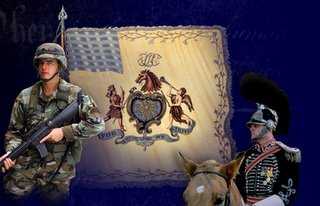
|
| First Troop, Philadelphia City Cavalry (FTPCC) |
On 23rd Street, just South of Market, stands a gloomy Victorian castle with big doors opening to the street. It's the armory, housing the First Troop, Philadelphia City Cavalry (FTPCC). The organization is a real fighting unit of the Pennsylvania National Guard, participating with distinction in every war America has fought. Originally a horse cavalry, the unit now drives tanks, except for recreation and on ceremonial occasions. It lays claim to being the oldest military unit in America, although there have been several minor name changes since the days when the City Troop accompanied General Washington to take command of the troops in Boston. Their dress uniforms are pretty splashy, especially on horseback, and they have to pay for them, themselves.
Furthermore, they are required to donate all of their military pay toward the upkeep of the unit and its activities. Although the first step in membership is to become a real member of the National Guard, election to the Troop itself is truly an election, carefully screened after prospective members have been observed and evaluated at invited Troop functions. These soldiers are wealthy, athletic, mostly pretty handsome, and almost invariably well-connected socially. You could almost make up the rest from these essential ingredients. This is the innermost core of Philadelphia society, and it is intensely and sincerely patriotic.
Others have noticed that National Guard duty itself takes up many weekends and much of summer vacation. Add to that the many Troop dinners, the horsemanship activities, the debutante balls, the Chesapeake sailing cruises, the national and local ceremonies, the weddings and funerals for members -- and actually fighting wars overseas. The members of the Troop spend so much of their time on Troop-related activities, that they become both intensely loyal to each other, and necessarily somewhat withdrawn from other people. They gravitate to polo, the Racquet Club, the Savoy, the Orpheus, and the financial world.
There may be an important insight into the generation turmoils to be derived from this. There was once a time when most professions likewise absorbed the lives of their members, with professional clubs and entertainments confining the social life of the member by leaving little time for anything else. But in recent years most occupational and professional societies are experiencing a loss of membership and enthusiasm, leading to the bewildering question of "Where are the younger members, any more?" The pre-fabricated answer is that younger people now want to devote their quality time to their families, but if you believe that, you will believe anything. Let's face it; when one activity absorbs all of your time, it confines you. There have to be some important benefits to being so confined, and even so, it chafes a little. Those of us who are not baby boomers can see that being a slave to intra-generational consensus is only to be a slave in a different way. The remarkable thing is that the baby boomers fail to see it, themselves.
Washington Lurks in Bucks County, Waiting for Howe to Make a Move
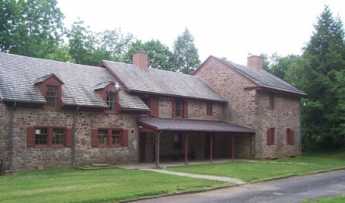
|
| Moland House |
Although Bucks County, Pennsylvania, is staunchly Republican, it has been home to Broadway playwrights for decades; this handful of Democrats have long been referred to as lions in a den of Daniels. One of them really ought to make a comic play out of the two weeks in August 1777, when John Moland's house in Warwick Township was the headquarters of the Continental Army.
John Moland died in 1762, but his personality hovered over his house for many years. He was a lawyer, trained at the Inner Temple and thus one of the few lawyers in American who had gone to law school. He is best known today as the mentor for John Dickinson, the author of the Articles of Confederation. Our playwright might note that Dickinson played a strong role in the Declaration of Independence, but then refused to sign it. Moland, for his part, stipulated in his will that his wife would be the life tenant of his house, provided -- that she never speak to his eldest son.
Enter George Washington on horseback, dithering about the plans of the Howe brothers, accompanied by seven generals of fame, and twenty-six mounted bodyguards. Mrs. Moland made him sleep on the floor with the rest.
Enter a messenger; Lord Howe's fleet had been sighted off Patuxent, Maryland. Washington declared it was a feint, and Howe would soon turn around and join Burgoyne on the Hudson River. Washington had his usual bottle of Madeira with supper.
A court-martial was held for "Light Horse Harry" Lee, for cowardice. Lee was exonerated.
Kasimir Pulaski made himself known to the General, offering a letter of introduction from Benjamin Franklin, which letters Franklin noted had been requested by Pulaski himself. As it turned out, Pulaski subsequently distinguished himself as the father of the American cavalry and was killed at the Battle of Savannah.
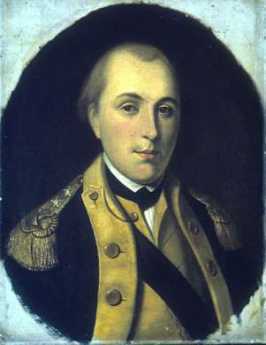
|
| Lafayette |
And then a 19 year-old French aristocrat, the Marquis de Lafayette, made an appearance. Unable to speak a word of English, he nevertheless made it clear that he expected to be made a Major General in spite of having zero battlefield experience. He presented a letter from Silas Deane, in spite of Washington having complained he was tired of Ambassadors in Paris sending a stream of unqualified fortune hunters to pester the fighting army. Deane did, however, manage to make it clear that the Marquis had two unusually strong military credentials. He was immensely rich, and he was a dancing partner, ahem, of Marie Antoinette.
In Mrs. Moland's parlor, Washington sat down with Lafayette to tap-dance around his new diplomatic problem. It was clear America needed France as an ally, and particularly needed money to buy supplies. But it was also clearly impossible to take a regiment away from some American general, a veteran of real fighting, and give that regiment to a Frenchman who could not speak English and who admitted he had no military experience. Fumbling around, Washington offered him the title of Major General, but without any soldiers under his command, at least until later when his English improved. To sweeten it a little, Washington seems to have said something to the effect that Lafayette should think of Washington as talking to him as if he were his father. There, that should do it.
It seems just barely possible that Lafayette misunderstood the words. At any rate, he promptly wrote everybody he knew -- and he knew lots of important people -- that he was the adopted son of George Washington.
Well, Broadway, you take it from there. At about that moment, another messenger arrived, announcing Lord Howe at this moment was unloading troops at Elkton, Maryland. General Howe might have been able to present his credentials to Moland House in person, except that his horses were nearly crippled from spending three weeks in the hold of a ship and needed time to recover. Heavy rains were coming.
(Exunt Omnes).
Suggested Stage Manager: Warren Williams
Doylestown
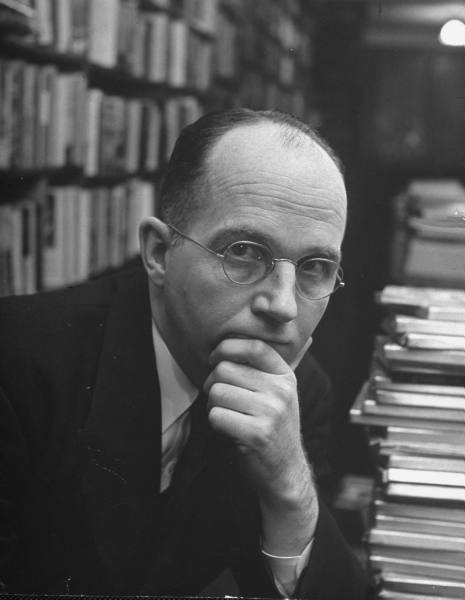
|
| James Michener |
Caught between the expansion of two metropolitan areas, Bucks County is inevitably doomed to extinction as a culture. Chester County and Bucks are in similar situations, as the suburbia devours exurbia, in this case, the Quaker farm communities. So you better go have a look, while they still survive to some degree.
The political unit of the area has been the county, and the county seat is in Doylestown, population about 8000. Within a few decades, it seems safe to predict the county population will approach a million. The town has lots of pride in itself and is just as cute as any town could possibly be. New Castle, Delaware has been preserved with the same pride but is uniform of a single period of architecture; Doylestown is a carefully preserved jumble of styles and periods, sizes and shapes. Like Princeton, NJ, and Odessa, DE, it is so attractive it brings hordes of visitors, which in turn quickly strangle it with traffic and lack of available parking space. There is an attempt to rescue the town with a by-pass highway, and blessings on the attempt. But the problem for these exurban jewels is not that people want to go around them, the problem is they are the main destination.
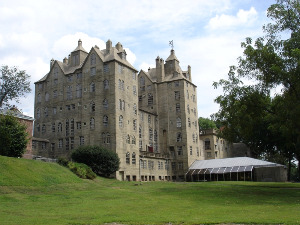
|
| Mercer Museum |
Doylestown was created in 1745 when William Doyle built a tavern at the crossroads. The county seat brings the courthouse with eleven judges and who knows how many lawyers, and the hospital. Henry Chapman Mercer brought three astonishing buildings, his 44-room mansion on 70 acres in the center of town, his famous Mercer tile factory in his back yard, and his multi-story museum of tools and crafts. All three of Mercer's buildings are made of concrete, built by craftsmen and himself with essentially unlimited personal funds derived from fabric manufacture in New England. And then this last bastion of the crafts movement embraced the artist colony established by Redfield at New Hope, and both of them attracted all those rich Broadway stars and publishing moguls. Right in the center of town, the Mercer crafts museum sits across the street from the James A. Michener Art Museum, small but very tasteful, the museum home of the Pennsylvania Impressionist school of art. The essence of this style is a smooth careful background, overlaid with quick thick foreground brushwork, producing a strong three-dimensional effect.
Schoolchildren in buses delight in the dolls house aspects, tourists admire the very fine art, everybody likes the cute little jumble of well-preserved eclectic buildings. It's all in a setting of Quaker farmhouses for the time being, but the split-levels and the McMansions by the thousands are coming. Visitors throng to see, and the residents are proud of what they have. But, really, does everybody have to bring his car?
Early Germantown-Music
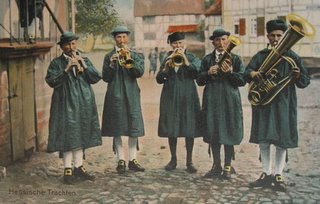
|
| German Brass Band |
What we now call Germany was a collection of small principalities until Bismarck unified the country in the Nineteenth Century. That probably accounts for the several different traditions of German Music, ranging from Oom-pa-pa brass bands to Wagnerian Opera. In addition, there were several waves of German immigration into Pennsylvania, each one of which had its favorite musical style of the moment, which then persisted as a tradition in some pocket of immigrant descendants. Germans in Germany would, therefore, relate a somewhat different history of musical evolution than Americans of German descent would recognize.
The intellectual German Quakers who settled into Germantown in the Seventeenth Century were highly musical, while the English Quakers down the hill in Philadelphia distinctly were not musical at all. There was a central musical feature to the Germantown hermit monks under Johannes Kelpius, their leader, who was a musician of some note. The printing and publishing houses of Germantown spread this music up and down the inland valleys of the Atlantic Coast region so that even after Germantown itself ceased to be the cultural center of things, the Ephrata Cloister carried on. The present center of 18th Century German music is now in the Lehigh Valley. Although Johann Sebastian Bach had been dead for a hundred fifty years before it was founded, the Bach Choir of Bethlehem now conducts the oldest continuous Bach Festival in existence. It's well worth the short trip to Bethlehem if you can get tickets, and more importantly, if you can find a place nearby to park.
Friends of Boyd
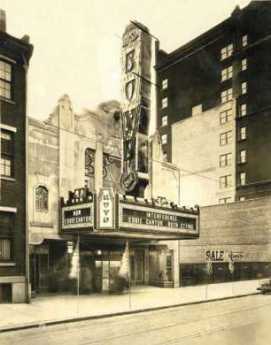
|
| Boyd Theatre |
Howard B. Haas a lawyer, and Shawn Evans an architect, are captains of a team trying to "save" the old Boyd Theatre at 1908 Chestnut Street. Since Clear Channel, the present owner has invested $13million in the property, and the preservationists agree that renovation of the movie palace to all its former glory would cost between $20million and $30million more, it's easy to understand why every other movie palace in central Philadelphia has been demolished. Furthermore, that area of town is having a resurgence of high-rise construction, so one use of the property must be balanced against others.
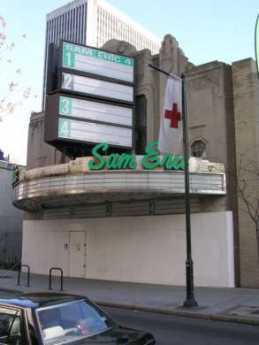
|
| Sam Eric |
The Boyd was built in 1928, just before the stock market crash, and closed in 2002. In fact, it changed its name to SamEric in its dying days, but the public remembers it as the Boyd, one of ten movie palaces in center city. The definition of a "palace" is arbitrary but is generally taken to be a theater with more than a thousand seats, normally with hyperbolic architecture to fit its hyperbolic advertising. Scholars of the matter say the earliest movie houses were constructed in Egyptian style, soon evolving into French Art Deco. Ornate, whatever it's called.
The palace concept developed in the era of silent films, with subtitles. Anyone who has experimented with home movies knows that the silent film sort of lacks something, particularly between reels and at times of breakdown in the projection. That's why brass bands played on the sidewalk outside, pipe organs played during intermissions, and all manner of vaudeville appeared on stage. Sound movies, or talkies, were immediately much more popular when they appeared in 1927, and had less need of the window dressing from other distractions which had grown into a moviehouse tradition which was slow to die.
The movie studios owned the films and soon built theaters to display them. The movie business was quite profitable from the start, so studios had the necessary finance to spread a network of very large theaters across the country quickly. The ability to concentrate hyped-up advertising with immediate display of the product in large captive theaters tended to drive the model of the "palace", which was able to sustain higher ticket prices than trickling a larger number of film copies to myriads of small "mom and pop" local theaters. In very short order, going downtown to see movies became at one time the largest reason for suburbanites to go to the center of town on public transportation, fitting in nicely with the concentration of huge department stores, also located there. Restaurants, bars, bowling alleys, and shops grew up to address the crowds. Furthermore, the economic depression of the 1930s slowed down what was to become a relentless automobile-flight to the suburbs. After the spread of free television at home in 1950, the downtown movie palaces were doomed. The legal profession helped, too. Small suburban theater operators eventually won an antitrust suit against what they described as monopoly power of studio-owned center city palaces, so a host of small sharks in the suburbs started to eat the whales downtown. Furthermore, the sound quality was easier to achieve in a smaller auditorium. To tell the truth, fire hazard was also lessened without the arc-lamps needed to project images across a long distance.
So, a new technology interacting with an old theatrical tradition quickly created the movie industry in its downtown movie palace form; more advancing technology quickly destroyed it, with a little help from economics and politics. Good luck to the friends of this historical epoch, who have a monumental task ahead to work up the public nostalgia and political strength required to overcome a huge economic obstacle of the "highest, best use of the land". In many ways, the most valuable contribution of this movie palace restoration movement is to dramatize in the public mind just how urban centers function. Department stores are gone, going in town to the movies is over. How else are you now going to get the couch potatoes to go downtown voluntarily, and often? Just imagine ten palaces simultaneously filling up with several thousand suburbanites apiece, seven nights a week. Without those additional drawbacks on ample display in Atlantic City and Las Vegas, please.
WWW.Philadelphia-Reflections.com/blog/1190.htm
Home of the U.S. Naval Academy
Gray's Ferry, the first non-swamp ground as you come up the Schuylkill, is the oldest part of Philadelphia, and one of the saddest. This was the place where Washington and the other Southern delegates came to the Continental Congress along the main North-South route of the Colonies. John Bartram's gardens are nearby, and Andrew Hamilton's mansion. But things are in a sorry state nowadays, and neighborhood residents believe it is unsafe even to drive through there. Of all the areas in the city, this one cries out most for rehabilitation.
Well, Toll Brothers, the mass builders, are doing something there. Almost any construction, or any demolition, would seem like an improvement. But you have to hold your breath when you see bulldozers in the old Naval Home, a large and stately building along the river, hidden behind a long wall. Some pretty old and historic buildings are in danger of being torn down.
This was, for example, the original home for six years, of the United States Naval Academy. You know, the one that is now at Annapolis. Doesn't anyone care?
Laurel Hill
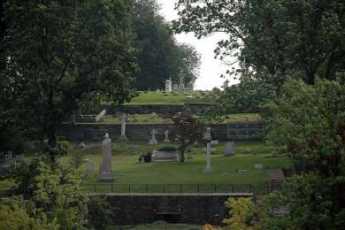
|
| Laurel Hill Cemeteries |
There are two Laurel Hill Cemeteries in Philadelphia, sort of. Although both are described as garden cemeteries, the older part in East Fairmount Park is more of a statuary cemetery or even a mausoleum cemetery. When its 74 acres filled up, the owners bought expansion land in Bala Cynwyd, which could come closer to present ideas of a memorial garden. Particularly so, when the older cemetery area started to fill in every available corner and patch and began to look overcrowded. The name was used by the Sims family for their estate on the original area. Since June-blooming mountain laurel is the Pennsylvania state flower and a vigorous grower, it seems likely the bluff overlooking the Schuylkill was once covered with it. Somehow the May-blooming azalea has become more popular throughout the region, particularly in the gardens at the foot of the Art Museum. If extended a little, merged with laurel on the bluff, and possibly with July-blooming wild rhododendron, there might someday arise quite a notable display of acid-loving flowering bushes from the Art Museum to the Wissahickon, continuously for two or three months each spring.
There are interesting transformations in the evolving history of cemeteries, best illustrated in our city by the traditions of the early Quakers when they dominated Philadelphia.
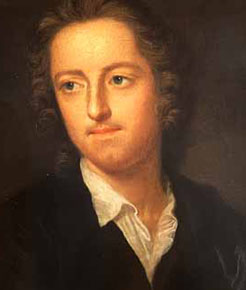
|
| Thomas Grey |
Objecting to the ornate monuments which Popes and Emperors erected for their military glory, and probably to the aristocratic custom of burying important people inside churches where they could be worshiped along with the stained-glass saints, early Quakers were reluctant to mark their own graves with headstones, or even to have their names engraved on such "markers". By contrast with the splendor accorded aristocrats, the common people in Europe were largely dumped and forgotten, providing an unfortunate contrast. During the early part of what we call the romantic period, Thomas Gray popularized these attitudes in Elegy in a Country Churchyard. To be fair about it, the early Christian Church had a strong tradition of collecting the dead of all classes into catacombs. The Romans were quite reasonably upset by the potential for spreading epidemics through people living within such arrangements, although feeding the Christians to the lions seems like an overreaction.
At any rate, and to whatever degree the French Revolution was what shattered previous traditions, the Victorian or romantic period produced a new vision: garden cemeteries in Paris.
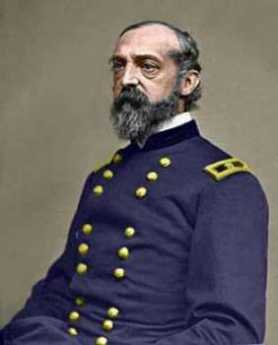
|
| George Mead |
The concept soon spread to Laurel Hill, and thence to the rest of America. Acting with what probably had some commercial motivation, cemeteries then moved away from churches to suburban parks, promoted as places of great beauty in which to stroll and hold picnics, perhaps to meditate. The private expense was not spared in statues and mausoleums, which often became display competitions between dry goods merchants and locomotive builders. Revolutionary heroes were dug up from their original graves and transported here to be more properly honored, as were some private persons whose descendants wished for more suitable recognition than conservative church rectors had offered. The Civil War created the staggering number of 632,000 war dead; based on the proportion of the population, that would be equivalent to six million in today's terms. Since they were almost all male, there must have been at least a half-million surplus women as a consequence. The nation and this almost unbelievably large cohort of single women had an impact on society for thirty or forty years after The War. Eventually, this would lead to colleges for women, suffrage and other forms of feminism, but the initial manifestations of what we now call Victorianism took the form of formalized grief, particularly the 75 National Cemeteries of crosses row on row. But private initiatives also took a variety of forms, including Laurel Hill's statuary to honor the valor of the fallen, ranked by the number of generals buried there and visits by sitting Presidents of the United States. Laurel Hill, East, holds 42 Civil War Generals. It will be recalled that Lincoln's Gettysburg Address was delivered at a much larger final resting place for fallen soldiers, but Laurel Hill had the generals, including George Gordon Meade, himself. It is probably significant that Laurel Hill West, three times as large, was opened in 1867. At the headstone of each Civil War veteran is found a metal flag-holder, put there by the Grand Army of the Republic and marked with GAR surrounding the number 1. This is the home of Post Number One, the Meade Post, the original home of this organization responsible for many patriotic movements like the Pledge of Allegiance and commemorative reunion encampments and reenactments. The main purpose of the war was to preserve the unification of a continental nation, and the GAR sought to raise patriotic consciousness to a point where fragmentation would never again be conceivable.
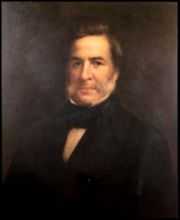
|
| John Notman |
Two names stand out in the history of these cemeteries, Notman and Bringhurst. John Notman was one of the early architects who fashioned the look and feel of Philadelphia. His identifying feature is brownstone, as seen cladding the Athenaeum building on Washington Square, and St. Marks Episcopal Church at 15th and Locust. At Laurel Hill, the main entrance confronts a brownstone sculpture by Notman of "Old Melancholy", depicting a typical Victorian romantic vision; just about all other monuments in the cemetery are either of acid rain-eroded marble or indelible granite. Brownstone from Hummelstown PA provided the characteristic look of New York residential architecture during this era. Philadelphia brownstone probably came from the same place. The other name is Bringhurst, dating back to 17th Century Germantown, long associated with the underlying sanitary purposes of the cemetery. The family finally and gladly sold the undertaking business a few decades ago.
Somehow, the image of cemeteries has now transformed from public places of meditation and reverence to places that are "spooky". Their greatest surge of visitors, these days, occurs at Halloween.
Lindbergh Boulevard
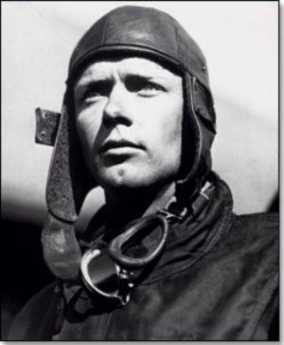
|
| Charles Lindberg |
As Charles Lindbergh was getting ready to fly to Paris, one of the Guggenheim family remarked to him "Look me up when you get back from Paris". That was a joke; he never expected to see Lindbergh alive again.
But Lindbergh was on a roll when he got back, and paid a visit to Guggenheim. Together, they cooked up the idea of a public relations tour to promote aviation. Lindbergh would fly to every one of the 48 states, and make a speech. One of the places visited was Philadelphia, which had a new airport to promote. So, a road was renamed in Lindbergh's honor, leading from the airport to Bartram's Garden, formerly 54th and Elmwood.
Main Line School Night
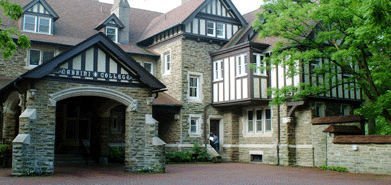
|
| Radnor |
There's a lot to learn from the Main Line School Night, and it isn't all taught in the classroom. The basic idea is life-long learning, going to school because it's fun. The idea started five or six decades ago in the Radnor, PA high school, that a lot of educated people wanted to become still more educated in topics of their own selection. No tests, please, and forget about academic credits; most of the students already have an excess of them. Forget about improving your income with advanced degrees; since this is Main Line Philadelphia, quite a few of the students already have all the income they could ever want. As related by the very low-key president of MLSN, David Hastings, the idea was an almost instant success. There were 1200 students enrolled for the second semester. They outgrew the original high school, and now teach courses in seven schools among 40 locations, to 14,000 students a year. There are 400 teachers in any given year, and the tuition charged is aimed at breaking even on the overhead. The academic world is inclined to say the courses lack rigor, by which is partly meant that if the students don't like the course, they walk out. Volleyball, yoga, and nutrition certainly do have a California sound, but computers, foreign languages, and science can be as difficult as you want to make them. If you get serious about contract bridge, you soon learn that isn't a simple child's game. Courses in wine tasting are given in the local senior citizens' retirement communities, but mostly not to the residents. It's not welcome to give that sort of course in a high school. To some extent, this continuing education is an exclusive social occasion, but then so is a course in diplomatic history at Princeton. Mr. Hastings tells of a group of sixteen ladies in a bridge course who have been coming for years, and have learned to close the course rolls by all sending in their checks on the day of registration. This is, after all, the Main Line where exclusionary techniques once learned are hard to forget. There are clouds on the horizon. In the past three years, enrollment has leveled off and declined a little. Almost no major corporation continues to be successful for more than seventy-five years, and many of the people running Main Line School Night are drawn from the Executive Service Corps. In retrospect, for example, the owners and editors of the Saturday Evening Post should have sold out and closed down, as soon as they learned the first million television sets had been sold. Perhaps the decline of enrollment of Main Line School Night reflects the advent of the Internet, or the cell phone, or some other new technological competitor. Or maybe the venture just got too big and successful to maintain its original format; perhaps it's outgrowing its blood supply. But anyway, they have 14,000 students and can be proud to be in a resting phase, when the rest of the city, or state, or country, hasn't even tried to get started on such a project.
Military School
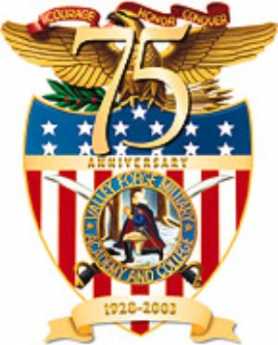
|
| VFMS Crest |
In the middle of the pacifist Quaker farm region, in fact in the middle of William Penn's Quaker Welsh Barony, sits Valley Forge Military Academy. Its location seems even stranger when you consider the nearest town, within easy walking distance, is Wayne, PA described by David Brooks in Bobos in Paradise as the East-Coast epicenter for yuppie education-based elitism, with all its air of entitlement. In fact, Brooks does not mention the Academy once in his three hundred page book about the town. What is VFMA and why is it located where it is? Three names, Baker, Mellon, and Annenberg pretty much explain it. Lieutenant General Milton Baker, a great friend of the Eisenhower family, was passionate about Valley Forge, its history, its parks, its military hospital, its renovation, and its preservation. If Baker founded a school (in 1928), it was going to be here. The money was Mellon and Annenberg money, but Baker was their man.
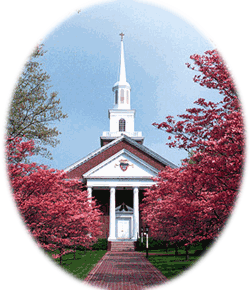
|
| Military school |
Military schools are now in a period of decline. A flurry of a building after the Civil War created about 600 of them, in recognition that the North nearly lost the Civil War to the Confederate States who had a much stronger military tradition, especially in Virginia. It's therefore not surprising that Valley Forge wanders from Southern traditions, and is consciously modeled after Sandhurst, the British Royal Military College. Valley Forge competes with Canada, Australia and Great Britain for foreign students, while the Southern schools are more provincial. There seem to be two main reasons to send your son to a military boarding school.
The first is the tradition of military aristocracy, traceable in a sense to feudalism and the Knights of the Round Table. There's little patience with a politically correct speech in the military, who readily tell you that many rich families encourage their daughters to marry career military officers, as a way of strengthening loyalties between these two power groups. During the formative years of the American republic, the resounding emphasis was placed on having no standing army. That was a cloaked way of restraining a military aristocracy and seems to have provided the main reasoning behind the constitutional Second Amendment, which projects a general right of all citizens to bear arms. It follows the model of Switzerland where military service is universal, as contrasted with limiting firearms to specialists, whether police or military. If that was the goal, it seems to have been effective; military elites now seem most appealing to foreign cultures, like Latin America, Korea, Saudi Arabia. Tony DeGeorge, the current president of Valley Forge, tells of an astounding phone call from one Saudi prince, who responded to an alumni fund-raising appeal by offering to buy the whole school. The Saudi noticed one supposes, that "Storming' Norman" Schwarzkopf, the hero of the First Gulf War, was an alumnus of Valley Forge.
The other main reason to send your son to military boarding school, is because he's too unruly to handle at home. Here is another seemingly delicate matter the school makes no bones about. All new entrants must spend six weeks as "plebes", enduring a ferocious hazing discipline that weeds 'em out. The solution to cell phones and Internet games is to forbid them. Valley Forge confronts the matter of recreational drugs head-on. All students are subject to random drug testing, and a positive test means get off the school grounds -- permanently -- within four hours. The exercises program is not only mandatory, but it is also rigorous beyond description. The result is that fifteen alumni are currently playing professional football in the NFL, the polo team is regularly the national champion. Somewhere General Baker got the idea that playing music helps your mathematical ability, so every single 9th grader plays the violin. The marching band is internationally famous, and by gad, it better stay that way. Only about a third of the graduates go on to a lifetime military career, but another third of the alumni are CEOs of companies. Even what happens to the remaining third bears some thought.
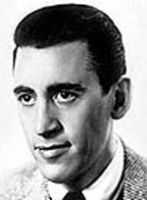
|
| J.D. Salinger |
J.D. Salinger and Edward Albee were both alumni of Valley Forge Military Academy. True, General Baker told Salinger that The Catcher in The Rye was rubbish, and one need not speculate much on how he would have reviewed Who's Afraid of Virginia Woolf? Nevertheless, it cannot be denied that the collision between these two social misfits and the plebe hazing experience contributed significantly to the depth and power of the serious literature they produced. It is not easy to name two alumni of Andover, Exeter or Lawrenceville who have contributed as much to 20th Century American fiction. Salinger and Albee hated the place, but it made them what they became. "Whatever that was," you can almost hear the other two-thirds of the alumni mutter.
In a day that echoes No Child Left Behind, it is a little hard and it is certainly politically incorrect, to give this devil its due. But all Armies live by the slogan, that if you must take an objective, you must take some casualties.
Religion at Girard College:Spiritual But Irreligious
According to Cheesman A. Herrick, "After Girard had dictated that famous section of his will excluding clergymen and William J. Duane had written it down, Girard asked Duane what he thought of it. Duane, being quite unprepared for the question, and somewhat at a loss to interpret the section, answered, ' I can only say now, Mr. Girard, that it will make a great sensation.' To this Girard replied, ' I can tell you something else it will do -- it will please the Quakers.'"
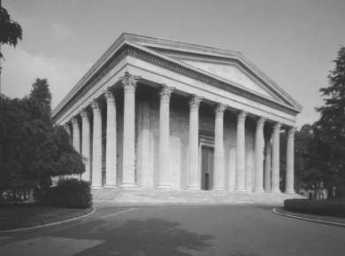 |
| Stephen Girard College Founders Hall |
In the Western part of America, Quaker meetings sometimes do have paid ministers, but the Philadelphia Yearly Meeting and it is component monthly meetings have held steadfastly to the tradition of "unprogrammed meetings"-- without ministers. Girard was not a Quaker, but he greatly admired them, and three of the five executors of his will were Quakers. It, therefore, seems likely, at a minimum, he hoped that Quaker sentiment would fortify his intended banishment of clergymen from his school for orphans, and he might well have got the basic idea from them. Quakers have long noted with disapproval that paid ministers have often publicly supported wars, and Quakers notice that governments waging wars have typically sought to stir up warlike feeling by persuading ministers to help them do so. Another behavior which is almost inherent in the clergy is for ministers to feel that they are measured by the size of the congregation they attract, and hence almost invariably proselytize for new membership. Girard had firm ideas about influencing impressionable orphans, and he did not wish to have outside ideologies capture the administration of the school. 1830 was an evangelical time, and Girard could easily imagine some highly charismatic minister captivating the school.
Other motives may, of course, be imagined. This is what is actually in the will:
Prohibiting any ecclesiastic, missionary or minister of any sect from holding or exercising any station, no such person should ever "be admitted for any purpose or as a visitor, within the premises occupied by the College...I do not mean to cast any reflection upon any sect or person whatsoever, but inasmuch as there are such a multitude of sects, and such a diversity of opinion amongst them, I desire to keep the tender minds of the orphans free from the excitements which clashing doctrines and sectarian controversy are so apt to produce." As matters were to turn out, religious meetings have been conducted by laymen almost every day at the College, and the custom grew up that the boys themselves were often called upon to conduct religious meetings. A great many graduates of Girard College eventually went on to careers in religious ministry, so it even seems likely that their experience at the school had the effect of interesting them in the ministry by giving them a taste of it.
In 1844, the numerous relatives of Stephen Girard tried to break the will. No one has seriously proposed their grievance was anything but financial. However, they sought the services of the most noted lawyer, orator, and statesman of his day, Daniel Webster. Webster would have been wise to refuse to take the case since he could think of no better argument to use than that -- the exclusion of ministers demonstrated the school for orphans was not a true charity, and only a true charity would be allowed to exclude ministers. Several days of oratory enveloped this preposterous argument, which today reads like pure bombast and humbug. The U.S. Supreme Court in time unanimously rejected his brief, with the generous comment that the law was not on his side. Other lawyers have privately remarked that such oratory was never intended to persuade a court, but to impress a rich client.
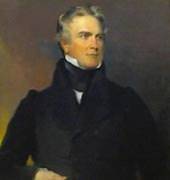 |
| Horace Binney |
Horace Binney, the lawyer son of another Horace Binney who established an enduring reputation for calmness in midst of a religious storm during the Hogan Schism, was the successful defender of Girard College. In contrast with the flowery reverberations of Webster's voice, Binney confined himself to short words in short sentences, sticking strictly to the point without appeal to emotion. In fact, one wonders why Webster stooped to it. Historians credit him for the arguments that later inspired the defenders of the Union with enough conviction to win the Civil War. Essentially, he convinced Unionists that the Constitution had not created a confederacy, but a Union, which implicitly must have all the powers needed to preserve itself. Half the nation would not accept his reasoning, however, and his willingness to proclaim nonsense in the Girard case confirmed many Southern suspicions that the Union argument was also specious. Fifteen years later, Philadelphia was quite slow in coming to the Union side, for a variety of reasons. His attacking a cherished Quaker belief in a Quaker city was certainly not useful. In time, it would be possible to hear a quiet parody of the Union's marching song, that "He died to make men holy -- we will kill to make men free."
 |
| Advice to Young Men and Boys |
It is unfortunate that the one thing most people think they know about Girard College is that religion is excluded. Far from it, there is more attention to morals and ethics than in public schools. Indeed, Girard College compares well with Phillips Exeter Academy, Webster's prep school and perhaps his model. One of the great concerns about orphans is that they may be easily led into a life of crime; there is no doubt that Girard College makes unusual efforts to keep that from happening. In fact, the school may be said to have written its own prayer book during the late 19th Century. Books of devotion were written and then organized by committees of laymen, eventually published by the Chairman, Benjamin B. Comegys. Entitled Advice to Young Men and Boys", Comegys notes that the book was published "in the hope that it may be the means of helping some boys and young men other than those to whom the Addresses were made." It would have to be observed that Girard College inspired an unusual interest in the ministry among the boys, by encouraging them to lead in the ceremonies themselves. And by having the Board of Trustees participate in the construction of books of moral principles, they no doubt similarly evoke a high sense of fidelity within the businessmen trustees. Since those entrusted with huge amounts of money are faced with huge temptations, the Trustees quite possibly need the stimulus as much as the students do.
REFERENCES
| Girard College It's Semi Centennial of Girard College: George P. Rupp ASIN: B000TNER1G | Amazon |
Skating and Humane
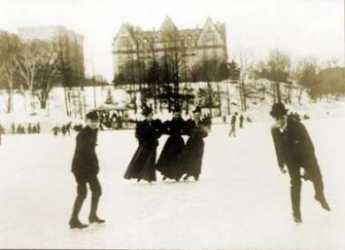
|
| Outdoor Ice Skating |
There was a time when ice skaters and rowing enthusiasts were having a little war on the Schuylkill, and the rowers won. We are indebted to our dear friend the late Elmer Hendricks Funk MD, a past president of the Philadelphia Skating and Humane Society, for some of the history.
Ice skating is both dangerous and seasonal. In the Eighteenth Century, ice skating was concentrated near the center of population on the Delaware River, and that's where you found the Skaters Club. You also found the Humane Society, whose main function was to pull drowning skaters out of the water. The Humane Society got to be quite rich because people were inclined to be sympathetic to lifesavers. In time, however, people moved away from Delaware and the two clubs, Skating and Humane, merged. No doubt the skaters thought they would be acquiring the substantial endowment of the life-saving club, but in fact, the Pennsylvania Hospital got most of the money in one of those genteel struggles that volunteer organizations sometimes get into. Skating moved from Delaware to the Schuylkill, and the club built a little house on what is now boathouse row, right next to the lighthouse.
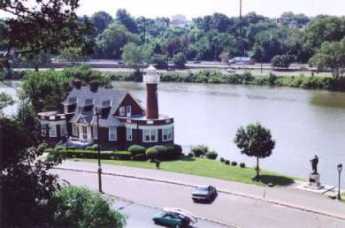
|
| Turtle Rock |
The lighthouses at Turtle Rock was useful for the southern terminus of the canal just across the river on the West Bank, and for many years there was a little canal house on the Westside, making it easier to see what this was all about. The lighthouse became incorporated into a boathouse for the first women's rowing club, but the club died out and this combined, Sedgley, is now a women's luncheon club. Next door was the Skaters and Humane, fighting to survive among all the rowers. Since rowing has a much longer season than skating, the skaters feared they would be overwhelmed. They passed a club by-law that no officer of the club could be a rower.
However, the skaters had another enemy in the ice companies, who tended to chop up the first and best ice to form in the area. And the final blow came when the Arena was built at 45th and Market Street with artificial indoor ice. So, the boathouse became the home, in 1938, of the Philadelphia Girls Rowing Club, and the skaters and lifesavers moved first to the Arena, and then to Ardmore. Haverford College was glad to sell them a swamp they owned there since it wasn't much good for a college but the local springs provided needed water for the skating rink. With a rink, skating became year-round, and there was a roof to protect against snow and rain. You can't fall through the ice in a rink.
The club had a number of lucky breaks by being first, constructing its building cheaply in the depression, being able to use ammonia as a refrigerant, and getting cheap land. There are other skating clubs, but few of them own their own rinks, and no other skating club has the national prestige of the Philadelphia Skating and Humane Society. It is the oldest, the first, the best, and the most famous. If you are anybody in skating, this is where you want to skate.
To Germantown: A Short Appreciation
A breezy summary of European geopolitics, including many rough inaccuracies, will probably irritate residents of that region but may help Americans understand the history and composition of the Germantown area of Philadelphia.
The Western World was long defined as a province of Rome, and all roads led there. At the top of the Italian boot can be found the Swiss Alps, forcing Romans to go around through what is now Provence in France. An old jingle defines the river system of Switzerland as " The Rhine, the Rhone, Danube, and Poa rise in the Alps, and away they go!"
So northward-bound Romans, Caesar and all, went West around the Alps up to the Rhone Valley, and eventually came upon the Rhine River flowing north to Rotterdam, just across the English channel from London, or Londinium as they called it. The crossover between the Rhone and the Rhine was at Strassbourg where the European Parliament now meets. For two thousand years, the main highway from Rome to London was the Rhine River.
Essentially, everybody to the West of the Rhine was Roman Catholic, and everybody to the East of the river was Protestant. At least, that was true in the Sixteenth Century. The head of the river in Switzerland was Calvinist Protestant, and the mouth of the river in Holland was Reform Protestant. Along the main part of the river, Alsace, Lorraine, Palatine, Luxembourg, divided East and West but for centuries pieces of land shifted control back and forth. The reformation movement started by Martin Luther ended up as the Thirty Years War, from which the region took another hundred years to recover, and more hundreds of years to forget and forgive. You might call it a religious Mason-Dixon line, remembering of course that the American Civil War was mostly fought on the Potomac, not the Mason Dixon.
Professional soldiers teach Military students that there is no war worse than a religious war. Lots of people, probably thousands, were burned at the stake during the religious wars along the Rhineland. Rape and pillage were common Partee. And so, if you lived in a little farming village in this region, and some Englishman named William Penn came around with an offer to emigrate to his peaceful kingdom in America, it sounded wonderful. Religious toleration was an important part of the attractiveness, and nowhere to be found in Europe.
William Penn's mother was Dutch. It is likely he spoke the local languages. For a number of years he had traveled in the Low Countries and the Rhineland, preaching the ideas of George Fox the Quaker. And then, one day he arrived with a new idea. The King of England had given him a huge stretch of uninhabited land in the New World, no doubt influenced by the idea that Quakers were a nuisance and this was a good way to get rid of them. Whatever. Penn was selling land grants, and he could be trusted. Why not give it a try?
Germantown Before 1730
In 1730, there was a great influx of German peasantry to America, stimulated by the English government giving bounties to ship captains who would help fill the country with settlers. Protestants only, of course, so the ships were forced to land in England on the way, so Catholics on board could be returned to Europe. The majority of these ships landed in Philadelphia, but one group of thirty families did land in New York where they found the Dutch inhabitants had maintained their dislike of those sects from upriver on the Rhine. Both the Calvinists and the Dutch Reformed were interested in religious freedom, but both were uninterested in religious toleration. The thirty German families then went up to the Hudson to Albany, were treated badly there, too, and eventually cut their way through eighty miles of forest to the headwaters of the Susquehanna at Coopertown, New York. From there they floated down that river to the backwoods of Pennsylvania and started a colony in what is now called the Pennsylvania Dutch country.
The flood of German immigrants into Philadelphia after 1730 soon made Germantown German. From 1683 to 1730, however, Germantown had been settled by Dutch Quakers and some Swiss ones. These earlier immigrants were townspeople of the artisan and business class, rapidly establishing Germantown as the intellectual capital of Germans throughout America. This eminence was promoted further by the establishment by the Rittenhouse family (Rittinghuysen, Rittenhausen) of the first paper mill in America. Rittenhousetown is a little collection of houses still readily seen on the north side of the Wissahickon Creek, with Wissahickon Avenue nestled behind it. The road which now runs along the Wissahickon is so narrow and windy, and the traffic goes at such dangerous pace, that many people who travel it daily have never paid adequate attention to the Rittenhousetown museum area. It's well worth a visit, although the entrance is hard to find (try coming down Wissahickon Avenue).
Even today, printing businesses usually locate near their source of paper to reduce transportation costs. North Carolina is the present pulp paper source, before that it was Michigan. In the Seventeenth and Eighteenth centuries, a paper came from Germantown, so the printing and publishing industry centered here, too. When Pastorius was describing the new German settlement to prospective immigrants, he said, " Es ist nur Wald" -- it's just a forest. A forest near a source of abundant water. Some of the surly remarks of Benjamin Franklin about German immigrants may have grown out of the competition from Christoper Sower (Saur), the largest printer in America.
Francis Daniel Pastorius was sort of a local European flack for William Penn, assembling in the Rhineland town of Krefeld a group of Dutch Quaker investors called the Frankford Company. When the time came for the group to emigrate, however, Pastorius alone actually crossed the ocean; so he had to return the 16,000 acres of Germantown, Roxborough and Chestnut Hill he had been ceded. Another group, half Dutch and half Swiss, came from Krisheim (Cresheim) to a 6000-acre land grant in the high ground between the Schuylkill and Delaware. The time was 1683. They were soon joined by Mennonites, followers of Menno Simons, a reform group similar to Quakers but a hundred years older. The truly Dutch origins of these original settlers give an additional flavor to the term " Pennsylvania Dutch".
Where the Wissahickon crosses Germantown Avenue, a group of Rosicrucian hermits created a settlement, one of considerable musical and literary attainment. The leader was John Kelpius, and upon his death the group broke up, many of them going further west to the cloister at Ephrata. From 1683 to 1730 Germantown was small wooden houses and muddy roads, but there was nevertheless found the center of Germanic intellectual and religious ferment. Several protestant denominations have their founding mother church on Germantown Avenue, Sower spread bibles and prayer books up and down the Appalachians, and even the hermits put a defining Germantown stamp on the sects which were to arrive after 1730. The hermits apparently invented the hex signs, which was carried westward by the more agrarian later German peasant immigration, passing through on the way to the deep topsoil of Lancaster County.
Germantown After 1730
The early settlers of Germantown were Dutch or German-speaking Quakers; they were also of the craftsman class. Consequently, they were rather poor subsistence farmers. With a whole continent stretching beyond them, professional farmers would not likely choose to settle on a stony hilltop, two hours away from Philadelphia. Their future lay in a religious congregation, in papermaking, textile manufacture, publishing, printing, and newspapers. Plenty of stones were lying around, so stone houses soon replaced the early wooden ones. Since Philadelphia in 1776 had only twenty or so thousand inhabitants, and only thirty wheeled vehicles other than wagons, it was not too difficult for Germantown to imagine it might eventually eclipse the nearby English seaport. Two wars and two epidemics brought those dreams to an end, but in a sense, those calamities were stimulants to the town, as well.
In 1730 the German peasants began to arrive in large numbers from the Palatinate section of the Rhine Valley. While it is true they arrived as survivors of a horrendous ocean sailing experience, packed in such density that it was not unusual to find dead bodies in the hold that had only been supposed to have wandered into a different part of the ship. Quite often, they paid for their passage by selling themselves into what amounted to limited-time slavery, and the usual pattern was for parents to sell an adolescent child into slavery for eight or ten years in order to pay for the voyage of the family. They were uneducated, even ignorant, and often were proponents of small new religious sects. But they were professional farmers, and good at it. They knew, and a quick tour of Lancaster County today confirms their belief, that if you had a reasonable amount of very good land, you could live a life that approached the craftsmen in comfort and usually far exceeded them in personal assets. They have taken a long time to rise from farm to sophistication, but the already sophisticated craftsmen in Germantown wasted no time in abandoning farming. The newcomers arrived in Philadelphia, made their way to the nearby town of Germantown, learned a little about the new country and the refinements of their Protestant culture, and then pressed on to the great fertile valley to the West. Some of them, of course, stayed on permanently in the steadily growing little metropolis on the hill.
During this period, Germantown also invented the Suburb. Benjamin Chew, the Chief Justice, built a magnificent stone mansion on Germantown Avenue. Present-day visitors are still impressed with the immensity and sturdy mass of his home. Grumblethorpe, Stenton and a score of other country homes were placed there. Germantown still wasn't a very big town, but it was plenty comfortable, quiet, safe, intellectual and affluent. The first disruption came from the French and Indian War.
Germantown and the French and Indian War
Present-day interest in the Constitution, the Declaration of Independence, and related issues tend to drown out what was once a lively interest in the French and Indian War (1754-1760) as the pivot of American colonial history. Benjamin Franklin was so important in the French and Indian War that he could have died in 1761 at the age of 48 and still be remembered as one of our most far-sighted and influential statesmen. He was, however, not a plaster saint. Little Germantown was peripheral to events in those days, little interested in what was happening in Quebec or Albany. Like Hamlet's schoolmates Rosencrantz and Guildenstern, however, the Germantowners got drawn into events they did not entirely understand and played an unwilling part in history.
The French and Indian War was mainly about control over the Ohio Valley. Having established a communications system running out of Quebec, and carefully placing forts in the area beyond the Allegheny Mountains from which to trade with and possibly convert the Indians, the French had a rather elegant strategy for controlling the center of the continent. It involved urging their Indian allies to attack and harass the English-speaking settlements along the frontier. It was a nasty business. The survivors of General Braddock's defeated army at what is now Pittsburgh reported hearing screams for several days as the prisoners were burned at the stake. Rape, scalping and kidnapping children were standard practice, intended to intimidate the enemy. The Scotch-Irish settlers beyond the Susquehanna, which was then the frontier, were never terribly congenial with the pacifism of the Eastern Quaker-dominated legislature. The fact is, they liked to fight, and gouging of eyes was almost their ultimate goal in a moral dispute. They had an unattractive habit of inflicting what they called the "fishhook" involving thrusting fingers down an enemy's throat and tearing out his tonsils. As might be imagined, the English Quakers in Philadelphia and the German Quakers in Germantown were instinctively hesitant to take the side of every white man in every dispute with a red one. For their part, the frontiersmen were infuriated at what they believed was an unwillingness of the Quaker-dominated legislature to come to their defense. Meanwhile, the French pushed Eastward across Pennsylvania, almost coming to the edge of Lancaster County before they were pushed back and ultimately defeated by the British.
In December 1763, once the French and Iroquois were safely out of range, a group of settlers from Paxtang Township in Dauphin County attacked the peaceable local Conestoga Indian tribe and totally exterminated them. Fourteen Indian survivors took refuge in the Lancaster jail, but the Paxtang Boys searched them out and killed them, too. Then, they marched to Philadelphia to demand greater protection for the settlers. Benjamin Franklin was one of the leaders who came to meet them and promised that he would persuade the legislature to give frontiersmen greater representation, and would pay a bounty on Indian scalps.
Meanwhile, Franklin was active in raising troops and serving as a soldier. He recognized that thirteen divided colonies could not easily mount a coordinated defense against the well-organized French strategy, and called a meeting in Albany to propose a united confederation. The Albany Convention agreed with Franklin, but not a single colony ratified the plan, and Franklin was disgusted with them. Out of all this, Franklin emerged strongly anti-French, strongly pro-British, and not a little skeptical of colonial self-rule. As a leader of a political party the Pennsylvania Legislature, he was very familiar with the tendency of the German Pennsylvanians to vote in harmony with the Philadelphia Quakers. It must be noticed that Franklin's main competitor in the printing and publishing business was the Sower family in Germantown. Franklin persuaded a number of leading English non-Quakers that the Germans were a coarse and brutish lot, ignorant and illiterate. If they could be sent to English-speaking schools, perhaps they could gradually be won over to a different form of politics.
Since the Germans of Germantown was supremely proud of their intelligence community, they were infuriated. Their response was almost a classic episode of Quaker warfare. They organized, off Market Square, the Union School, which was eventually to become Germantown Academy. Its instruction and curriculum were sufficiently outstanding to justify the claim that it was the finest school in America. Later on, George Washington was to send his adopted son (Parke Custis) to school there. In 1958 the Academy moved to Fort Washington, but needless to say, the idea of forcing the local ignorant Germans to go to a proper English school was rapidly shelved.
The Battle of Germantown: Oct. 3, 1777
After its brief commotion from the unwelcome reverberations of the French and Indian War, Germantown settled down to a period of colonial prosperity and quite vigorous growth. Most of the surviving hundred historical houses of the area date from this period, and it might even be contended that the starting of the Union School had been a beneficial stimulus.
Almost two decades passed. What we now call the American Revolution started rumbling in far-off Lexington and Concord, soon moved to New York and New Jersey. General William Howe, the illegitimate uncle of King George III, then decided to occupy the largest city in the colonies, considered getting his brother's Navy up Delaware but decided against a naval attack on the chain barrier blocking the narrow mudflats of the river at what is now The International Airport. Instead, he sent the navy down to Norfolk and back up te Chesapeake, landing the troops at the head of the Elk River. Washington was soon defeated at the Battle of the Brandywine Creek trying to head him off. So Howe invested Philadelphia, organizing his main defensive position in the center of Germantown against an attack by Washington that was soon to come. His headquarters were in Stenton and Morris House, General James Agnew was at Grumblethorpe The Center of British defense was at set up at Market Square where Germantown Avenue crosses Schoolhouse Lane. With Washington holed up in Valley Forge, that should take care of that. Raggedy rebels were unlikely to attack a prepared hilltop position with a river on either side, defended by a large number of British regulars.
Washington did not look at things that way, at all. He had watched General Braddock conduct an arrogant suicide mission in the woods near Ft. Duquesne, and also knew the British didn't like to get too many yards away from their navy. His plan was to attack frontally down the Skippack Pike with the troops under his direct command, while Armstrong would come down Ridge Avenue and up from the side. General Greene would attack along Limekiln Road, while General Smallwood and Foreman would come down Old York Road. In the foggy morning of October 3, the main body of American troops reached Benjamin Chew's massive stone house, now occupied by determined British troops, and General Knox decided this was too strong a pocket to leave behind in his rear. Precious time was lost with an artillery bombardment, and unfortunately, the flanking troops down the lateral roads were late or did not arrive at all. The forward movement stopped, then the British counter-attacked. Washington was therefore forced to retreat, but he did so in good order. The battle was over, the British had won again.
But maybe not. Washington had not routed the British Army or forced them to leave Philadelphia. They did leave the following year, however, and there was meanwhile no great desertion from the Colonial cause. Washington's troops suffered terrible privation and discouragement at Valley Forge, but the crowned heads of Europe didn't know that. For reasons of their own, the French and German monarchs were pondering whether the American rebellion was worth supporting, or whether it would soon collapse in a round of public hangings. From their perspective, the Americans didn't have to win, in fact, it might be useful if they didn't. But if they were spirited and determined, led by a man who was courageous and resolute, their damage to the British interests might be worth what it would cost to support them. The Battle of Germantown can thus be reasonably argued to have been a victory for Washington, even if he had to retreat in an orderly withdrawal.
In Germantown itself, the process of turning a defeat into a victory soon began, with the alienation of the German inhabitants against the inevitably destructive experiences of British military occupation. Germantown would never again see itself as the capital city of a large German hinterland. It was on its way to becoming part of the city of Philadelphia.
1793: Germantown Nurses the Yellow Fever
The French Revolution continued from 1789 to 1799 and created the opportunity for a second revolution in the colonies which an overstretched mother country would lose. The slaves of Haiti just about exterminated the white settlers, except for some who escaped, taking Yellow Fever and Dengue with them. Both diseases are Mosquito-borne, so they flare up in the summer and die down in the winter, although the Philadelphians who received the exiles didn't know that. Yellow Fever was bad in 1793, came back for three more years, and flared up badly in 1798. It could easily be seen that it was worse in the lowlands, absent in the hills. It reached a peak in October, disappeared after the first frost. In the early fall, people died a horrible death, jaundiced and bilious.
The Yellow Fever epidemic had a profound effect on many things. It was one of the major reasons the nation's capital did not remain in Philadelphia. It made the reputation of Dr. Benjamin Rush who announced the highly unfortunate treatment of bleeding the victims, thus provoking numerous anti-scientific medical doctrines which were essentially based on the comparative value of doing nothing at all. It took a full century for American scientific medicine to recover from this blow to its reputation. One very good thing the epidemic did was put an end to the torch-light parades of window-breaking rioters, agitating with Jefferson's approval for an American version of the guillotine and the terror. Federalists like Adams and Bingham never forgave him for it, and this class warfare movement would likely have got much worse if suddenly everyone had not dropped tools, and headed for the safety of Germantown.
The President of the new republic, George Washington, was in Mt. Vernon in the summer of 1793, wondering what to do about the Yellow Fever epidemic, and particularly uncertain what the Constitution empowered him to do. He finally decided to rent rooms in Germantown and called a cabinet meeting there. His first rooms were rented from Frederick Herman, a pastor of the Reformed Church and teacher at the Union School, although he later moved to 5442 Germantown Ave, the home of Col. Franks. Jefferson chose to room at the King of Prussia Tavern.
During this time, Germantown was the seat of the nation's government. As was fervently hoped for, the cases of yellow fever stopped appearing in late October, and eventually, it seemed safe to convene Congress in Philadelphia as originally scheduled, on December 2.
Although Germantown was badly shaken by the experience, it was a heady experience to be the nation's capital. Meanwhile, a great many rich, powerful and important people had come to see what a nice place it was. Germantown then entered the second period of growth and flourishing. Walking around Germantown today is like wandering through the ruins of the Roman forum, silently tolerant of visitors who would have never dared approach it in its heyday.
Contemporary Germantown
The Strittmatter Award is the most prestigious honor given by the Philadelphia County Medical Society and is named after a famous and revered physician who was President of the society in the 1920s. There is usually a dinner given before the award ceremony, where all of the prior recipients of the award show up to welcome to this year's new honoree.
This is the reason that Henry Bockus and Jonathan Rhoads were sitting at the same table, sometime around 1975. Bockus had written a famous multi-volume textbook of gastroenterology which had an unusually long run because it was published before World War II and had no competition during the War or for several years afterward; to a generation of physicians, his name was almost synonymous with gastroenterology. In addition, he was a gifted speaker, quite capable of keeping an audience on the edge of their chairs, even though after the speech it might be difficult to remember just what he had said. On this particular evening, the silver-haired oracle might have been just a wee bit tipsy.
Jonathan Rhoads had likewise written a textbook, about Surgery, and had similarly been president of dozens of national and international surgical societies. He devised a technique of feeding patients intravenously which has been the standard for many decades, and in his spare time had been a member of the Philadelphia School Board, a dominant trustee of Bryn Mawr and Haverford Colleges, and the provost of the University of Pennsylvania. Not the medical school, the whole university, and is said to have been one of the best provosts of the University of Pennsylvania ever had. When he was President of-of the American Philosophical Society, he engineered its endowment from three million to ten times that amount. For all these accomplishments, he was a man of few words, unusual courtesy -- and a huge appetite in keeping with his rather huge farmboy physical stature. On the evening in question, he was busy shoveling food.
"Hey, Rhoads, wherrseriland?". Jonathan's eyes rose to the questioner, but he kept his head bowed over his plate.
"Rhoads, Westland?" The surgeon put down his fork and asked " What are you talking about?"
" Well," said Bockus, " Every famous surgeon I know, has a house on an island, somewhere. Where's your island?
"Germantown," replied Rhoads, and returned attention to his dinner.
Zane Grey, Dentist
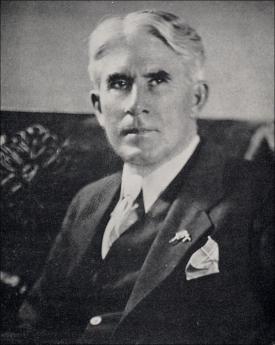
|
| Zane Grey |
The American myth of the cowboy has much more Philadelphia flavor than one would suppose, considering the far-western location of the cows, the New York origins of Teddy Roosevelt, and the implication of southern aristocracy running through the dispossessed gentlemen riding the purple sage. The myth of the noble cowboy is behind much of what elected Ronald Reagan, the Californian.
Nevertheless, the Homer who started this epic Iliad was Owen Wister of Seventh and Spruce, Philadelphia.His book The Virginian might be summarized in a single quotation, "When you say that to me, smile." Behind that, of course, was Wister the lion of the Philadelphia Club rebuking his peers. The real theme was "I searched the drawing rooms of Philadelphia and Boston for the gentleman. And I found him on the frontier."
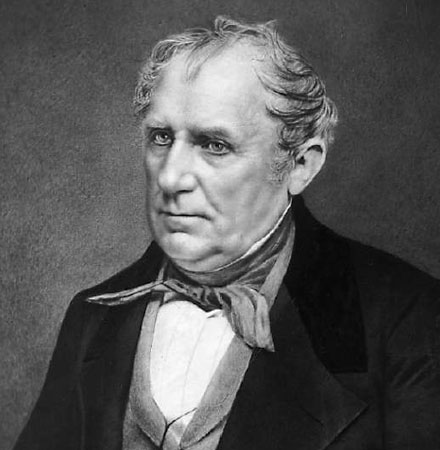
|
| James Fenimore Cooper |
Part of this complex theme is the underlying outdoors fraternity linking cowboys and Indians, tracing back to James Fenimore Cooper of Camden, NJ ennobling the noble savage in the Last of the Mohicans. Fair treatment for the natives has long been a strong Quaker theme, tracing back to William Penn's deep wisdom about colonization, and also personified in Corn planter the thoughtful Chief of the Iroquois, or Joseph Brant the scholarly Indian leader who translated the Bible, charmed the English monarchy, and then returned home to massacre the town of Lackawaxen. There's a theme here of shooting the circling Indians off their ponies, take no prisoners, mixed with the tragic white woman who falls in love with the equally tragic Indian brave, all doomed from the start. There's the sheriff with a shady past, going forth to shoot it out with outlaws while his Quaker wife watches out the window, because he is true to the Code of the West. Grace Kelly was surely no Quaker, but the Philadelphia hint is unmistakable.
It may take a century or more, but some American Homer is surely going to write the definitive epic based on this story. Meanwhile, Zane Grey tried his best. His version has a lot of Philadelphia in it, and not only because he went to the University of Pennsylvania on a baseball scholarship. He graduated from Penn as a dentist, practiced in New York for six years, and hated every minute of it. Writing cowboy stories in his spare time, he gladly quit dentistry after his first publishing success, and moved over to Lackawaxen, PA to write in the woods. Lackawaxen is a great fishing spot, and was once a flourishing resort community at the confluence of the railroad and canal systems, now long since decayed and gone. He lived there for fifteen years, and asked to be buried there. His home is now a museum.
Pearl Grey became Zane Grey by way of P. Zane Grey, DDS. He had been born in Zanesville, Ohio, the son of a Quaker mother who belonged to the founding Zane family, and a preacher-farmer father who had insisted on the dentistry idea. All his life, Zane Grey was a vigorous sportsman, most unlikely to warm to an effeminate name like Pearl. Or gentle Quaker ways, either; but like his cowboy heroes he was obedient to his code. Most of his life he managed to go fishing more than two hundred times a year, and produced two thousand words of writing almost every week. He wrote a hundred thousand words a year, and kept it up for thirty years. He published sixty books in his lifetime, and thirty more of his books have appeared since his death. His material was the basis for forty movies, and many short stories. Six of his books are about fishing, but mostly he wrote sophisticated variations on the theme of the wild West, the cowboy true to his code, and the noble savage. He was the first American author to become a millionaire from his writings. It seems sort of a pity that he was overtaken by the pressures of commercial success, and consumed by his extraordinary drive and diligence to the point where very little time was left for the Great American Epic of the West. He lived in California for many years, but it seems unlikely there were enough hours in his day to shake loose from Quaker origins.
The same is true of Ronald Reagan and his Iowa origins, but somehow that does not capsulize what the American cowboy represents. Somehow there is something in common about the former Confederate cavalrymen who were the early cowboys, the Quakers befriending the Indians, and the Iowa boy who was to negotiate the end of the Cold War with the Evil Empire. It is somehow a matter of remaining true to your roots while dealing fairly with strangers. It lies in Reagan's motto as much as the Virginian's barroom warning. Trust, but verify.
Victorian Broad Street

|
| Broad Street |
Starting at the Delaware River and walking East-West on Spruce Street, it is possible to envision an architectural museum which begins in 1702 and ends at the Schuylkill River about two hundred years later. As Spruce Street crosses Broad (14th Street), it reaches the level of Victorian architecture, and for this discussion, we now face North on Broad Street and visit the string of solid masonry fortresses which exemplify Philadelphia at the height of the Industrial Revolution. At Broad and Locust Streets stands the old lady, the Philadelphia Academy of Music. Now reverted to its original purpose of presenting grand opera, the 1857 acoustical mansion long housed the Philadelphia Orchestra. Electricity has replaced gaslight, and there are a few elevators to the upper balconies. But the Academy is a surviving example of a class of music halls which once dominated every large city in the Western world. Opera hasn't changed; why should the Academy?
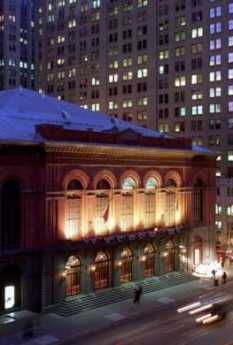
|
| Academy of Music |
A book called Philadelphia Scrapple, written by several anonymous Philadelphians, gives a succinct description of the conception and design of the Academy building:
"Joseph R.Ingersoll became chairman of a committee to secure subscriptions for a building fund. When what was thought to be an adequate fund had been raised, the committee for the building went to consult Napoleon Le Brun and his partner about plans.
" Mr. Le Brun asked the committee how much money they had to work with. In Mr. Le Brun's own words:
"' Upon their telling us, we said you cannot build a beautiful opera house inside and outside both for that amount, but you can build the interior thoroughly complete and build the outside perfectly plain and simple like a market house, and if you ever have the money later on you could easily face it with marble and make the exterior beautiful, too.
' When the question was asked us, "If we do that how are we to know that the acoustics will be thoroughly good in every respect?", I replied that there was but one large theatre in the world at that time that was perfect acoustically, and that was La Scala at Milan, and that to be quite sure of the new Academy before we began to build, the Scala interior, stage, and auditorium should be duplicated.'
"To aid in securing acoustic perfection, over and above the meticulously studied proportions and dimensions, there is an intricately-devised system of inverted barrel-vaulting underneath the orchestra and, underneath the centre of the parquet, a counter-vaulted sounding well, walled in with bricks, 12 feet deep and 20 feet in diameter."
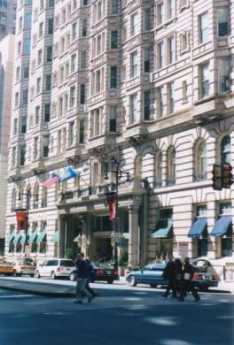
|
| Bellevue |
Just a little further North of the Academy is the Bellevue, which was long called the Bellevue Stratford, but which now has a Hyatt Hotel on the top floors, and a food court in the basement. Because of the tax laws, for a century it has been shrewd to sell a hotel every seven years, often just trading it with a similar hotel which is also at the seven-year point. In the case of the Bellevue, this grand hotel in the European style changed its name for more than one reason, mainly because in 1976 it was the scene of the discovery of a new disease, Legionnaire's Disease. As it turned out, this bacterium was especially favored by growing in water-cooled air conditioning equipment and made its epidemic debut when the American Legion held its convention at the hotel for the bicentennial of the Declaration of Independence. The epidemic almost destroyed the attendance at the bicentennial, bankrupted the hotel, and represents a historical moment that everyone hopes to forget. The hotel is just too stately, comfortable and charming to disappear, and eventually, the Legionnaire story will just be a curiosity. John B. Kelly, the father of Grace, once the Mayor of the town, and a Democratic power baron, used to hold court at lunch every day in the main dining room. The Republicans, of course, held a daily luncheon war dance at the Union League a couple of doors away, and you had to be careful where you ate lunch if you had political involvements. Although the ballroom of the Bellevue was the only place for a debutante function or a really fancy banquet, there were many hostesses who were uneasy about going to the place which was the center of Democrat politics and felt they had to ask around before they announced a decision.
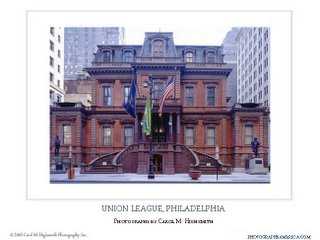
|
| Union League |
And a few steps North of that, at Broad and Samson Streets, stands the Union League itself. Not the Union League Club, please, that's a name used in other cities; this is the home of the franchise, the Union League itself. Although it's a house, it is a very big brownstone house, attached to another building in the rear which must be ten times as large. When you are inside, you pass from the 1860 building to the 1902 building without noticing the change but viewed from the outside, it is easy to overlook the connection. Brownstone is soft and easily attacked by the weather, so the League requires a lot of maintenance. And gets it; the place is spick and span. If you appear there without a jacket or tie as someone's guest, they won't eject you, but they will wordlessly bring you a jacket and tie to wear, and most people don't have the brazenness to do it twice. Inside, the furnishings are comfortable but reflective of the Civil War origins of the club, with marble floors and walnut walls, stained glass windows and awesome rooms dedicated to Lincoln and other Republican Presidents, plus Civil War Admirals and Generals. One of the dozen dining rooms is outfitted like a Victorian saloon, with portraits of semi-nude buxom ladies on the wall that once graced the walls of Edward Stotesburyand others with needlepoint furniture on oriental rugs for the ladies to have afternoon tea. You can hold a wedding banquet in one room, and a cigar-smoking bachelor brawl in another, without one group likely to see the other.
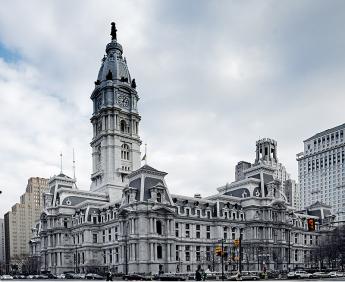
|
| Philadelphia City Hall |
At the head of Broad Street, dominating the view from the middle of the street, is City Hall. When it was designed in 1858, it was to have been the tallest building in the world, but politics intervened, and when it was completed in 1888, the Eiffel Tower and the Washington Monuments were taller. It is almost impossible to guess how opulent and ornate City Hall once was, but a guided tour is provided, and with coaching, you can see the huge staircases, the arching ceilings, the palatial offices for the Mayor, City Council and the Supreme Court. You can take a 44-story elevator ride, but you can no longer go up to Willam Penn's hat. The views of the city are spectacular, showing off the rivers, the parkways, the clusters of skyscrapers, and the vistas of Broad Street, stretching North and South to form what is said to be the longest straight road in the country. A tour of City Hall, which most residents never bother to take, teaches an impressive lesson in the way the city residents once loved their town, contrasted with the shabby neglect and decay which now overtakes city politics. For years it was said that City Hall should be torn down and replaced with something functional. But anyone who tours the place today comes away appalled at such an idea. The demolition cost alone makes the project indefensible. No one can now guess whether the future holds a revival of reverence for this massive monument, or whether, like the statue of Ozymandias, it is destined to lose all significance except to point a moral or adorn a tale.
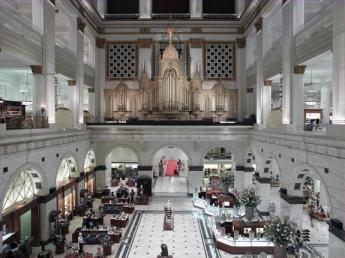
|
| Wanamaker's |
To go further north on Broad Street, you must go either East or West around City Hall. To the East is a department store striving to keep up the standards set at that location by John Wanamaker, who made famous the saying that the customer is always right. Or, going West around City Hall, you might tip your hat to the place where the old Pennsylvania Railroad had its Broad Street Station. It's hard to believe, but the trains from Washington and New York really did puff and jingle right up to fifty yards from the Mayor's office. They came into Center City on an elevated track, creating a barrier long known as the Chinese Wall. After the tracks were removed, the urban land became the railroad's most valuable property, and may eventually become the center of a city moving slowly westward.
On Broad Street North of City Hall are two more notable Victorian buildings, and then we'll stop. On the East corner, at what is known as number one North Broad Street, is the Masonic Temple, looking like a Norman church or fortress, which is much the same thing. The Masons were here first. Their temple was moved here in 1873, some fifteen years before City Hall was completed. It is likely, however, that the plans were made after 1851 when City Hall was originally conceived, and the Masons were just more skillful in getting a building built, as you naturally might expect of them. And what a building. There are seven meeting rooms inside which would rival in size the auditorium of most good-sized churches. Cantilevered staircases astound the viewer, and there are acres of marble flooring and paneled walls, hung with portraits of former masons, like George Washington and Benjamin Franklin. Different components of the organization, like Knights Templar, can meet simultaneously, and the size of the rooms gives some idea of the size of the organization. In fact, it is only part of the Pennsylvania Chapter, since the Shriners are somewhere else. The Masons have always been bewildered by a Pope who once ordered his faithful to abstain from Freemasonry, a dispute possibly having to do with the Twelfth Century disputes of the Popes at Avignon and the confiscation of the Knights Templar, but it's hard for an outsider to judge. The Masons will invite you to join, but they won't tell you what they do until you join. If you don't know what an organization is all about until you join, it's an impediment to membership recruitment. Or perhaps it's the other way around. Perhaps it is a testimony to the large number and esteemed public reputation of its members that so many can be induced to join, purely out of respect for the people they know who are already members. In any event, Masons certainly can build impressive buildings. If you are one of the many people who have lived in Philadelphia for six decades without visiting the place, make a note to go there soon.
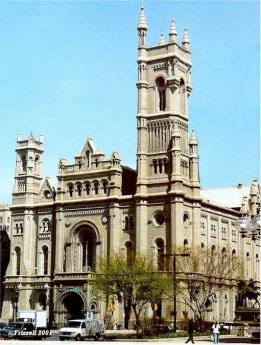
|
| Masonic Temple |
And then the final stop on the tour, the Pennsylvania Academy of Fine Arts. For the moment, never mind the towering reputation and history of this cradle of American Art, of Eakins and Rush and Peale. Just look at the looming red building designed by Frank Furness on Cherry Street, all massive and funny-looking and Egyptian or something. First of all, it would be wise to learn how to pronounce his name, which is more like Furnace than fur-Ness, since there are lots of descendants around who are in a position to snub you if you stumble. It's maybe a little hard to understand why a building has to be so massive to hold pictures at an exhibition, but perhaps the thought simply was to make it cheaper to leave it standing than to tear it down. The City moved away from the Academy of Fine Arts, and now it is moving back again, but the permanent collection never changes. Some say that the modern exhibitions never change, either, but that's just post-modern slander. In time, the Academy will overcome.
The Houses in the Park
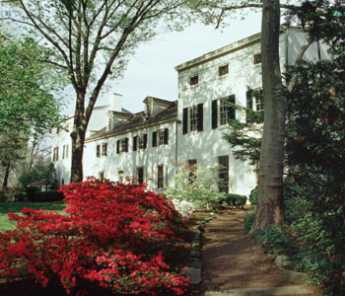
|
| Strawberry Mansion |
Fairmount Park is said to be the largest park (7000+ acres) within the limits of an American city, and in fact, maybe just a little bigger than the city can afford to maintain. It was established in the middle of the 19th Century through the efforts of the College of Physicians of Philadelphia to reverse the Industrial Revolution's relentless pollution of Philadelphia's Schuylkill River and the water works. The waterworks were built in 1801 in the mistaken belief that Yellow Fever was caused by pollution; Fairmount Park more accurately responded to the idea that Typhoid Fever was waterborne from upstream pollution. Lemon Hill, the nearby mount containing Robert Morris' Mansion, was purchased to expand the reservoir capacity of the waterworks and thereby made the Art Museum possible where the reservoirs were originally located.
The Park has long constituted a symbolic interval between center city and the suburbs. Since the construction of the river drives and later the expressway, the commute along the river amidst trees and parkland has made an entrance to town a pleasant experience. If the town planners had been able to foresee automobile commuting, they might have anticipated that the sun would be in the driver's eyes coming East during morning rush hour, and in his eyes as he went home toward the West in the evening. Driving safety might perhaps have been impaired by the tendency of this glare to direct attention to the park rather than straight ahead, but nevertheless redoubles the effect of the park views as a daily aesthetic experience. Even the pollution idea had its ambiguous side since animals increase the bacterial runoff from their grazing areas, and the original houses in the park had many pastures. Strip mining, however, allows mineral contaminants to be washed by rain into the watershed. The city waterworks today extract nearly 800 tons of sludge from the water supply, daily. Whatever the effect downstream, the high ground had less malaria and less typhoid than swampy lowlands, so many of the original houses were useful summer retreats for city dwellers during the early years of the city.
The park is governed by the Park Commission, and at one time had its own police force, the fourth largest police force in the state. Started in 1868, the Park Guards changed their name to the Park Police and then became part of the Philadelphia Police in 1972. The original 28 officers had grown to 525, had their own police academy and a proud tradition. It seems very likely that some deep and dirty politics were played in this shift of authority, and it might be a fair guess that some bitterness still survives in the circles who know and care about these things. In 2008 a scarcely-noticed rule change gave the Park to the City Department of Recreation, thus placing it just a little closer to ambitious real estate development. Our present concern, however, is with the houses in the park.
There are seven of them, kept up and maintained by the Philadelphia Museum of Art. Guided tours are provided intermittently by the museum, but since funds are limited only three of the houses are open year round. The others are equally worth a visit but unfortunately, are closed during the height of the spring flowering season. Two of the year-round houses represent the two extremes of Philadelphia culture, since Mount Pleasant was owned by a buccaneer ("privateer") named McPherson who lived at the height of 18th Century elegance, while Cedar Grove was originally a Quaker farmhouse of the greatest simplicity consistent with honest comfort, a style which persisted relatively unchanged until late in the 19th Century. Benedict Arnold and Peggy Shippen looked at Mount Pleasant with an eye to purchase but never lived there because they were called away by national events. With the addition of modern plumbing and air conditioning, Mount Pleasant would be an elegant place to live, even today. McPherson had to sell the place to pay his debts, whereas the Wister and Morris descendants of Cedar Grove still populate the Social Register in large numbers. The two houses completely typify the underlying philosophies of the two leading Philadelphia classes of leadership. One group measures itself by how much it spends, the other group measures success by how much it has left.
REFERENCES
| Treacherous Beauty: Peggy Shippen, the Woman behind Benedict Arnold's Plot to Betray America: Mark Jacob:978-0762773886 | Amazon |
Swarthmore College
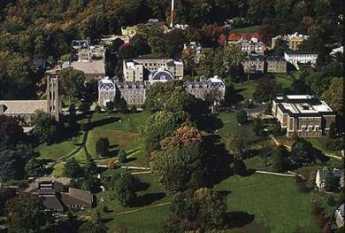
|
| Swarthmore College |
The Friends Association for Higher Education lists 17 American institutions as Quaker Colleges, Universities, or Study Centers. Four of these, Swarthmore, Haverford, Bryn Mawr and Pendle Hill, are located in the Philadelphia region. Until Haverford College recently adopted co-education, it was once possible to say Haverford was all-male, Bryn Mawr was all-female, and Swarthmore co-ed; Pendle Hill has no undergraduates. That greatly oversimplifies a very distinctive set of complexities, however. Since there is no official connection between the colleges and the church, it is a little hard even to explain the sense in which they are truly Quaker, which is by operating under a strong striving for consensus.
Swarthmore is commonly said to be the most Quaker of the three undergraduate colleges, but only 7% of its students are Quaker and only a quarter of its trustees. The most distinctive feature of the college is the so-called Honors Program, patterned after the tutorial system of Oxford and Cambridge, which was brought there in 1921 by a non-Quaker president who had experienced the system as a Rhodes Scholar. The establishment of this program was heavily supported by the General Education Board, which is to say the Rockefellers. As a reflection of the pressures of graduate schools, and possibly student preference for a greater variety of subject material, only about a third of the students elect to take the Honors Program. It is, however, the central core of the college.
The name of the college derives from Swarthmore, which was the English home of George Fox, the founder of Quakerism. Early Quakers were uncomfortable with the colleges and universities of their day, which had been founded to educate priests and ministers of various other religions, gradually enlarging their mission to include the children of upper-class families. The motto of Eton College embodies much that made Quakers wince: "Eton exists to exert a civilizing influence upon those who are destined to rule." Even the American variation of that there is scarcely an improvement since it would probably say something along the line of offering the opportunity to increase the student's future life income by 70%. It is easy to understand why Quakers wanted to have their own school system, protecting their children from attitudes and influences they disapproved of. Although the Civil War somewhat disorganized the early directions of Swarthmore, for fifty years it was a simple rural college, aimed at avoiding modern influences more than seeking a defined unique role. And then along came Frank Aydelotte.
Very likely, a major appeal underlying the Oxbridge seminar system to Aydelotte and the Quaker trustees was its modern evolution into a model for producing those unusually talented and incorruptible civil servants, who really run the British government under the nominal control of elected officials. Such ambitions necessarily imply a need to attract unusually bright students, and Aydelotte's method was to keep the student enrollment smaller than a well-financed faculty could attract. Unfortunately, as brighter non-Quaker applicants were attracted, more and more Quaker applicants had to be rejected. By 1953, the incoming new president, Courtney Smith, was prompted to make the rueful observation, "Franklin Roosevelt's record at Harvard, and Adlai Stevenson's at Princeton, and Dwight Eisenhower's at West Point, were scarcely, I am told, pace-setting." Almost every American college now faces something like the same conflicted feeling, since globalization implies that all Americans, not merely Quakers, might someday be excluded from their own colleges in order to make room for, say Orientals, who are brighter. Remaining small, however, Swarthmore does have the latitude to seek its own solutions, one of which has been to create the pre-eminent scholarly center for the study of Quakerism.
There are other quiet paradoxes atSwarthmore. From rural simplicity to suburban elegance, the physical transformation of the campus made possible by generous funding might distress only a Quaker. Indeed, Arthur Hoyt Scott of the class of 1895 donated 330 acres of ornamental garden in 1929, composed of beautiful ornamental plants, that no matter what their origin would thrive in the Delaware Valley. Not only is this garden a premier place to visit, but it is also one of the inspirations along with Longwood and Bartram's Gardens for landscaping of the entire Mid-Atlantic region.
And then there is the subsequent history of Frank Aydelotte. True, after he left Swarthmore he became a Quaker, himself. But he left to implement the educational ideas of Mr.Bamburger the department store magnate at the new Institute for Advanced Study in Princeton. That is, at that unquestionably pre-eminent intellectual center whose main achievement so far has been the development of, the atom bomb.
REFERENCES
| Swarthmore College: An Informal History: Richard J. WaltonASIN: B0006ELCO8 | Amazon |
Stephen Girard 1750-1831
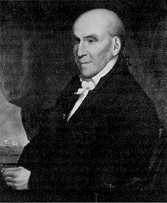
|
| Stephen Girard |
Girard was born in Bordeaux, France and never went to school. By the age of 23, he had become a sea captain, like his father and grandfather. By the age of 27, he owned his own ship and was thus launched on a successful career in a very dangerous occupation. Depending on the destination and weather during that era, up to forty percent of sailors were lost at sea on long voyages. From the point of view of the passengers and shippers, when you were selecting a captain you wanted one who had returned unharmed from many voyages. It was irrelevant whether he had been lucky, or diligent, or had learned a lot from his relatives in the trade.
Stephen Girard did start with a handicap, being born blind in one eye. It may have been a personality disorder which drove him to precise, minute instructions to his subordinates in excruciating detail; he might now be called a "control freak" and be disliked for it. For example, he kept a handwritten copy of all letters he wrote, and at his death, there were 14,000 of them, sorted and filed. His wife went insane, and after spending years at the Pennsylvania Hospital, was buried on the grounds. If this is the price of being rich, some might consider remaining poor. During his working years in Philadelphia, he would normally get to the counting-house at 5 AM, go to his bank at noon, and go to work on his 600-acre farm in South Philadelphia after 5 PM. He said he liked farm work the best. The image left behind by this role model, then, was workaholic. Nevertheless, if you wanted to become the richest man in America, here was the pattern to follow.
Girard probably came as close as any rich man in history, to "taking it with him" when he died. His innately compulsive personality, combined with the sure knowledge that his relatives and others would probably try to break his will for their own benefit, led to the construction of a last will and testament that withstood a century of court challenges. It launched remarkable philanthropy for thousands of orphans and organized the whole Delaware Valley into an industrial machine unlike anything else in the country. Although he left the largest estate in the nation's history, that estate continued to accumulate money from his minute instructions to executors, eventually enlarging his vast fortune fifty-fold, a century after his death. In retrospect, Philadelphia might well have slowly declined into obscurity after the nation's capital moved to Washington in 1800. Instead, the coal, canal, railroad and industrial empire of the Philadelphia region became the "arsenal of the North" during the Civil War, and the main wealth generator of the Gilded Age which followed.
Girard's business career can be somewhat oversimplified as consisting of shipping at the base of his early good fortune, followed by banking during the era when banking was poorly understood and usually ineptly managed. He ended his career with an eager and successful embrace of the emerging Industrial Revolution. Throughout all of this, he characteristically took great risks for great profits, through recognizing what others were too timid to accept fully. On many occasions, his risky ventures resulted in very large losses, made acceptable by other risky ventures proving unexpectedly successful. An example would be Girard's Bank. When the Federal Government first started and then abandoned the First National Bank Girard bought up the remnants and made a great private success of banking, where he had little previous experience. He saw the potential of the canals, and later the railroads when others were content to be farmers or country gentlemen. When he was 79 years old, he purchased vast tracts of wilderness containing some outcroppings of coal, because he could foresee a great industrial future for the region. No pain, no gain.
Another way of looking at Girard was as the most prominent French-American citizen of his time. He arrived in Philadelphia at about the same time Benjamin Franklin stepped off another boat, returning from abusive treatment by British officials which finally flipped him for American independence. Franklin recognized that independence from England meant an alliance with France, or else it meant defeat. It is possible to view the American Revolution as an episode of France searching for an American foothold after its expulsion fifteen years earlier in the French and Indian War; trouble between Britain and its colonies might re-open opportunities for France. Girard was extremely friendly with Thomas Jefferson, the most Francophile of founders and early American presidents. When the War of 1812 with Great Britain threatened disaster for the new American state, Girard staked $8 million dollars, his whole fortune, on financing that war. During the entire period from 1776 to the Louisiana Purchase, America was wavering between its gratitude to France and underlying loyalty to the English-speaking community. During that long formative period, Girard the very rich Frenchman was hovering in the background, probably influencing American foreign policy more than is known, even today. But the France that Girard stood for was neither aristocratic of the LaFayette variety nor intellectual of the Robespierre sort. It was France of the French peasant, crabbed, acquisitive, and morose, forever responding to a "hidden hand" of his own self-interest in a way that paradoxically benefited his whole community, and thus would have hugely amused the Scotsman Adam Smith.
Mrs. Meade's House
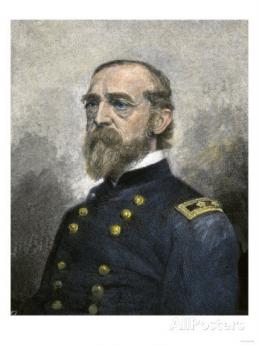
|
|
Union General George Gordon Meade |
General George Gordon Meade, the hero of Gettysburg, lived in quite an elegant house during the six years (1866-72) he was a Commissioner of Fairmount Park. The house (at 19th and Delancey) has "MEADE" carved over the stately entrance facing 19th Street, and while the neighborhood has run down somewhat, it was obviously once an imposing mansion. The house belonged to Mrs. Meade. From that, you might suppose that the General had married a rich woman, but that would be wrong.
When General Lee was advancing on Gettysburg, it was widely supposed that his goal was to conquer Philadelphia, the Arsenal of the North. The town was in a panic, built some forts on the Schuylkill to defend itself, and later lionized the hometown hero who had saved them. Mrs. Meade was living at the time in a modest little place, and the town fathers took up a collection to buy General Meade a proper house.
A delegation of officials traveled down to Virginia to present him with their gift of gratitude, but Meade would have none of it. He was only doing his duty, and could not consider for a moment accepting major gifts for his soldiering. No, he was very sorry, he had to decline.
So the delegation came home, all a fluster. Someone then had the idea of offering the house to Mrs. Meade. And when they visited her, she promptly said "Sure."
Old Blockley (P.G.H.)
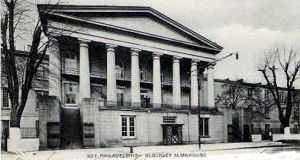
|
| Old Blockley |
For a long time, the Philadelphia General Hospital was the largest hospital in town, even growing briefly to seven thousand patients during the Civil War, but leveling off at about three thousand at the beginning of the Twentieth Century. At the end of World War II, it had shrunk to about 1500 beds, but it was Medicare and Medicaid in 1965 which finally did it in. By 1977 it was costing the City of Philadelphia about five million dollars a year beyond its revenues to run the place with only 300 patients, while the running expenses of the local private hospitals were actually less, per patient. Titles XVIII(Medicare) and XVIV(Medicaid) of the Social Security act constituted Lyndon Johnson's Great Society, and in effect they made every patient at PGH resemble a walking government check in the mind of hospital administrators. The local hospital association made the argument to the Mayor Rizzo that everybody would be better off if the hospital closed and those government checks were directed to the local voluntary institutions. After a few years, the federal government inevitably squeezed the generosity out of the bargain they would of course now like to abandon. But that's the way it goes. PGH is gone and it isn't coming back. The eighteen acres in Blockley Township, now West Philadelphia, were given to the University of Pennsylvania next door, and gigantic amounts of federal money were contributed to the building of skyscrapers replacements for the original PGH. Ironically, the two hundred children's beds now on the location are fewer in numbers than the three hundred adults once considered too uneconomically few to maintain, and the cost per day of hospitalization is roughly ten times the PGH cost which had been described as unsupportable. The rest of the real estate is built up with buildings involved in medical research, which is also an activity dedicated to working for its own extinction. Discovering a cheap cure for cancer would quickly create a need to fill the vacancies with something else. No one regrets this system of creative destruction, but everyone should regret the diminution of the spirit of local philanthropy which underlay it.
PGH was one of a dozen or so big-city charity hospitals, like Bellevue in New York, Charity in New Orleans, or Cook County Hospital in Chicago. Of these hospitals, PGH had surely been the best, and at the turn of the Twentieth Century a Mayor's commission issued a report about the place which began, "Philadelphia can surely be proud...." Having worked in Bellevue and having visited most of the rest, I can testify that was likely true. When PGH was finally torn down, the walls and floors had such substantial construction that changing the wiring and plumbing to some other purpose had become almost impossible. The PGH nurses were famous for running. Although the alcoholic and drug-addicted patients might be called the dregs of society, the alacrity of the student nurses in running them bedpans or answering other calls, was spectacular to watch. When a doctor came on the floor, they jumped to their feet and were usually ready with the patient's charts, unmasked. Unlike Bellevue, where the floors were creaky and wooden, the open wards at PGH were spacious, clean, well maintained and equipped. At Bellevue, the forty-bed wards were crowded with sixty or seventy patients, so close together you could almost roll from one end of the room to the other without touching the floor. I can remember seeing one seventeen-year-old Bellevue student nurse tending such award at night alone, the intern sharpening needles, and the medical resident developing electrocardiograms in the darkroom. None of this would have seemed acceptable at PGH.
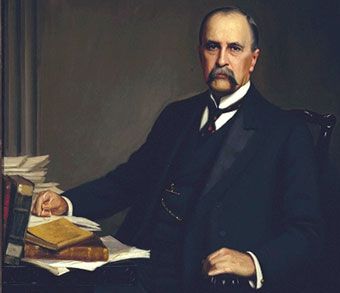
|
| Dr. William Osler |
Old Blockley was the place where modern systems of medical education originated. Up until William Osler came to Philadelphia, medical education mostly consisted of attending eight hours of lectures a day. Osler had an electrifying personality and wandered among the sick at PGH with a train of students following him. He is much quoted, and once suggested his obituary ought to read, "Here lies the man who took the students into the wards." A somewhat more elegant statement of the value of the practical experience was included in his dedication speech at the Boston Library: "To treat patients without books is to sail an uncharted sea. To read books without seeing patients is never to go to sea at all. Osler was somewhat underappreciated during his time in Philadelphia and went on to found the medical school at Johns Hopkins in Baltimore. Nevertheless, the main reason he later left John Hopkins and went to Oxford was his dismay at the adoption of the "full-time" system, which is to say the faculty stopped having a private practice of their own to act as a gold standard for their research and teaching. When all is said and done, there are some areas of discomfort in the transition of students from observers to actors. The PGH system of learning surgery was commonly reduced to a slogan, "See one, do one, teach one,"; things have progressed to the point where it is probably right for the public to insist on greater supervision and control than the old almshouse provided.
The disappearance of old Blockley ended a controversy, or even something of a mystery, about which was the oldest hospital in America, PGH or the Pennsylvania Hospital at 8th and Spruce. There had been an infirmary in Old almshouse at Eleventh Street, and there is no doubt the almshouse was there first. PGH grew out of the almshouse. However, there were many comments at the time of the founding of the Pennsylvania Hospital that it was now the first; that's a strange thing to say when the almshouse was three blocks away. Social historians need to look into the mindset of colonial America, which seems to have included the distinction between the worthy poor and the unworthy poor. Somehow, the founding principal of the Pennsylvania Hospital was to get people back to work who were capable of productive work, possibly even paying for itself in that way. In their minds, apparently just giving solace and help to those who were down and out was not quite the same thing.
Paul Robeson 1898-1976
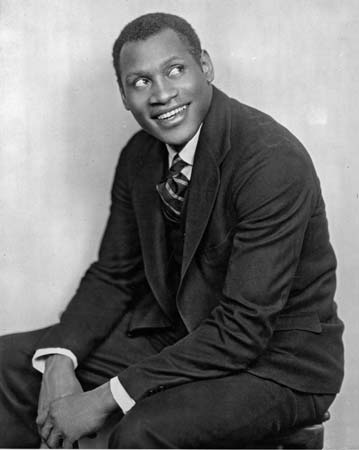
|
| Paul Robeson 1898-1976 |
Everyone with international fame and fortune seems to belong to another planet, but Paul Robeson belongs to the Philadelphia region as much as to any locality. He was born in Princeton, of a black minister who went to Lincoln University, and a mother of Quaker heritage. Not only an All-American football player, but he also won twelve varsity letters. He not only was accepted to Columbia Law School, but the only black person in the class became its Valedictorian. Later on, his amazing baritone voice made him the perfect person to sing "Old Man River" in the musical Showboat, and quite a different dimension emerged in his highly memorable portrayal of

|
| Paul Robeson as Othello |
Shakespeare's Othello. He was combative athlete, nobody's fool, and had a commanding stage presence. It was scarcely surprising that he resented the social slights he encountered in his upward mobility, or in a time when many people -- not just in show business -- were leaning leftward, that he frightened people with his praise of Communist Russia and seeming incitement of his race to rebellion.
Probably the first false note in this tragedy was his resignation from a prestigious New York law firm because a white secretary insulted him. No defensive explanation from his admirers could quite justify this unlikely story of a promising career cast aside for a trifling affront. Some of his foreign travels may have been entirely motivated by a search for social progress, but his several hospitalizations abroad do raise the possibility that he hoped to avoid publicity about his illness. The last two decades of his life were destroyed by undeniable mental illness. There are schools of the psychiatric theory which contend that depression can be caused by severe life stresses, but majority opinion now mostly views such illness as an inherited disorder. In any event, he was born too soon. In recent years, the treatment of depression has much improved.
The failure of early promise is an old story, but in Robeson's case, it was far more than personal decline, and more the hunting-down of a wounded animal. The son of an ex-slave, Robeson evoked memories of slave rebellions in the past with his mournful song of the Mississippi laborer, as did his vengeful destruction of the innocent Desdemona. His exploiters in the entertainment industry probably deserve some criticism for pushing him too far into a rebel image, and the ruthless manipulation of communist agitators during the 1930s is not a myth. So, there was really not much to prevent Senator Joseph McCarthy and his associates Cohn, Shine and Kennedy from converting the post-war fears of the nation into a circus of fearful demagoguery. Millions of people had just died in foreign wars, nations had been reduced to rubble, and vengeful heedlessness was on every side. It was not a pleasant time.
More than twenty years later, Paul Robeson died where he had been living with his sister, in West Philadelphia.
Philadelphia in 1976: Legionaire's Disease
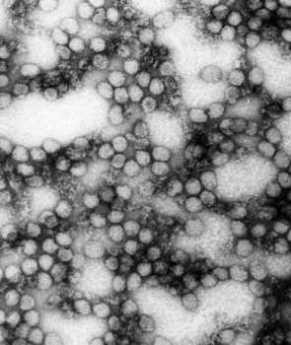
|
| The Yellow Fever |
No other city in America is remembered for an epidemic; Philadelphia is remembered for two of them. The Yellow Fever epidemic, for one, that finished any Philadelphia's hopes for a re-run as the nation's capital. And Legionnaire's Disease, that ruined the 1976 bicentennial celebration. One is a virus disease spread by mosquitoes, the other a bacterial disease spread by water-cooled air conditioners. Neither epidemic was the worst in the world of its kind, neither disease is particularly characteristic of Philadelphia. Both of them particularly affected groups of people who were guests of the city at the time; French refugees from Haiti and attendees at an American Legion convention.
In 1976, dozens of conventions and national celebrations were scheduled to take place in Philadelphia as part of a hoped-for repeat of the hugely successful centennial of a century earlier. Suddenly, an epidemic of respiratory disease of unknown cause struck 231 people within a short time, and 34 of them died. Every known antibiotic was tried, mostly unsuccessfully, although erythromycin seemed to help somewhat. The victims were predominantly male, members of the American Legion of a certain age, somewhat inclined to drink excessively, and staying in the Bellevue Stratford Hotel, one of the last of the grand hotels. Within weeks, it was identified that a new bacterium was evidently the source of the disease, and it was named Legionella pneumophila. Pneumophila means "love of the lungs" just as Philadelphia means "city of brotherly love", but still that foreign name seemed to imply that someone was trying to hang it on us. Eventually, the epidemic went away, but so did all of those out-of-town visitors. The bicentennial was an entertainment flop and a financial disaster.
Since that time, we have learned a little. A blood test was devised, which detected signs of previous Legionella infection. One-third of the residents of Australia who were systematically tested were found to have evidence of previous Legionella infection. A far worse epidemic apparently occurred in the Netherlands, at the flower exhibition. Lots of smaller outbreaks in other cities were eventually recognized and reported. It becomes clear that Legionnaire's disease has been around for a very long time, but because the bacteria are "fastidious", growing poorly on the usual culture media, had been unrecognized. And, although the bacteria were fastidious, they were found in great abundance in the water-cooled air conditioning pipes of the Bellevue Stratford Hotel. Even though the air conditioning was promptly replaced, everybody avoided the hotel and it went bankrupt. When it reopened, 560 rooms had shrunk to 170, and it still struggled. Although there is little question that lots of other water-cooled air conditioning systems were quietly ripped out and replaced, all over the world, the image remains that it was the Bellevue, not its type of plumbing, that was a haunted house. There is even a website devoted to its hauntedness.
Rittenhouse Square Area
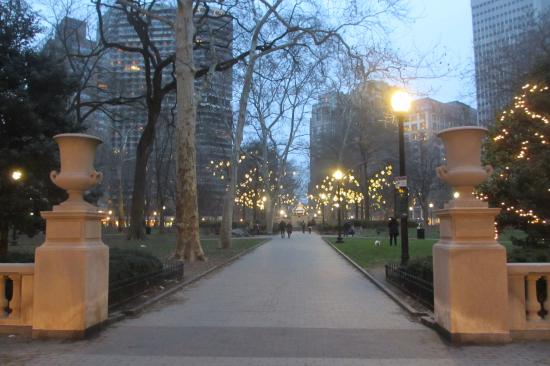
|
| Rittenhouse Sq. |
The Rittenhouse Square "area" has far outgrown the square itself, and the term when used by locals usually refers to the whole area of central Philadelphia West of Broad Street to the Schuylkill, bounded roughly by Chestnut Street on the North, and Pine Street on the South. Rittenhouse Square Park is in the center of this primarily residential area and is now mostly ringed by apartment buildings. Rittenhouse Park was once enclosed by a high cast-iron fence with sharp-pointed palings and gates that could be locked at night, just like so many London Squares. The fence disappeared around 1900. Around 1840 the first house was built on the square, and then a fifty-year building boom (reflecting the burgeoning prosperity of the city) filled the fashionable area out to the limits defined by the Schuylkill bridges at South Street and Walnut or Chestnut Streets. Because of the advent of central heating and inexpensive window glass manufacture, the low ceilings and small windows to the East of Broad Street (promoted by the need for fireplace heat, plus laws taxing both windows and white paint) were replaced by tall ceilings and big windows without mullions. These townhouses were big, often with twenty or more rooms, and the occasional narrow streets filled with small houses were for servants, however, gentrified they may have recently become. The center of fashion shifted over the years, and right now probably Delancey Street is the pinnacle, although it is patchy and arguable. After the 1929 crash (of the stock market), many fashionable Families had to abandon the unmaintainable big house and move into the little servant house in the neighboring alley in order to remain in the fashionable area. The Big houses with its big taxes then became several apartments or a storefront with apartments above. Or it just deteriorated and then was torn down, unless some economic up swelling happened to rescue it again. The fact is that the number of big houses in the area exceeds the number of wealthy people who want to live in them, and the fashionable area has thus had to contract, but it has not disappeared, either.
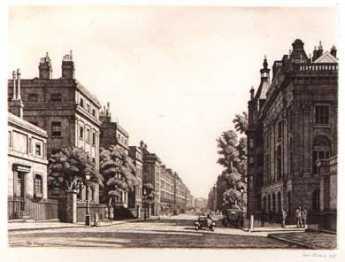
|
| Spruce Street |
Rather than swamp this blog with a tedious recital of the previous occupants of so many show houses, let it suffices to say that the families which once had the most Notable Houses around and near Rittenhouse Square were Roberts, Weightman, Frazier, Gibbs, Harrison, Stotesbury, Cassatt, Jayne, Harding, Janney, Gazzam, Scott, Dobbins, Bullitt, Baugh -- and, of course, many others too.
Within this district, churches abound at the Northwest corner. Clubs are strung along the Eastern border, between the residences and the financial district along Broad Street. And the Southern border is where the doctors used to be. I had an office once at 19th and the Square, but the main concentration of doctors was on Spruce Street. If you have seen Harley Street in London, you will recognize the pattern. Originally, the doctor had his office on the ground floor and lived upstairs. The zoning regulations in both London and Philadelphia permitted professional use of the first floor only if the professional lived in the house. So, when the advent of automobiles induced most doctors to live in the suburbs, the office continued on the first floor of these houses, and the doctor's nurse lived upstairs, to satisfy the requirement of the zoning law. But that was just a transient phase; the advent of health insurance during World War II induced a more hospital-centered medical practice, and Spruce Street soon lost its medical flavor as doctors concentrated their offices around hospitals and their ample parking lots.
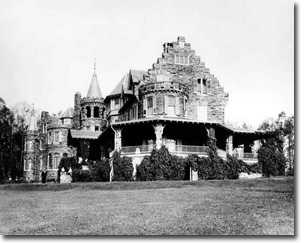
|
| Resselaer |
As traffic heading for the South Street bridge or the Walnut-Chestnut-Market bridges defines the limits of the district, the Rittenhouse Area has more or less contracted to the four blocks of East-West streets which terminate at the river, creating a more quiet and peaceful cul-de-sac.
Some idea of the former grandeur of the area can be gained by looking at the former Van Rensselaer home at 18th and Walnut, which had a brief fling as a private club before it became a gift shop. Or the Wetherill Mansion further South on 18th Street which now houses the art alliance. Or the grey stone house a couple of doors to the West of it which was where Governor Earle lived and was the last single-family house on the square. One of the houses on DeLancey Street was featured in the movie "Trading Places" as Hollywood's idea of real opulence, and a great many other houses tell a famous story. The Rosenbach Museum is at Spruce Street, very well worth a visit, particularly on Bloomsday. And the Thaw House at 1710 Spruce tells a particularly lurid tale of the Gilded Age.
William Allen, Tory
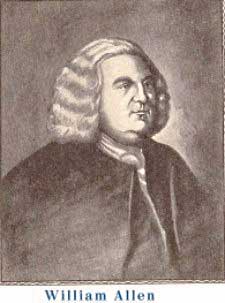
|
| William Allen |
William Allen was once famous for his expensive carriage and a team of horses, at a time when there were only eighty carriages in the colony. He was born wealthy but personally made considerable sums in maritime trade, which in those days included a mild form of piracy called privateering. Taking his accumulated wealth, he invested heavily in colonial real estate. His urban ventures included the land under Independence Hall, and his lands in the hinterland included the present town of Easton. He was a tough businessman, providing "muscle" where needed in a colony dominated by pacifist Quakers. At one point, he imported a thousand muskets and ammunition for the use of settlers in the Lehigh Valley who had difficulties with the Indians and Connecticut invaders. Allentown is named after him.
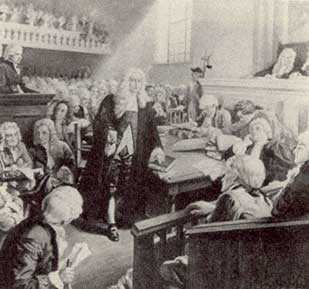
|
| Philadelphia Lawyer |
It is difficult to apply present standards of judgment to Allen. William Penn had been given the colony on condition that he protect and maintain it. That was clearly a difficult challenge for a Quaker colony in the wilderness, surrounded by Indians, French and Spanish buccaneers, and neighboring colonies who were far from pacifist themselves. The system often amounted to giving land to subcontractors like Allen, on condition that they maintain law and order. Furthermore, Allen was quite obviously a person of parts. His credentials as Chief Justice were based on his attendance at the Inns of Court when almost all other lawyers were trained by local apprenticeships. His father in law was Andrew Hamilton, the famous "Philadelphia lawyer" who won the landmark case for Peter Zenger and later became the leader of the Pennsylvania Assembly and mentor to young Benjamin Franklin. His land-dispute services in the negotiations with Lord Baltimore were notable. In general, he was a continuing force for peace and stability, and no one held it against him that peace and stability suited his needs as a landlord and merchant. To him, the battle for independence was just another unsettling disturbance which prevented the colony from achieving its potential.
His daughter married John Penn, the grandson of William Penn, who was the local representative of the Proprietors and later the Governor. All in all, it is not surprising that he retreated to his home on Germantown Avenue, called Mt. Airy, when the revolution broke out. Unlike many other Tories who fled to Canada, he felt his past services would protect him if he remained quiet and secluded until the war was over. He didn't quite make it, dying in his mansion, in 1780.
The Swedenborgian Church
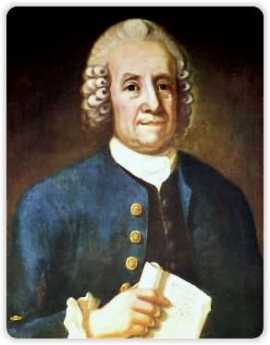
|
| Emanuel Swedenborg |
Among the many churches centered in Philadelphia, the Swedenborgian is probably the least typical and most difficult to understand. The church does not actively seek out a new membership, but it welcomes everyone, in the spirit of Emanuel Swedenborg's observation that "All people who live good lives, no matter what their religion, have a place in Heaven." Without attempting to define the teachings of Swedenborg (1699-1772), who was quite able to speak for himself, it can be approximated that Heaven plays a central role in this belief system, and predestination does not. Although the ceremonial features of this religion are very similar to the Episcopal Church, its main emphasis is on good works as a way of attaining the reward of Heaven. In some ways, that is an unexpected position for a noted scientist like Swedenborg to take, since generally scientists lean toward Calvinism, with the mechanistic view that if God is all-powerful, then human free will must be impossible.

|
| cross |
There are at least four divisions of the Swedenborgian religion, but the Bryn Athyn branch is most notable in the Philadelphia region. A very wealthy adherent of Swedenborg named John Pitcairn bought a large tract at Bryn Athyn and gathered the local church to live around a perfectly magnificent cathedral and church school. It is hard to think of any church in the Philadelphia region which approaches the magnificence of the Bryn Athyn cathedral. It has a special character that it was conceived and built during the crafts movement of the early twentieth century, with imported European workmen deliberately organized like medieval craft guilds. The central features of this workmanship reflect and then project the belief in personal individuality within the whole religion. No two windows, or doorknobs, or carvings are the same in the cathedral, reflecting the wish for each workman to devise his own unique creation and show the way of personal responsibility to the faithful. This cathedral is one of the things in the Philadelphia region most worth visiting, but to appreciate its quality you have to know what you are looking at.
Everybody in this church is unexpectedly hard to characterize. The Pitcairn Foundation was such a successful investor that it formed a mutual fund for others to share in its good fortune. Its central philosophy is to invest only in corporations which have been dominated by a single family, preferably the founding family, for at least fifteen years. There are about six hundred eligible corporations, and recent management scandals in the newspapers illustrate the Pitcairn's exactly knew the dangers of handing your assets over to a hired manager. This family-centered investing approach consistently yields better than the S & P 500, which in turn beats ninety percent of investment managers. You sort of get the idea you know where this family is coming from when you meet a courtly, meek, retiring but friendly person, who can say, "My mother is the only person I ever met who looked perfectly at home seated under a sixty-foot ceiling."
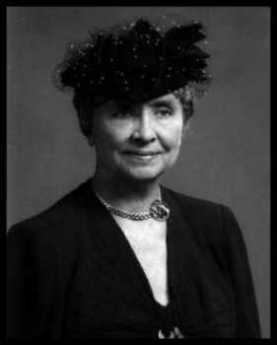
|
| Helen Keller |
Two other famous Swedenborgians illustrate the unusual individualism of this religion. Helen Keller, the deaf-blind girl who overcame her handicap by going to Radcliffe and becoming a successful author and lecturer, for one. The other would be Johnny Appleseed (1774-1845), whose real name was John Chapman. Grammar school legends would have this bearded, barefoot vegetarian adopting a life of poverty like St. Francis, but in fact, he was an extremely shrewd businessman who died rich. He developed the business plan that American settlers would be going West into what was then the Northwest Territory, and having a tough time getting enough to eat the first year or two. So, he anticipated the paths of frontier settlement, and went ahead among the Indian tribes, planting apple trees. When the settlers arrived in the region, he sold them young apple trees and showed them what to do with them. Apples grown from seed are not the tasty morsels we know today but tend to be rather shriveled and bitter. So Johnny showed them how you make cider, and if you let it sit around a while, hard cider. The settlers would use the pulpy squeezing for compost, and he would be back to collect the seeds from them so he could continue his business plan in the next county. In short, he showed them how to drink the apples. He also let the Indians pick the apples, so they liked him and spared him the common troubles of the frontier.
If you are going to boil apples, you need a pot, and Johnny often carried his like a hat. He wasn't a nut, at all, he was a showman. In his backpack, he was also carrying a Bible. And in his head, he carried a motto, "All religion has to do with life, and the life of religion is to do good."
The Girl in the Red Velvet Swing
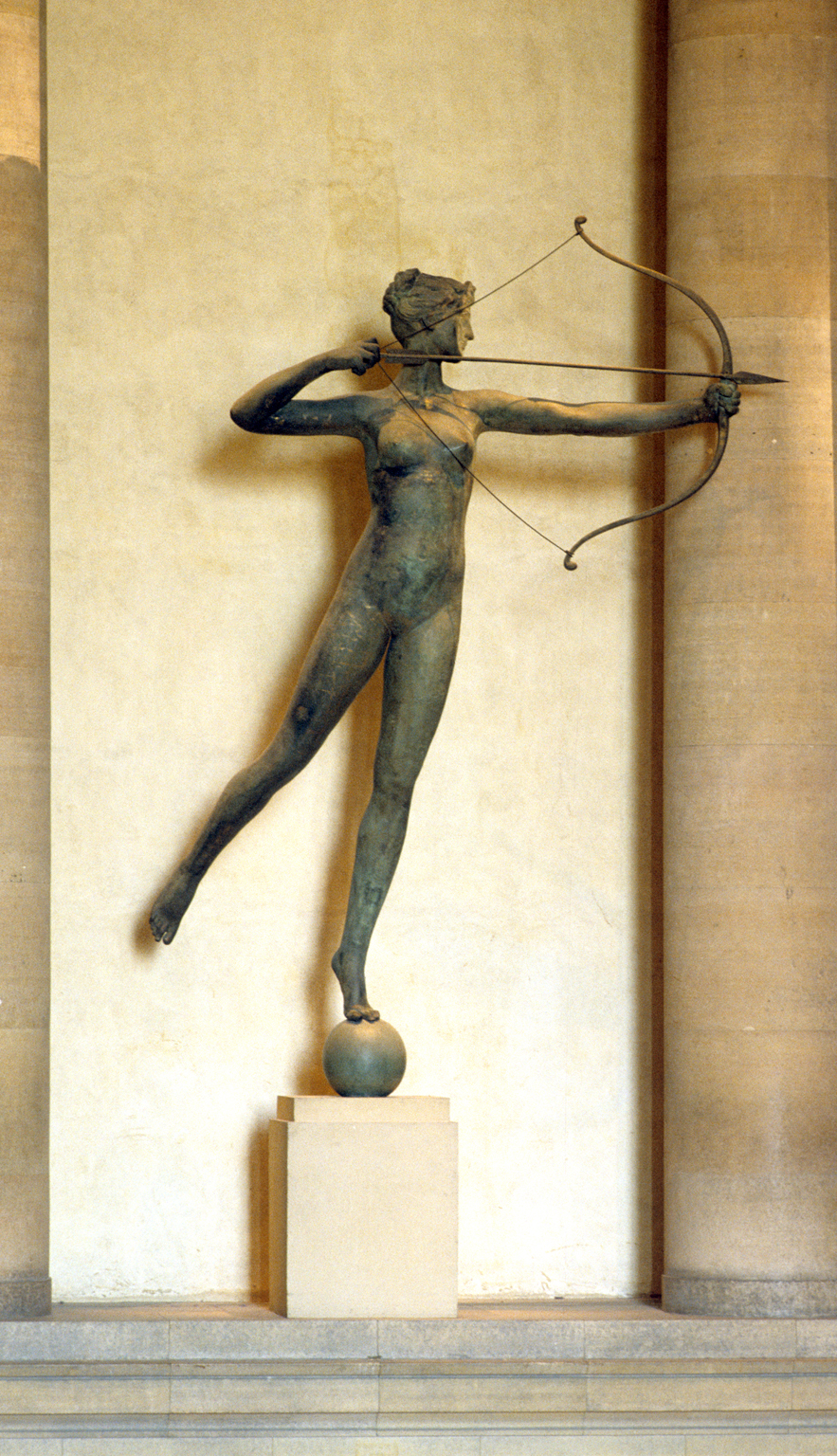
|
| Statue of Diana |
The brownstone house at 1710 Spruce Street is seemingly not remarkable, it's just an Edwardian house now converted to lawyers' offices on the first floor. But it's nevertheless a landmark, curiously linked to that 13-foot statue of Diana which dominates the top of the main interior staircase of the Philadelphia Museum of Art. Many Philadelphia gossips believe the model for the statue was Evelyn Nesbit, who lived in the brownstone on Spruce Street. But she was born in 1884, whereas Augustus Saint-Gaudens created the statue for the 1892 Columbian Exhibition. Since Evelyn was only eight years old at that time, however, it must have been some other woman who took off her clothes to pose for the sculpture; for us, it doesn't matter who she was. The statue was moved to the top of Madison Square Garden when that structure was really still located on New York's Madison Square, but when the Garden was demolished in 1925 the Diana statue came to Philadelphia. Madison Square Garden itself has moved twice in the meantime and is mostly associated in the public mind with prize fights and political conventions. However, when the first Garden was built, it had theaters and roof-top restaurants, and its spectacular nature instantly made the architect, Stanford White, the most famous architect in New York, eventually maybe the most famous one in the world at the time.
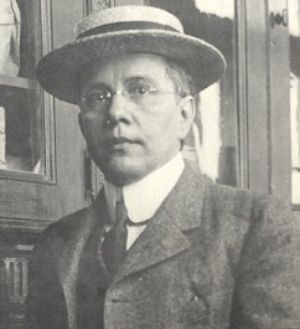
|
| Thaw |
Meanwhile, two residents of Pittsburgh independently came to New York where the action is, the iron and coal millionaire Harry K. Thaw, and an impoverished teenager named Evelyn Nesbit. Evelyn was accompanied by her mother who, recognizing the girl's extraordinary beauty, set about to steer her to fame and fortune. At the age of thirteen she was posing for artists, and in time became the favorite model for Charles Dana Gibson. Gibson created the "Gibson Girl", an idealized role model for millions of women who dressed the way she did, wore their hair the way she did, and behaved in the proper Edwardian style they imagined she did, too. It was in Gibson's studio that she encountered Stanford White. Evelyn had another life, however, as a "Florodora Girl", and one of her many stage-door Johnnies was Harry K. Thaw, the millionaire. That was no saint, having a reputation for using a dog whip on his numerous lady friends, but it is uncertain whether he was completely aware that
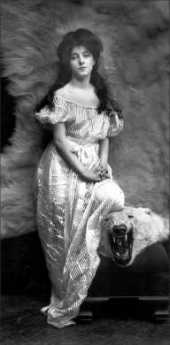
|
| Evelyn Nesbit |
Evelyn was one of the principle entertainers in half a dozen hide-aways that Stanford White is said to have established for naughty parties to amuse New York's fast set. That was certainly aware that Stanford White had been Evelyn's boyfriend before Thaw married her, and the two men cordially hated each other. One evening, some provocation made Thaw walk over to White's table in the rooftop restaurant of Madison Square Garden, and shoot him dead -- in front of hundreds of people. It's a curious sidelight that Stanford White was carrying a train reservation to Philadelphia, to discuss plans for the domed structure of the Girard Bank building. The notoriety of the murder trial was the sensation of the decade, with the prosecutor remarking that White deserved what he got, and Thaw's mother offering Evelyn a million dollars if she would give testimony supporting a plea of insanity. Everyone seems agreed that the money was never paid, although the jury was sure as impressed as the newspaper reporters with Evelyn's refusal on the witness stand to testify against her husband, quite evidently a sign of loyalty. Anyway, the jury let him off, and a famous cartoon depicted Stanford White in the pose of the statue of Diana.
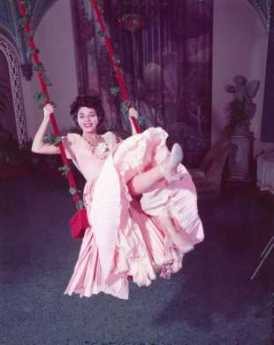
|
| Joan Collins as Evelyn Nesbit "The Girl in the Red Velvet Swing" |
Evelyn sort of dropped out of sight after the trial and the subsequent divorce, until TV interviews were conducted for the movie about the episode, \"The Girl in the Red Velvet Swing". By 1957, Evelyn was decidedly less of a beauty. Meanwhile, Harry K. Thaw had continued to live in the brownstone house in Philadelphia, where once he got sick and called a friend of mine to be his doctor, and eventually another famous professor to be a consultant. When the butler answered the door, the consultant told the butler to tell his employer that he must insist on cash in advance, an action that thoroughly embarrassed my friend in view of the famous wealth of the client. But the consultant had rightly assessed the situation since later Thaw's lawyer called up and told the family doctor he was sorry but his client was not going to pay his bill since the medicine was started by some botanical book to be a poison in excess quantity. In consternation, my friend called up the professor and asked what to do. "Chalk it up to experience," was the answer. "But what have I learned?" The consultant paused, and said, "Maybe you have learned to extend credit only to decent people."
Fernery
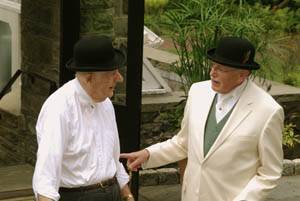
|
| Gardeners |
As explained by the curator of The Morris Arboretum, there are a few other ferneries in the world, but the Morris has the only Victorian fernery still in existence in North America. That doesn't count a few shops that sell ferns and call themselves ferneries; we're talking about the rich man's expensive hobby of collecting rare examples of the fern family in an elaborate structure. That's called a Victorian fernery. The one we have in our neighborhood is really pretty interesting; worth a trip to Chestnut Hill to see it.
Although our fernery was first built by the siblings John and Lydia Morris, it was rebuilt at truly substantial cost by the philanthropist Dorrance Hamilton. It is partly above ground as a sort of greenhouse, and partly below ground, with goldfish and bridges over its pond. Maintaining an even temperature is accomplished by a complicated arrangement of heating pipes. The temperature the gardener chooses affects both the heating bill and the species of fern that will thrive there. You could go for 90 degrees, but practical considerations led to the choice of 58 degrees. The prevailing humidity will affect whether the fern reproduction is sexual or asexual, a source of great excitement in 1840, but survivors of Haight-Asbury are often more complacent on the humidity point.
There are little ferns, big ferns, tree ferns, green ferns, and not-so-green ferns; the known extent of ferns runs to around five hundred species. Not all of them can be found in Chestnut Hill, what with humidity and all, but there are enough to make a very attractive and interesting display. For botanists, this is a must-see exhibit. For the rest of us, it's probably the only one of its kind we will ever see, a jewel in Philadelphia's crown, and shame on you if you pass it by.
Morris Arboretum
 The former estate of John and Lydia Morris is run as a public arboretum, one of the finest in North America. 
|
Morris is the commonest Philadelphia name in the Social Register, derived largely from two unrelated Colonial families. In addition to their city mansions, both families had country estates. The country estate once belonging to the Revolutionary banker Robert Morris was Lemon Hill, just next to the Art Museum, where Fairmount Park begins. But way up at the far end of the Park, beyond Chestnut Hill, was Compton, the summer house of John and his sister Lydia Morris. This Morris family had made a fortune in iron and steel manufacture and were firmly Quaker. Both John Morris and his sister were interested in botany and had evidently decided to leave Compton to the Philadelphia Museum of Art as a public arboretum. John died first, leaving final decisions to Lydia. As the story is now related, Lydia had a heated discussion with Fiske Kimball, at the end of which the Art Museum deal was off. She turned to her neighbor Thomas Sovereign Gates for advice, and the arboretum is now spoken of as the Morris Arboretum of the University of Pennsylvania. It is also the official arboretum of the State of Pennsylvania. To be precise, the Morris Arboretum is a free-standing trust administered by the University, with the effect that five trustees provide legal assurance that the property will be managed in a way the Morrises would have wished. In Quaker parlance, Lydia possessed "steely meekness."
A public arboretum is sort of an outdoor museum of trees, bushes, and flowers, with an indirect consequence that many museum visitors take home ideas for their own gardens. Local commercial nurseries tend to learn here what is popular and what grows well in the region, so there emerges an informal collective vision of what is fashionable, scalable, and growable, with the many gardeners in the region interacting in a huge botanical conversation. The Morris Arboretum and two or three others like it go a step further. There are two regions of the world, Anatolia and China-Korea-Japan, with much the same latitude and climate as the East Coast of America. Expeditions have gone back and forth between these regions for a century, transporting novel and particularly hardy or disease-resistant specimens. An especially useful feature is that Japan and parts of Korea were never covered with glaciers, hence have many species found nowhere else in the temperate zone. Hybrids are developed among similar species found on different continents, and variants are found which particularly attract or repel the insects characteristic of each region. The Morris Arboretum is thus at the center of a worldwide mixture of horticulture and stylish outdoor fashion, affecting millions of home gardeners who may never have heard of the place.
Please Touch
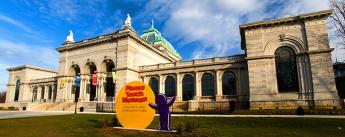
|
| Please Touch Museum |
There had been rumors for some time that the Please Touch Museum was planning to move from 21st Street to larger quarters, but recently its Executive Director Laura Foster appeared at a luncheon at the Franklin Inn Club to announce definite plans. The Museum moved into Memorial Hall in West Fairmount Park in the fall of 2008.
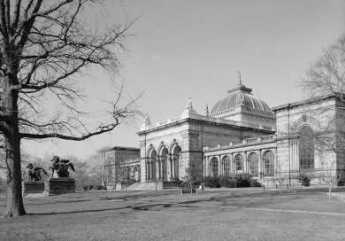
|
| Memorial Hall Fairmount Park |
There are over 400 children's museums in the world, and the first one was started in Brooklyn in 1899. Just why Philadelphia waited until the Bicentennial Celebration in 1976 to start one, is not clear. It's particularly unclear when you hear of its explosive success. Growing rapidly during an era when museums of all sorts are seeing declining attendance, the Please Touch Museum will be making its fourth move in thirty years, each time to larger quarters because they needed more room. Sooner or later, expansionism will get its comeuppance of course, and Memorial Hall is one awfully large building to fill. And to heat, and to paint, and to air condition. The price is right, however. The City Administration, which approached the museum with a proposal, has offered an 80-year lease for a dollar. When you hear that they have occasionally had 1500 visitors in a single day, however, and annual attendances approaching 200,000, almost anything seems possible.
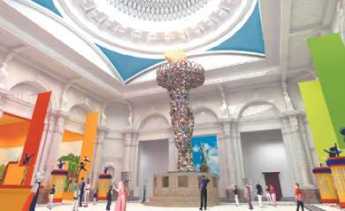
|
| Liberty Torch |
There are certain limits. Nothing frightens a 4-year-old like a herd of 10-year-old boys racketing about, so there are segregations necessary. In other situations, these little kids not only can't touch, but they also can't see and they want to see badly. And the sociology is interesting. The kids may well clamor to come when they hear other kids talking, but in general, it is the parents who get the idea that a museum trip would be fun. And the parents seem motivated by theories of upward mobility, of giving their child a "leg up" on the competition. The museum is certainly filling a need, but you have to wonder where our society is headed if a picnic in the park is mainly a good idea if it gives junior a leg up.
Meanwhile, keep tuned. To fill up that monstrous Memorial Hall will take publicity, and these gals sound as though they mean to have a lot of it.
Hidden River
.jpg)
|
| Schuylkill River |
In Dutch, Schuylkill means "hidden river", thus making it redundant to speak of the Schuylkill River. As soon as you become aware of this little factoid, you start to come across Philadelphians who do indeed speak of the Schuylkill in a way that acknowledges the origin of the term. To give it emphasis, it is common to speak of the "Skookle". The point comes up because cruises have started to leave from the dock at 24th and Walnut Streets, where it becomes quite noticeable that the Schuylkill really is rather hidden as it winds seven miles south to the airport, in contrast to the wide-open vista we all are accustomed to seeing from the Art Museum northwards.
The bluff at Gray's Ferry, where the University of Pennsylvania's new buildings now dominate the scene, was originally the beginning of dry land, or the end of the rather large swamp, through which the river winds its way essentially shaded by trees along the riverbank. Never mind the junkyards and auto parks you happen to know lurk behind the trees on the west side or the oil tanks which loom above the trees on the south bank. As evening closed in on the riverboat, the gaily lit towers of center city were looming in the stern, but some fishermen along the bank proudly held up a respectable string of six or seven rather large catfish. If you are there in the evening, the river has the same feeling of wilderness that the Dutch traders would have experienced three hundred years earlier. No swans, however. There were many reports in the Seventeenth Century of large flocks of swans sailing around the entrance of the Schuylkill into the Delaware River. A noted local ornithologist on the recent cruise remarked that forty or fifty species of birds are found there. Even a flock of owls still live within the city limits. You don't see owls, even if you are an ornithologist; their presence is made known by taking recordings of the sounds of the night.
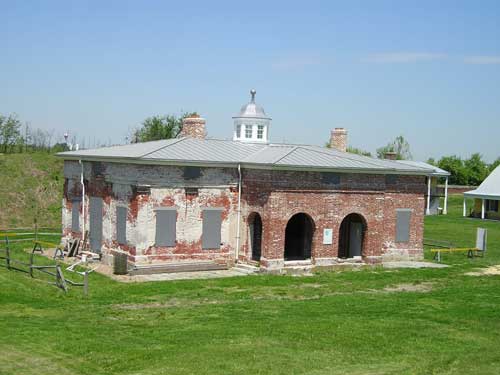
|
| Fort Mifflin |
The geography of swampy South Philadelphia was created by the abrupt bend in the Delaware River at what is now thought of like the airport region. As the river flows at the bend, sediment is deposited in mud flats that once created Fort Mifflin of Revolutionary War fame, and later Hog Island of the Naval Yard, home of the hoagie. Swans are beautiful creatures, but they seem to like a lot of mud. The lower Schuylkill is tidal, and the industrial waste of the region is cleaned out of the land by cutting drainage ditches laterally from the river, flooding the lowlands as the tide rises, and draining it again as the tide falls. This cleansing seems to be working, as judged by the return of spawning fish. And maybe mosquitos, as well, but it would seem rude to inquire.
The Bartram family seems to have known how to make use of river bends and riverbanks, placing the stone barn and farmhouse higher up the bank, but below the bluff of Gray's Ferry forces a bend in the Schuylkill, below which of course flatlands were created. It's a peaceful place, now made available for tours and excursions by placing a landing dock on metal pilings so that it can ride up and down with the tides. The great advantage is that riverboat landings are no longer restricted to two a day, at high tide, with limited time to visit before the tide falls again. Bartram recognized how popular strange plants from the New World would be in England, and his exotic plants were quite a commercial success. Nowadays the big sellers are Franklinia Trees, available the first week in May. The last Franklin (named of course for his friend Benjamin) ever found growing in the wild, was the one John Bartram found and nurtured. Every Franklinia is thus a descendant of this one. They look rather like dogwood but bloom in the early fall. If it suits the fancy, a dogwood next to a Korean dogwood which blooms in June, next to a Franklinia, can make a continuous display of bloom from May to October. And best of all, no one will appreciate it, unless they are in the know.
Chester County, Pennsylvania
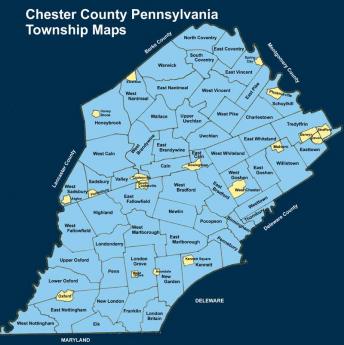
|
| Map of Chester County |
Chester County was one of the four original counties of Pennsylvania, as first laid out by its first white owner, William Penn. Although several parts of Chester County have been cut away, what's left is still quite large. Lancaster County was separated in 1729, and in 1785 Dauphin County was separated from that. In 1789, Delaware County was separated. If you stand in the horse country of Chester County, you still might find it hard to believe anything much has happened in three hundred years. But as a matter of fact, the present population residing within Penn's original boundaries of Chester County would make it the most populous county in the state and growing steadily. Since Philadelphia and Pittsburgh are meanwhile shrinking in population, projected future relationships would strike most residents of Chester County as quite remarkable. Horses, that's what Chester County wants to be all about. Even the mushroom growers of Kennett Square sort of count as part of the horse industry, because mushrooms are grown on horse manure, in the dark. Electronics and steel mills are not exactly traditional, but they reside here, too. As a small footnote, the Lukens Steel Company was recently purchased by an investor named Ross, who lumped it with several other steel mills and then sold the bundle to an owner in India. The consequence is that Chester has a footprint of the largest steel company in the world, or the largest steel company in India, whichever way you wish to style it. Nevertheless, the neighborhood still looks like horse country.
Furthermore, southern Chester County is socially part of the state of Delaware, while western Chester County is thoroughly Pennsylvania Dutch. Up north, the Philadelphia Main Line is building mansions as fast as mortgage originators will allow, and many of them end up paying Chester County taxes. All along Route 202, the central artery of the Great Valley, stretches a burgeoning electronics industry, within which is found Vanguard, the largest investment company in America, or possibly the second largest, depending on temporary quirks of mark-to-market pricing. Chester County presently has the highest average personal income of any county in America. It is far from true that everybody has a horse farm or a trust fund.
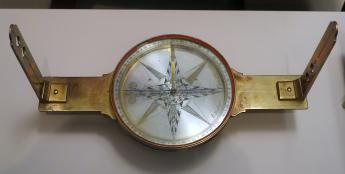
|
| David Rittenhouse's compass |
In a spiritual sense, Chester County horse culture contiguously spreads far beyond even historic outlines of Chester County. The boundaries of southeastern Pennsylvania were laid out with David Rittenhouse's compass, so the rolling hills suitable for horse farming extend into the states of Delaware and Maryland, and of course out into Lancaster and Dauphin counties, without much visible sign of individual state or county. In Europe, by contrast, almost all boundaries are set by rivers and mountain ranges, so the physical appearance of the countryside is apt to change sharply when crossing political borders. In fact, it is possible to say it in reverse: the State of Delaware is mostly Chester County extended, at least in its upper third. Below that lies urban and suburban Wilmington, and below that ("south of the canal") spreads loamy flat farm country, formerly slave country. Maryland divides similarly; an upper third of Maryland's rolling hillsides (sometimes known colloquially as Chester County extended), followed on the south by tidewater Maryland, in turn, followed by the suburbs of Washington, DC. The remnants of Baltimore are mixed in there somewhere, too. When you drive through miles of silent prosperous farms, regardless of highway signs, it is natural to think of yourself in the heart of America.
The one thing Chester County never much warmed to was Universities. It may shock residents of New York City to hear that Chester County never thought much of having its own art museums, classical music, theater performances or opera. However, Chester County doesn't share typical urban dislikes, either. Local speech patterns suggest Appalachian hillbillies and the Pennsylvania Dutch L'il Abners are just like us, just not so rich. Chester County sometimes thinks of itself as nobility, but it isn't Ivy League nobility, it's a country squire. We all like horses, dogs, and guns, we can't imagine why everyone else doesn't like them, too. Chester County has more history than almost anybody; it just doesn't talk much about it.
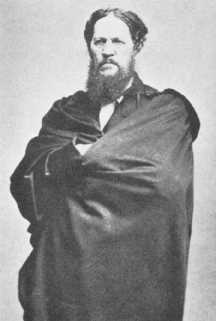
|
| Josiah Harlan |
So let's mention just the highlights: George Washington fought the battle of the Brandywine, the biggest battle of the American Revolution, in Chester County, the Paoli Massacre was long regarded as the second nastiest event of that campaign. A local farmer's son, Josiah Harlan (1799-1871), did what the Tsars and Dictators of Russia and the Kings and Queens of England couldn't do; he conquered Afghanistan. Moreover, he did it single-handedly, making himself King. Even the 350 American Rangers who conquered Afghanistan in 2002 can't match that exploit by this local Quaker boy. The first intern doctor of the first hospital in America (Jacob Ehrenzeller) spent his long life practicing in Chester County. The only President of the United States to come from Pennsylvania (James Buchanan) hailed from Lancaster, not terribly long after it split off from Chester County. In a wry sort of way, it can be said that Buchanan created the Republican Party by almost getting us to annex Cuba. Harrisburg, the present capital of the state, was once part of Chester County. Major portions of both British General Howe's and General Washington's armies left the Brandywine battlefield and swept up the Great Valley of Chester County to Philadelphia and Valley Forge, respectively. Conestoga Creek was once part of Chester County, and Conestoga wagons took many generations of settlers westward to build the new nation; wagons do go pretty naturally with horses. But drive through miles of Chester County today, usually alone through the silent stone barns and rolling grasslands: nothing much seems to have happened except real estate is more expensive.
But then, just drive up Route 202 from Wilmington to King of Prussia, at rush hour. This may be the Great Valley where Washington retreated to Valley Forge, but now it's where employees of the electronics industry ferry children to school, in order to get into the Ivy League, and maybe to shop at fancy stores in King of Prussia. With time out for a recession, it could be wall-to-wall McMansions around here in a generation. It seems almost certain the future will bear little resemblance to the past. It's sort of a pity, it is a great economic opportunity, and it seems inevitable.
Labyrinth, Episcopalian Version
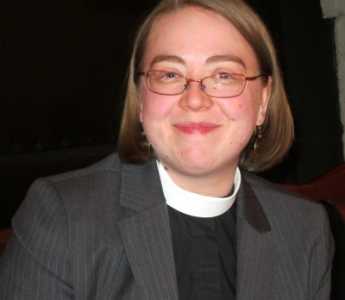
|
| Reverend Diana Carroll |
The Reverend Diana Carroll, Assistant Rector of Holy Trinity Church on Rittenhouse Square, recently addressed the Right Angle Club about the labyrinth to be found there. The fact is, it is there because she put it there, where it is open to the public on Saturday afternoon a month. There are half a dozen other labyrinths in Philadelphia Churches, mostly forgotten, so this is a revival of a custom rather than the invention of one. St. Asaph's on City Line Avenue, St. Stephen's at 10th and Market and a few others have them, most neglected and forgotten. Reverend Carroll admits to importing the tradition to Holy Trinity, persuading everybody in charge to nurture it, and setting aside one Saturday afternoon for the public to visit each month. Labyrinths differ in their design; this one copies the design within Chartres Cathedral in France. In England, labyrinths are much more popular and have other designs.

|
| Labyrinth |
Contrary to popular belief, a labyrinth only has one entrance, which is also its only exit. The visitor goes in, goes round and round and comes to a dead end, and then goes back out the same way. There's no great problem about getting lost; the confusing puzzles of ancient lore are not labyrinths, they are mazes. Whether with walls or simply lines on the floor, labyrinths are designed for meditation and symbolism. It's possible to bump into other people on the way out, it's possible to be struck by the symbolism of reaching the center of things, it's possible to imagine the human condition of getting into things and then getting yourself out. Diana Carroll says the labyrinth evokes the image of feminism to her, entering or leaving the uterus. That thought might not have occurred to everyone else, but an agreement isn't central to appreciating labyrinths.
The Nazca lines, best seen from an airplane over Chile, evoked the image of labyrinths to several Right Angle members. Those lines are a couple of thousand years old, in a decidedly non-Christian environment at the time. Forty-five centuries B.C. could safely be judged to precede Christianity, so it becomes clear that this concept is discontinuous, popping up in many minds in many circumstances. Some theologians might well contend this proves that meditation labyrinths are therefore not part of any fixed religious doctrine. But others, with equal justice, might say it proves that labyrinths are part of the essential nature of contemplative man. Or as in Reverend Carroll's case, woman.
Reviving Schuylkill: Eight Miles From the Dam to Ft. Mifflin

|
| Joshua Nims |
Joshua Nims of the Schuylkill River Development Corporation recently addressed the Right Angle Club about current activities of that organization. It's a non-profit corporation, but in a sense is a quasi-City agency, spending State and Federal funds, plus remediation funds. Just what remediation funds are was not clearly explained, but seem to be fines or assessments on companies who are thought to have fouled up the environment. Whether those assessments are fair or unfair, too small or too large, are political issues largely avoided in Mr. Nims' presentation, and hence are avoided here.
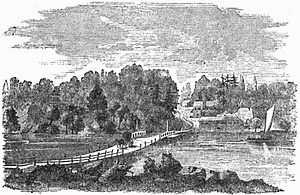
|
| Gray's Ferry Bridge |
The Gray's Ferry area is certainly an urban tragedy of epic proportion, but since its deterioration began in 1856, the events of the Civil War probably had a lot to do with it. Up until the Civil War, the western banks of the Schuylkill, especially around Gray's Ferry, were famously upscale and beautiful. The South Street Bridge, for example, was originally envisioned as leading into a boulevard of the Arts, with the University Museum, Irvine Auditorium, the University Hospital and the mansions on the top of the hill setting off what promised to become a striking cultural statement. Anthony Drexel himself lived up there, walking it to work at Third and Chestnut. And that's just one famous example. It's hard to know what started the blight, but Harrison Brothers White Lead, Color and Chemical Works might be a good candidate and the fact that the area soon developed the tracks often (10) smoke-belching railroads was certainly another major issue. The western bank of the Schuylkill rose to a high rocky promontory at Gray's Ferry, crowding wartime industrialization into a narrow place. Before that, Gray's Ferry Bridge had been the main artery to the South, traveled by George Washington many times, often stopping at Woodlands, that palatial home of Andrew Hamilton the original Philadelphia lawyer. A century before that, the Dutch fur traders had found it to be the first firm land after they sailed inland through the swamp, while the Indians knew it was the last forest area before you reached the (South Philadelphia) area of malaria, yellow fever and other mysterious vapors that must be avoided. In the sense of land travel, Gray's Ferry was, therefore, the most prominent part of the Philadelphia landscape for two centuries. The ferry itself was a floating bridge, pulled back and forth by ropes on each shore of the river. Given a choice of pretty much all of the North American continent, John Bartram placed his farm just south of this promontory. Where it still stands today but surrounded by slums and urban decay.
It's a little hard to judge whether the Civil War pushed railroad construction into the only rocky crevice suitable, and then industrial pollution followed with vile and noxious effluents, or whether the Harrison Lead, Color, and Chemical factory simply started it across the river in the river bend. That's where the DuPont paint factory relocated in 1916, and in fact, the Duponts get local blame as polluters when in fact they made considerable effort to clean things up after they acquired it. The area had a major slaughterhouse abattoir, and an asphalt plant and several other major inducements to the populace to abandon their elegant mansions and run for their lives. The place now has old rusting bridges, tumble-down concrete pilings, lots of weeds, and not a single living fish for a century in that water. To diffuse the blame somewhat, it should be remembered that after the War of 1812, the Schuylkill was the main transportation artery for coal coming down from Pottsville and the rest of Schuylkill County. The river didn't have a sandy bottom, it was pulverized anthracite which releases acids and toxins when washed.
So that's the river region the Schuylkill Development Corporation plans to line with grassy running paths and benches to admire the view. Maybe the Wilson Steamship Line or something like it can again be persuaded to bring tourists here, or maybe the riverbanks can be lined with hotels to house people who take rides on river flatboats, as they do in San Antonio. Or dare we mention it, maybe Paris. Maybe Philadelphia can once again be a tax collector's idea of heaven, together with five-day weekends.
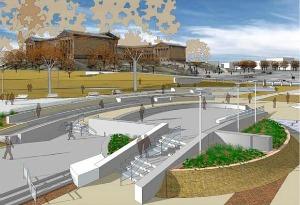
|
| Schuylkill River Development Corporation |
At the moment, this little non-profit city agency is run on a $500,000 operating budget, and has about $20 million worth of projects in progress. Some of that is reparation money pried from the grandchildren of the owners of those factories who did the damage over a century ago, and some large part of it is Philadelphia's share of the boodle from the Stimulus package. There's no doubt the area will look immensely improved in the next year or two, and a lot of hope that private investment will be attracted to an area previously shunned vigorously. The area which has already been cleaned up, from the Wissahickon to the Dam, really must be called a great success; there's lots of foot traffic and joyousness. And the area can also be praised in what unfortunately is the measurement of modern urban development: it has only had two lawsuits for sprained ankles, and only two muggings, quite a commendable record. But now development is going past South Street, into much murkier areas, with more low-income residential spaces. Surveillance cameras are planned, and bright lighting, but it's far from certain that a little strip of gentrification can defeat miles of surrounding decay.
Only if they pull it off will private investment creep into the area, and the parents of University students permit their children to run there. If private investment arrives, this organization can do no wrong, because only then can it fairly be described as "Infrastructure". My own definition of infrastructure as an economic stimulus is of early public spending on projects which would have eventually consumed the money anyway, except later. By that standard, infrastructure spending's only true cost would be the interest on borrowed money to do it sooner. Let's make a note to revisit this experiment in a couple of years, cautiously wishing everyone the best, in the meantime.
Tyler Arboretum
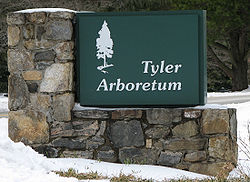
|
| Tyler Arboretum |
There are over thirty arboreta in the Philadelphia region, and one of the oldest and largest is located in Delaware County. The 650 acres of the Tyler Arboretum, adjoining 2500 acres of a state park, create a rather amazing wooded area quite close to heavily settled urban Philadelphia. The Arboretum is located on land directly deeded by William Penn, but it was privately held until 1940 and so is not as well known as several other arboreta of the region. The early Quakers, it may be recalled, often disapproved of music and "artwork", so their diversions tended to concentrate on various forms of natural science. The first director of the Tyler, Dr. John Wister, planted over 1500 azalea bushes as soon as he took office in the 1940s. They are now seventy or eighty years old, quite old and big enough to make an impressive display. Even flowering bushes seemed a little fancy to the original Quakers.
The interests of the earlier owners of the property were more focused on trees, especially conifers. The property contains several varieties of redwoods, including one impressive California redwood, said to be the largest east of the Mississippi. High above the ground, it splits into two main branches, the result of depredation by someone cutting the top off for a Christmas tree. So a large area near Painter Road is enclosed by a high iron fence, containing most of the conifer collection, and warding off the local white-tailed deer. Several colors of paint are to be seen high on many prominent trees, marking out several walking trails of varying levels of difficulty.
And then there are large plantings of milkweed, providing food for migrating butterflies; near a butterfly educational center. There are large wildflower patches and considerable recent flower plantings around the houses at the entrance. Because of the, well, Christmas tree problem, several houses on the property are still occupied.
The only serpentine barren in Delaware County is located on the property; we have described what that is all about in another essay. As you would imagine, there are great plant and flower auctions in the spring, conventions of butterfly and bird-watching groups at other times. The educational center is attracting large numbers of students of horticulture these days, and photographers. Flower gardens and photographers go together like Ike and Mike.
It's a great place for visitors, for members who are more involved, and for those with serious interests. With all that land to cover, some ardent walkers have enough ground to keep them regularly busy. Becoming a volunteer is a sign of serious interest, and that group is steadily growing. For a place that traces back to William Penn, it's slowly getting to be well known.
Heavenly House
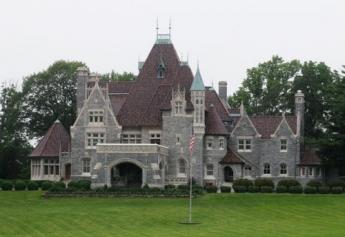
|
| Father Divine House |
While prosperous people, on deciding to enter a retirement community, are often heard to say they are tired of managing a big house, it can also be noticed that people who get the foreign travel bug usually drift around to see the palaces, castles, and estates of kings and emperors. The king's bathroom plumbing is a stop on most tours. Places like Buckingham Palace, the Vatican, the Temples of Karnak, Fortresses of Mogul Conquerors of India, or similar places in Cambodia, are all vast looming piles of stone dedicated to the memory of departed leaders who Had it All. That's probably all you need know, to understand that Americans who have it all tend to build huge show places, too. A great many do discover the castles to become just too much bother. Safe protection and privacy are somewhat separate issues, reasons given for putting up with a big place past the time the thrill has worn off. Perhaps such jaded feelings appear at the end of the wealth cycle. Nevertheless with enough affluence, if you had unlimited money and inclination, where around Philadelphia would you put a dream palace, one built for a modern Maharajah? Answer: close to Conshohocken.
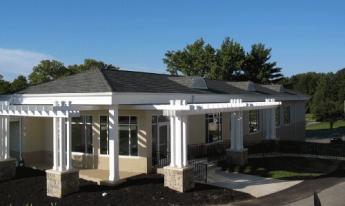
|
| The Philadelphia Country Club |
The Schuylkill takes a sharp bend at Conshohocken because it flows around a big cliff on the west side of the river. It was there the White Steel Company built the first wire suspension bridge in the world, as distinguished from cable (twisted wire) suspension bridges invented by Roebling at Trenton. The bridge was swept away by a flood, the steel mill replaced by the Alan J. Wood Steel Company. Alan Wood prospered mightily, and built his mansion ("Woodmont") on 75 acres on the top of the big rock on the west side of the Schuylkill, in such a way he could watch the smoke rising from his factory down below at the foot of the cliff. The Philadelphia Country Club is across the road from Alan Wood's mansion, with fairways clinging to the cliffs, a Gun Club for trap shooters who want to aim away from houses and toward mountainsides, and a cliff-top road leading straight for Gladwyne between dozens of mansions with five-acre lots. Down the hill, however, rocky projections force the road to funnel into a winding crooked road which ends up near the filling stations of Conshohocken, passing ancient farm structures on the way. Railroads and expressways tend to fill the valley, the old White bridge is gone, and two distinct cultures are within a few hundred oblivious yards of each other. To the west stretches the Main Line, now filled with houses almost as large as the mansion, but air-conditioned and filled with other modern amenities. Seventy acres of a lawn is nice, but it's a lot of grass to cut.
The Alan Wood Steel Company had a hard time in 1929, recovered somewhat after World War II, and then declined to the point where Lukens and Phoenix Steel took over. And then Indians from India took over the lot, forming part of the largest steel complex in the world, now headquartered abroad. In 1952, one of Father Divine's religious followers named John Devoute gave Father the Wood mansion; which then became the new headquarters of his religious sect. He died in 1965 but Mother Divine still lives there in stately and tasteful semi-seclusion. The grounds of the estate are beautifully tended by various of the twenty-five attendants of Mother. Father's mausoleum is near the house.
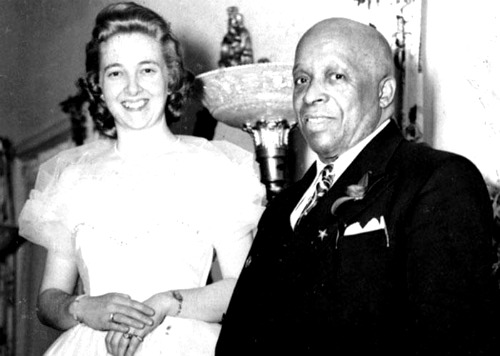
|
| Father and Mother Divine |
The house itself is patterned after Biltmore in Asheville, NC, although perhaps only a quarter as large. Just inside its portecachier, the oak-paneled living room has a ceiling 45 feet high, and many oriental rugs. There is a music room, off to the side of which is Father's former office, bearing a strong resemblance to the Oval Office in the White House in Washington. As planned, the living room window looks down the valley to the site of the old steel mills, although when the trees are leafed out it may be difficult to see. The dining table probably seats forty people, although the paneled dining room was fitted with electronics and used to broadcast sermons to religious adherents across the country. In the living room are testimonies to the many who seemed to rise from the dead, or who had their blinded sight restored, or who were crippled but enabled to walk. The attendants take visitors on tours, but Mother Divine likes to meet them, coming down the sweeping staircase without noticeably showing her age. The greeting of "Peace" replaces the usual "hello" and "goodbye".
At one time, the Religion housed a large number of single women in several hotels, and the invested proceeds of their work as domestics still supports the Religion. The religion frowned on gambling, drinking, smoking, and sex. However, celibacy inevitably leads to a decline of numbers, particularly evident since the death of the founder.
Washington's Circular Letters
ONCE Cornwallis surrendered to Washington at Yorktown in 1781, there emerged the usual reluctance of troops on both sides to get killed for a dispute that was already settled. The British monarchy had ample experience with wars and fully expected to exploit this trait of exhausted soldiers at the end of one. It was clear to the British the colonies could neither be reconciled nor forcibly subdued. What was not clear was how much national advantage might still be extracted from a peace conference. Bluffs and intransigence might still achieve what bayonets could not. Seasoned diplomats are accustomed to such manipulation, but the new American nation only had Benjamin Franklin grown equal to it, representing Pennsylvania and Massachusetts with the British Ministry for several years. Beyond that, however, a particularly American trait was emerging to quit the game before the last card is played. During the Nineteenth century, anticipating and resisting that irresolute temptation came to be called, Character.
The American Revolutionary Army was seldom well-fed, never well armed. Hardly anyone expected a war lasting eight years, or the British regulars to be so mean and effective. Major General Benedict Arnold had seemed like our perfect soldier but turned traitor while in charge of a major defense position at West Point, New York. Conditions for wives and children at home were bad. And the Congress in Philadelphia was willing to inflate the currency, hold back soldiers' pay, pinch pennies on supplies. Other colonies frequently promised to send more soldiers than they actually supplied. Not that they were proud of themselves; they skulked. Surely, some state legislatures and representatives were better than others, but they are almost impossible to identify, now. They all must have been somewhat complicit, or we would have heard more of them denouncing each other. It must have been supremely painful for Washington to receive promises of troops and supplies that he privately doubted, and then to be obliged to assure his troop's help was forthcoming. Inevitable disillusionment discredited him more than the Governors who put him in that position. The British troops surely shared their enemy's reluctance to get killed for a war that was over. They partied and roistered in New York, but who knows what general in London might suddenly order an attack on Washington at Newburgh, just to make overall British defeat seem less humiliating.
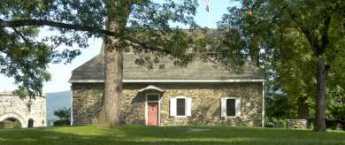
|
| Headquarters, Newburgh NY |
During sixteen months of this agony, Washington wrote many letters to state Governors, keeping them informed while asking for their help. The custodians of the Headquarters museum proudly show the various tables and chairs for his aides to translate French and Spanish, to make thirteen copies of just about everything, and careful files of all correspondence. Washington was an organized person, they say, or else his chief of staff was organized. Someone like Alexander Hamilton, perhaps. Out of all this headquarters communication system gradually emerged the system of Circulars. The General was in a position to see huge deficiencies in the government system for which he dedicated his life, and apparently grew haunted by the idea that all this suffering would be for nothing if the government which emerged was anything like what he was now seeing. His Circulars to the governors began to take on the style of outlining what kind of government the United States ought to have. It must, for example, acquire federal power; the states must turn over more of their own power to the decisions of a single executive. It must pay its debts; a mighty nation does not chisel its creditors. It must suppress the inclination to squabble and think the worst of one another. It must, in his phrase, be virtuous.
Two emphatic views of the new country emerged from Washington's time in Newburgh. The inability of the government to pay its soldiers, suffering or no suffering, was particularly agonizing. And the close call he had with threatened mutiny made it much worse. Robert Morris had run out of tricks and instructed him the central issue was for the Federal government to be able to levy taxes for servicing the debt, which would make it possible to borrow still more through leverage. Washington never forgot this episode, and at several points, during his later presidency, it guided him well. The other episode which made a lasting impression was to some degree his own fault. He was so impassioned in his hatred of monarchy that his closest friends, Hamilton and the two Morrises -- who had never seen much to criticize in a monarchy -- essentially gave up on trying to persuade him, and took the side of General Gates the hero of Saratoga in a planned mutiny. Washington put it down with nothing but the power of his personality and a little play-acting with his bifocals, but he almost lost the confrontation in an instant. Washington had many close calls with death on the battlefield, but these two near-defeats pretty much shaped the rest of his life as our first President. Indeed these two hatreds, of debt and monarchy, continue to characterize many Americans to a degree that others would describe as unreasonable.
And then he made a mistake. As a way of proving his lack of personal motive, he announced in advance he would be leaving public service forever. Today, every lame duck knows that's a bad idea, even when you mean it. And while he may have sincerely thought he meant it at the time, events show he really didn't. Although he probably didn't want to be indispensable, circumstances made him so. He discovered how little he knew of the technical details of government, and thus how much he needed James Madison's help. Washington lacked skill in managing finance; having depended on Robert Morris throughout the war, he needed Alexander Hamilton at least to handle a peaceful economy. But there was no running away from the central issue; he would be forced to recognize how much he overshadowed anyone else in demeanor, and so, how unlikely it was that anyone else could bully others into cooperating. He was a great-souled person, in Aristotle's phrase. Franklin alone perhaps understood and privately doubted that even Washington could pull it off. Washington's Circulars were driving him straight toward seeking the Presidency he widely proclaimed he did not want and would not accept. And thereby he threatened the one thing in life he prized more than any other: his word of honor to keep his promises.
Bones in Duffy's Cut
THE Right Angle Club was recently honored by a talk by Professor William Watson, who teaches history at Immaculata University in Malvern, Pennsylvania. Although it is hard to find much memorial recognition of it, Immaculata is on the site of the Battle of the Clouds, of the Revolutionary War. Washington's army was retreating from the advancing British invaders from Elkton, Maryland, who were headed for the occupation of Philadelphia, in 1778. Although Washington had been outflanked at the biggest battle of the war at Brandywine Creek, he regrouped near Paoli and prepared to defend Philadelphia where the Continental Congress convened. A tremendous rainstorm, possibly a hurricane, hit the two armies as they formed for battle, and everyone's gunpowder was soaking wet. By mutual consent, the battle was called off. The Malvern area was also the site of the Paoli massacre, where General Anthony Wayne overestimated his understanding of the local area, and British troops attacked at night with orders to use bayonets, only.
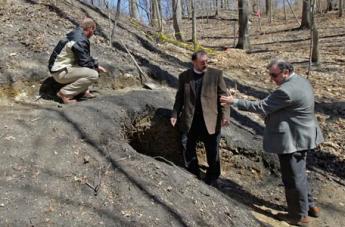
|
| Duffy's Cut |
Professor Watson was, however, speaking about another massacre in the area, at Duffy's Cut. The Cut now belongs to Amtrak, but it was originally built in 1832, from Columbia on the Susquehanna River eastward, as the Philadelphia and Columbia RR, using horse-drawn rail carriages. That essentially means it went from Scotch-Irish Cumberland County, through the Pennsylvania Dutch territory, to Quaker Chester County and Federalist Episcopalian Philadelphia. The builders of the railroad contracted out mile-long sections of the construction to contractors, one of whom was Philip Duffy, who naturally imported southern Irish laborers to do the digging. As a sidelight, Duffy lived in Port Richmond, where he was buried, allegedly a very rich man. His work site was nearly 60 miles east of Columbia, the most expensive contract on the railroad because it involved more cutting and filling of the hilly countryside: Duffy's Cut.
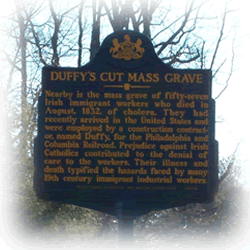
|
| Duffy's Cut Marker |
Sanitary conditions at the dig site were probably pretty primitive, ideal for the spread of fecal-borne illnesses like cholera (and hepatitis, amoebic dysentery, Salmonella, and Shigella), which are characteristic of concentration camps, prison camps, army encampments, and the like. Many later epidemiologists now trace the introduction of cholera to Canada, with downward spread along the Susquehanna, but fifty years before Pasteur there was no sure way to make the diagnosis and no knowledge of its epidemiology. The Irish encampment at Duffy's Cut might just as well have died of bacillary dysentery, but it would have made little difference to know; they just died, and it was said to be cholera that did it. It was probably some kind of fecal contagion, but modern archaeology has recovered eight or ten skulls with bullet holes at the site, and historical investigation of the more usual type has recovered letters by President Clement of the Pennsylvania Railroad, ordering a cover-up. The rest of the story is necessarily conjectural, and we have to be uncertain whether Clement was concerned about hushing up cholera in the region, or ethnic riots, and if so whether he wanted to avoid scaring away replacement laborers, or avoid stirring up local antagonisms. Professor Watson describes considerable difficulty with getting cooperation from politicians and news media in pursuing his studies, where it is hard to see any non-railroad motive, except the motive of wanting to let sleeping dogs lie.
If so, it is a serious concern. It must be recalled that the Scotch-Irish of central Pennsylvania were located there as a result of the activities of James Logan, the agent of the Penn family. The Penns wanted to sell land to settlers and felt that fear of hostile Indians was inhibiting immigration. Logan, who was himself a Scot from Northern Ireland, suggested that the protestant Scotch Irish of that region were tired of combating their Catholic neighbors to the south, and were definitely the equal of the Indians in combativeness. This is the reason the Scotch Irish of Pennsylvania were located to the west of the German settlements of Dauphin and Lancaster Counties. It is also the cause of numerous clashes with the Indians (the Paxtang Boys), the Connecticut invaders of the three Pennamite Wars, and most notably -- the Irish Catholic Molly Maguires of the Pottsville region. Throughout all of these overtly military disputes ran the readily observable fact that the Scottish tribes were accustomed to guerrilla warfare in the woods. They mainly are responsible for winning the Revolutionary War, at least in the Appalachian regions stretching as far to the south as Georgia. They leave us a heritage of bagpipes, country music, very rough football, and airplane pilots. Unfortunately, rough behavior provokes rough behavior in return, and much of the unfortunate features of the labor conflicts of our national politics can be traced to the scars and antagonisms of the Molly Maguire episode of railroads and coal mining. This may or may not have been on Clement's mind when he tried to suppress the news of Duffy's Cut massacre, but it should have been, and to some extent it probably was.
There is no excuse for shooting people in the head or killing them with an ax. But the sixth or seventh generation descendants of the victims are urged to reflect that a campful of male laborers far away from home are apt to exhibit unfortunate behaviors. Remember that no one knew the cause of cholera, but it was new, and it certainly looked contagious. The laborers may or may not have brought it with them, but somebody introduced it to the region, and it looked as though the contagion would continue to spread as long as the laborers continued to be there. There might well have been some unfortunate economic incentives at work, like the disappearance of the Conestoga wagon industry among the Pennsylvania Dutch when the railroad came through. And the obvious concern of the railroad owners that the region has a peaceful, healthful, reputation. The almost total approval of slavery by the Pennsylvania Irish during the Civil War provoked Lincoln to send ten thousand troops to the area during the Civil War. And on, and on. There is almost no part of this region which does not have some remote history of savage behavior. Let's be careful not to stir it up.
Conowingo

|
| Conowingo Dam |
IT was once a major hazard of travel between Philadelphia and Virginia, to cross the Susquehanna River along the way. The river is wide at the top of Chesapeake Bay, and the cliffs are high on both sides. Consequently, the cute little towns of Port Deposit and Havre de Grace grew up as places to stay in inns overnight, perhaps to throw a line into the water and catch your breakfast. Today, these little towns can be seen to have millions of dollars worth of cabin cruisers and sailboats at anchor, at least during certain seasons of the year. In 1928 the Conowingo Dam was built about ten miles north of the mouth of the river in order to harness the water power, and the Philadelphia Electric Company put a power station there as part of the dam, to generate electricity for Philadelphia. It doesn't seem so long ago, but it gave a mighty boost to the electrification of Philadelphia and its industries at the end of its industrial decline from 1900 to 1929. Unfortunately, competitive forms of power generation have now reduced the dam's output of electric power to periodic bursts during the day, and Philadelphia no longer enjoys a reliable cheap water-powered electricity advantage. Coal and nuclear came along, and now shale gas looks like the coming future.

|
| Bald Eagle Fishing |
Although water power could be claimed to be not merely cheap but environmentally friendly, the unvarnished fact is fish get caught in the turbines and rather chewed up by being sucked from the tranquil lake on the upside, emerging at the bottom as a diced fresh fish salad. That attracts seagulls and other fish lovers to the base of the dam. Some fish escape the meat grinder and merely are stunned by the experience, floating downstream to be attractive to eagles, turkey vultures, hawks, and owls. The consequence is that many thousands of gulls sit on the downside of the dam, while hundreds of turkey vultures and eagles sit on the higher levels of the power generation apparatus. And hundreds of bird-watching nature lovers stand on the southern shore below the dam, poised with many thousands of dollars worth of camera equipment and binoculars. If you don't have a pair of binoculars, your visit there will certainly be substandard. Lots of fishermen are there, too, but depending on the waves of spawning fish at different seasons of the year; shad is particularly favored. You can now begin to see the prosperity of Port Deposit and Havre de Grace has a wider variety of attractiveness than merely sailboating and crabbing. There is, however, a large and ominous yellow warning sign.
The sign says you are standing on a riverbank where the water can suddenly rise without warning; if the red lights start blinking and the warning siren starts honking, immediately gather up your tripods and head for higher land. It looks pretty peaceful, however, and the people with tripods are mostly chatting happily with their friends. It can be pointed out, however, that about two hundred bald eagles are perched on the superstructures roundabout. Cameras are mostly digital these days, attached to the rear of a telescopic lens three feet long, and when they shoot bursts of exposures they sound like a machine gun. So, the bird photographers follow a swooping eagle eagerly, shooting away and hoping to catch the bird in an attractive pose, throwing away the rest of the pictures. Good shots are called "keepers", which the photographer is happy to show onlookers on the rear view screen of the camera/machine gun. More sedate bird watchers carry binoculars made in Germany or Switzerland, which cost thousands of dollars and produce really spectacular images. It's unclear whether all this expenditure is worth it, but there is little doubt in the bird lovers' minds you are wasting significant parts of the trip without some kind of binocular.
Suddenly, ye gods, the lights start to flash and the siren starts to honk loudly. Not knowing exactly what to expect, first-time visitors head for the hills. The old-timers with a Gatling gun on a tripod are much more casual, picking up their apparatus and scuttling several feet up the river bank. The birds seem to know what the signals mean, scramble into the air, or start to arrive from far perches. The electric company seems to have received a notice that more electric power generation is needed, so the gates at the bottom of the dam are lifted and water gushes forth; the water does indeed rise rather rapidly. The birds divide themselves into two groups: the gulls' circle in a thick spiral at the base of the dam, while the eagles and vultures circle independently in a second spiral, several hundred yards below the dam. One group looks for fish salad, and the other group prefers stunned whole fish. Photographers however much prefer the eagles downstream, circling and then swooping to the water's surface to grab a wiggling fish and running off with it. Some of the bigger bullies prefer to let others do the fishing, simply swooping to steal the fish. Ratta-tap-ratty tap goes the digitals. After twenty minutes it is all over, and the birds seem to realize it before the water stops gushing into geysers. The river recedes, birds go back to their perches, and quiet again rules the land.
On the way home, you notice something you perhaps should have known. Interstate 95 takes people speeding down the turnpike, just out of sight of the dam. You get there quicker, but don't see the sights. Coming back from the bird watching parking area which the electric company provides, you are more or less compelled to recognize that U.S. highway Number One goes right across the top of the dam, up to the hill and over the charming rolling countryside. Back to Philadelphia.
Museum of the American Revolution
The Right Angle Club of Philadelphia was recently pleased to be visited by Michael C. Quinn, the President, and CEO of the forthcoming Museum of the American Revolution, which will be built at Third and Chestnut Streets, on the site of the former Visitors Center. Mr. Quinn comes to us from the Mt. Vernon and James Madison Museums in Virginia and expects to spend another three years getting the new Museum built and established. It's also expected to cost about $150 million, so look for something really special. The great majority of the required money is expected to come from Philadelphia and surrounding territory, led by a challenge grant from Gerry Lendfest of $40 million.
The collection of Valley Forge and related Revolutionary artifacts was begun by Herbert Burk, an Episcopal rector in Norristown, Pennsylvania, and the son of another Episcopal rector of Clarksboro, New Jersey, and who graduated from the University of Pennsylvania toward the end of the Nineteenth century. The Valley Forge area was pretty well deserted at that time, and the local bishop expressed doubt that it could support both an Episcopal and a Baptist church, particularly since an earlier rector named Guthrie had attempted it and finally disappeared. Reverend Burk, however, was fired with the vision of Washington kneeling in the snow, and highly scornful of doubters who insisted on seeing his footprints in the snow before they would accept it. These were the days just after the German historian Leopold von Ranke had started a movement of great enthusiasm among historians for documents to prove almost anything calling itself history, so there was more than the usual amount of harumphing among academics about authenticity, which Burk dismissed with scorn. Since his second wife was a Stroud, there may have been social issues as well. About all, we really know of George Washington's religious beliefs was that he regularly went to Christ Church and sat in Martha Washington's pew; but he resolutely refused to take Communion. It sounds to some of us as though he was more of a politician than a theologian. But the Museum now has picked up successor enthusiasts, determined to make the Museum a success; so let's let that religion matter drop.
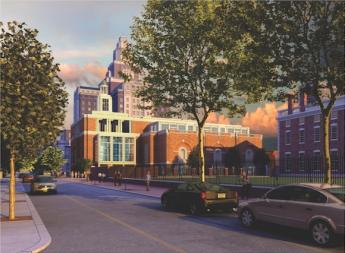
|
| Museum of the American Revolution |
The old visitors center was given a bell by Queen Elizabeth II, who brought it over on the royal yacht and gave a memorable speech at its installation. The deed to the property does not include the bell, and its future is presently uncertain. However, the building will be torn down and replaced by a much larger structure, intended to house many rooms and a tour lasting hours, to show off Washington's military tent and similar artifacts of the low point of the Revolution, when it rested with the personal character of a few founding fathers, to preserve the drive and idealism of the freezing, starving troops. It's a tall challenge for Mike Quinn to carry it off with the right mixture of showmanship and concern for accuracy. After all, no good story is improved by exaggeration.
| Posted by: Pat | Oct 30, 2012 2:53 PM |
| Posted by: serivce | May 11, 2012 5:06 PM |
| Posted by: social | May 8, 2012 11:39 AM |
| Posted by: Charles Ellis | Mar 19, 2010 4:40 PM |
68 Blogs
Short Tour of Philadelphia's West Country
 Philadelpia County had two hundred farms in 1950, but is now thickly settled in all directions. Western regions along the Schuylkill are still spread out somewhat; with many historic estates.
Philadelpia County had two hundred farms in 1950, but is now thickly settled in all directions. Western regions along the Schuylkill are still spread out somewhat; with many historic estates.
Albert C. Barnes, M.D.
 Impressionist paintings grew more valuable, faster than the patron's endowment for their maintenance.
Impressionist paintings grew more valuable, faster than the patron's endowment for their maintenance.
Benjamin Franklin Parkway (2)
 Parthenon-like Art Museum at the other.
Parthenon-like Art Museum at the other.
Bertrand Russell Disturbs the Barnes Foundation Neighbors
 How one of Britain's most notorious philosophers wandered into the city of brotherly love and vaulted out of destitution to wealth.
How one of Britain's most notorious philosophers wandered into the city of brotherly love and vaulted out of destitution to wealth.
Contemporary Germantown
 "Well," said Bockus, "Every famous surgeon I know, has a house on an island, somewhere. Where's your island?".
"Well," said Bockus, "Every famous surgeon I know, has a house on an island, somewhere. Where's your island?".
Donor Intent
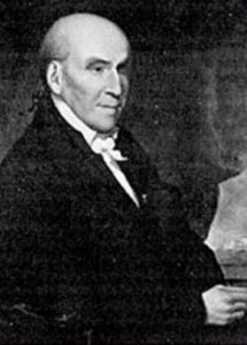 Measure a civilization by how it acts when a donor has died but his possessions endure. Especially when his firmly declared wishes conflict with their own.
Measure a civilization by how it acts when a donor has died but his possessions endure. Especially when his firmly declared wishes conflict with their own.
East Falls
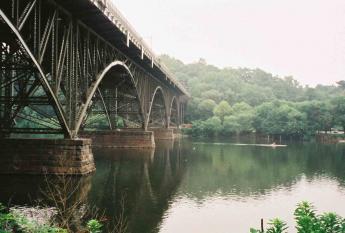 A cute little suburban remnant nestles close to the center of town, protected by the Schuylkill, the Wissahickon, and the shade of John B. Kelly. Perhaps Harry Robinhold deserves some credit, too.
A cute little suburban remnant nestles close to the center of town, protected by the Schuylkill, the Wissahickon, and the shade of John B. Kelly. Perhaps Harry Robinhold deserves some credit, too.
East Park Jingle
 The east side of Fairmount Park is where the grand folks, both Tories and Rebels, had their mansions during the Revolution, and many mansions are still there to be visited.
The east side of Fairmount Park is where the grand folks, both Tories and Rebels, had their mansions during the Revolution, and many mansions are still there to be visited.
Encampment At East Falls
 To follow the story chronologically, however, we must first follow Washington to Moland House in Bucks County, after the first East Falls encampment.
To follow the story chronologically, however, we must first follow Washington to Moland House in Bucks County, after the first East Falls encampment.
Fairmount Park Historic Preservation Trust
 First you must learn how colonial buildings were made, then you have to learn how to do it yourself. And after that, this imaginative preservation society has branched out to help other regions restore colonial buildings.
First you must learn how colonial buildings were made, then you have to learn how to do it yourself. And after that, this imaginative preservation society has branched out to help other regions restore colonial buildings.
Germantown After 1730
 Germantown became the spiritual and intellectual capital of German America as immigrant farmers passed through on the way to better farmland. When Benjamin Chew built his mansion there, it became an affluent suburb as well.
Germantown became the spiritual and intellectual capital of German America as immigrant farmers passed through on the way to better farmland. When Benjamin Chew built his mansion there, it became an affluent suburb as well.
Germantown and the French and Indian War
 In 1750, the frontier was not very far from Germantown, and the pacifist Germans were as conflicted as English Quakers about Scotch-Irish behavior, Indian warfare techniques, and Benjamin Franklin
In 1750, the frontier was not very far from Germantown, and the pacifist Germans were as conflicted as English Quakers about Scotch-Irish behavior, Indian warfare techniques, and Benjamin Franklin
Germantown Before 1730
 The early German settlers of Germantown were religious intellectuals, with a Swiss background and a history of religious martyrdom.
The early German settlers of Germantown were religious intellectuals, with a Swiss background and a history of religious martyrdom.
Harriton House
 The original house in the old Welsh barony gave its name to Bryn Mawr, and once was the home of the secretary of the Continental Congress.
The original house in the old Welsh barony gave its name to Bryn Mawr, and once was the home of the secretary of the Continental Congress.
Kenneth Gordon, MD, Hero of Valley Forge
 This soft-spoken child psychiatrist was mainly responsible for keeping real estate developers from building houses all over the Valley Forge encampment.
This soft-spoken child psychiatrist was mainly responsible for keeping real estate developers from building houses all over the Valley Forge encampment.
La Fayette, We Are Here
 LaFayette's first experience in charge of troops very nearly ended in his capture.
LaFayette's first experience in charge of troops very nearly ended in his capture.
Lansdowne
 John Penn, the last of the Penn Proprietors, lived in a mansion near what is now Horticultural Hall in Fairmount Park.
John Penn, the last of the Penn Proprietors, lived in a mansion near what is now Horticultural Hall in Fairmount Park.
Potts
 Once you get north of the falls of the Schuylkill in Fairmount Park, there aren't many places to ford the river until you get to Norristown, and then Pottstown. That brought commerce to the towns and a lot of military activity during the Revolution.
Once you get north of the falls of the Schuylkill in Fairmount Park, there aren't many places to ford the river until you get to Norristown, and then Pottstown. That brought commerce to the towns and a lot of military activity during the Revolution.
Radioactive River Bend
 The river geography around Pottstown created a lot of history.
The river geography around Pottstown created a lot of history.
Rubberneck Tours of Philadelphia (1)
 A very enjoyable two-hour drive, up to one side of the Schuylkill and down the other, encircles dozens of points of interest. Even if you don't know and don't care that this area was once the training ground for most of the Union Army.
A very enjoyable two-hour drive, up to one side of the Schuylkill and down the other, encircles dozens of points of interest. Even if you don't know and don't care that this area was once the training ground for most of the Union Army.
Sugarloaf
 The Strouds of Stroudsburg used to live here at the top of the town. It's now a conference center.
The Strouds of Stroudsburg used to live here at the top of the town. It's now a conference center.
West Fairmount Park
 Fairmount Park, west of the river, is the largest part. The 1876 Centennial was held there.
Fairmount Park, west of the river, is the largest part. The 1876 Centennial was held there.
Fair Mount
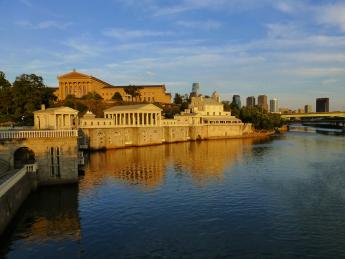 Philadelphia's acropolis is Faire Mount, where the Art Museum marks the entrance to Fairmount Park. Stretching beyond is Boathouse Row and its rowing races. When the azaleas are in bloom, it's the match of any place in the world.
Philadelphia's acropolis is Faire Mount, where the Art Museum marks the entrance to Fairmount Park. Stretching beyond is Boathouse Row and its rowing races. When the azaleas are in bloom, it's the match of any place in the world.
The Schools of School House Lane
 Exclusive privates schools and colleges are usually to be found in isolated rural settings. But our oldest, best, and most famous schools are clustered together in a neighborhood that is far from exclusive.
Exclusive privates schools and colleges are usually to be found in isolated rural settings. But our oldest, best, and most famous schools are clustered together in a neighborhood that is far from exclusive.
The Quaker Who Would Be King
Two Americans, Josiah Harlan, and George Bush conquered Afghanistan, and for centuries others who tried it got massacred. Harlan, a Chester County Quaker farm boy with more brazenness than Alexander the Great, died in San Francisco while impersonating a physician.
The Battle of Germantown: Oct. 3, 1777

Battle of the Clouds: September, Remember
 Benjamin Franklin, it should be noted, was the first to observe that Atlantic Coast "Nor'easters" actually begin in the South and work North, even though the wind seems to be blowing the other way.
Benjamin Franklin, it should be noted, was the first to observe that Atlantic Coast "Nor'easters" actually begin in the South and work North, even though the wind seems to be blowing the other way.
The Center of Town
 The designs of the city squares, that of City Hall, in particular, follow the "diamond" pattern characteristic of the Scotch Irish, who were keen real estate speculators.
The designs of the city squares, that of City Hall, in particular, follow the "diamond" pattern characteristic of the Scotch Irish, who were keen real estate speculators.
Charles Dickens Doesn't Like Our Nice Penitentiary
As an author, Dickens was paid by the word. He did go on a bit about Eastern Penitentiary, with its novel Quaker method for rehabilitating prisoners.
City Troop
 America.
America.
Washington Lurks in Bucks County, Waiting for Howe to Make a Move
 Washington, LaFayette, and twenty-seven other famous heroes of the Revolution spent a week in this Bucks County farmhouse, waiting for the British to make a move. Washington had a bottle of Madeira every day for lunch, but Mrs. Moland made him sleep on the floor, and pay for cleaning up when they left.
Washington, LaFayette, and twenty-seven other famous heroes of the Revolution spent a week in this Bucks County farmhouse, waiting for the British to make a move. Washington had a bottle of Madeira every day for lunch, but Mrs. Moland made him sleep on the floor, and pay for cleaning up when they left.
Doylestown
 Doylestown is trapped between the steadily advancing edges of New York and Philadelphia, and must soon submerge. For now, the town's a lovely little jewel.
Doylestown is trapped between the steadily advancing edges of New York and Philadelphia, and must soon submerge. For now, the town's a lovely little jewel.
Early Germantown-Music
 The Quakers disapproved of music, particularly church music, and so the Germans in Germantown founded American musical traditions, mostly on Bach. That tradition continues in the Moravian communities along the Lehigh River, and it has a heavy influence on the Philadelphia Orchestra.
The Quakers disapproved of music, particularly church music, and so the Germans in Germantown founded American musical traditions, mostly on Bach. That tradition continues in the Moravian communities along the Lehigh River, and it has a heavy influence on the Philadelphia Orchestra.
Friends of Boyd
 The last movie palace in Philadelphia is either ready for restoration, or the wrecking ball.
The last movie palace in Philadelphia is either ready for restoration, or the wrecking ball.
Home of the U.S. Naval Academy
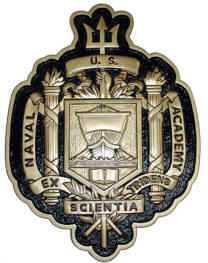 The Naval Acadamy now in Annapolis originally was on Gray's Ferry Avenue. It's still a handsome building, in some danger of destruction by real estate developers.
The Naval Acadamy now in Annapolis originally was on Gray's Ferry Avenue. It's still a handsome building, in some danger of destruction by real estate developers.
Laurel Hill
 Public attitudes about cemeteries continue to evolve.
Public attitudes about cemeteries continue to evolve.
Lindbergh Boulevard
 There's a street in Southwest Philadelphia in honor of a visit by Charles Lindbergh. It runs approximately from Bartram's Garden to the Airport.
There's a street in Southwest Philadelphia in honor of a visit by Charles Lindbergh. It runs approximately from Bartram's Garden to the Airport.
Main Line School Night
 There are a lot of continuing education courses, but few are as successful as Main Line School Night, with 14,000 students, hardly any of whom need education.
There are a lot of continuing education courses, but few are as successful as Main Line School Night, with 14,000 students, hardly any of whom need education.
Military School
 Valley Forge Military Academy takes rambunctious boys and makes them into leaders. Even some of the misfits and dropouts seem to benefit from the difficult experience.
Valley Forge Military Academy takes rambunctious boys and makes them into leaders. Even some of the misfits and dropouts seem to benefit from the difficult experience.
Religion at Girard College:Spiritual But Irreligious
 In his will, Stephen Girard famously banished all clergymen from the grounds of his school for orphans, even as visitors. Nevertheless, the school's atmosphere is a highly ethical, even religious, one. Many graduates have become ministers.
In his will, Stephen Girard famously banished all clergymen from the grounds of his school for orphans, even as visitors. Nevertheless, the school's atmosphere is a highly ethical, even religious, one. Many graduates have become ministers.
Skating and Humane
 America's premier indoor skating club had its origin as a life-saving association.
America's premier indoor skating club had its origin as a life-saving association.
To Germantown: A Short Appreciation
The Western World was long defined as a province of Rome
Zane Grey, Dentist
 Owen Wister may have invented the theme of the noble cowboy, but Zane Grey made it famous.
Owen Wister may have invented the theme of the noble cowboy, but Zane Grey made it famous.
Victorian Broad Street
 Some massive beautiful Victorian buildings still dominate the City crossroads on Broad Street near City Hall.
Some massive beautiful Victorian buildings still dominate the City crossroads on Broad Street near City Hall.
The Houses in the Park
 William Penn intended his city to stretch from river to river, with the gentry living in mansions along the Schuylkill. Briefly, it was so; the mansions are on display in Fairmount Park.
William Penn intended his city to stretch from river to river, with the gentry living in mansions along the Schuylkill. Briefly, it was so; the mansions are on display in Fairmount Park.
Swarthmore College

Stephen Girard 1750-1831
 Stephen Girard was blind in one eye and never went to school. But he was a successful sea captain, then a successful merchant, then a successful banker. In the last year of his life, he grasped the essence of the Industrial Revolution, made a successful plan for the next century, and wrote a truly remarkable will.
Stephen Girard was blind in one eye and never went to school. But he was a successful sea captain, then a successful merchant, then a successful banker. In the last year of his life, he grasped the essence of the Industrial Revolution, made a successful plan for the next century, and wrote a truly remarkable will.
Mrs. Meade's House
 The grateful city fathers wanted to give General Meade a mansion out of gratitude for winning at Gettysburg. The General refused, but he hadn't asked his wife.
The grateful city fathers wanted to give General Meade a mansion out of gratitude for winning at Gettysburg. The General refused, but he hadn't asked his wife.
Old Blockley (P.G.H.)
 Every Victorian American city had a big medical almshouse, but Philadelphia had the best. The 1965 Amendments to the Social Security Act (Medicare and Medicaid) destroyed P.G. H. at the behest of local hospitals. They now regret it.
Every Victorian American city had a big medical almshouse, but Philadelphia had the best. The 1965 Amendments to the Social Security Act (Medicare and Medicaid) destroyed P.G. H. at the behest of local hospitals. They now regret it.
Paul Robeson 1898-1976
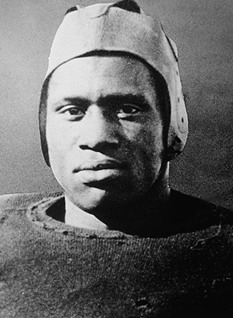 Valedictorian, All-American footballer, law degree, outstanding baritone, actor, film star, political activist -- Robeson rose to the top in the 1930s when by default he was always a pioneer. As a student, for example, he was the only black person on campus at Rutgers. His understandable resentments and show-biz surroundings propelled him into leftist activism. Mental infirmity and McCarthyism then brought him down.
Valedictorian, All-American footballer, law degree, outstanding baritone, actor, film star, political activist -- Robeson rose to the top in the 1930s when by default he was always a pioneer. As a student, for example, he was the only black person on campus at Rutgers. His understandable resentments and show-biz surroundings propelled him into leftist activism. Mental infirmity and McCarthyism then brought him down.
Philadelphia in 1976: Legionaire's Disease
 Philadelphia's ambitious Bicentennial celebration of the Declaration of Independence was ruined by an epidemic of a new disease that seemed to focus on tourists.
Philadelphia's ambitious Bicentennial celebration of the Declaration of Independence was ruined by an epidemic of a new disease that seemed to focus on tourists.
Rittenhouse Square Area
 This was the heart of uppercrust society during the Gilded Age.
This was the heart of uppercrust society during the Gilded Age.
William Allen, Tory
 History is written by the victors, so the rich Tory William Allen is largely forgotten. But he was Chief Justice, probably the richest man in the colony, the son in law of Andrew Hamilton and the father in law of John Penn, the Proprietor, and Governor.
History is written by the victors, so the rich Tory William Allen is largely forgotten. But he was Chief Justice, probably the richest man in the colony, the son in law of Andrew Hamilton and the father in law of John Penn, the Proprietor, and Governor.
The Swedenborgian Church
 The Swedenborgians belong to the Church of the New Jerusalem, following the teachings of Emanuel Swedenborg, and strongly emphasizing personal responsibility, individuality, and good works. The Philadelphia branch is particularly strong, centered around a magnificent medieval cathedral in Bryn Athyn. Johnny Appleseed and Helen Keller were notable adherents, and a driving force has been the Pitcairn family of industrialists.
The Swedenborgians belong to the Church of the New Jerusalem, following the teachings of Emanuel Swedenborg, and strongly emphasizing personal responsibility, individuality, and good works. The Philadelphia branch is particularly strong, centered around a magnificent medieval cathedral in Bryn Athyn. Johnny Appleseed and Helen Keller were notable adherents, and a driving force has been the Pitcairn family of industrialists.
The Girl in the Red Velvet Swing
 The original Gibson girl's husband was rich, her boyfriend was famous. But blowing somebody's brains out in public is supposed to be a felony.
The original Gibson girl's husband was rich, her boyfriend was famous. But blowing somebody's brains out in public is supposed to be a felony.
Fernery
 Around 1840, there was a brief worldwide craze for ferns, related to the exciting discovery of their complicated reproductive process. Only one Victorian fernery still exists in North America, at the Morris Arboretum in Philadelphia.
Around 1840, there was a brief worldwide craze for ferns, related to the exciting discovery of their complicated reproductive process. Only one Victorian fernery still exists in North America, at the Morris Arboretum in Philadelphia.
Morris Arboretum
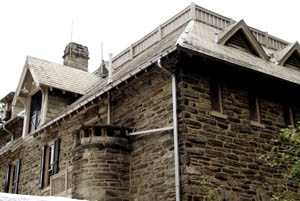 At the furthermost corner of Fairmount Park, the former estate of John and Lydia Morris is run as a public arboretum, one of the two or three finest in North America.
At the furthermost corner of Fairmount Park, the former estate of John and Lydia Morris is run as a public arboretum, one of the two or three finest in North America.
Please Touch
 The Please Touch Museum, a roaring success story, is planning to move too much larger quarters in the Fall of 2008.
The Please Touch Museum, a roaring success story, is planning to move too much larger quarters in the Fall of 2008.
Hidden River
In season, and for benefits, cruises of the Schuylkill are starting to be available at the Walnut Street dock. Go down the stairs at 24th Street.
Chester County, Pennsylvania
 When you say Chester County, you are probably talking about horses. There's much more to say.
When you say Chester County, you are probably talking about horses. There's much more to say.
Labyrinth, Episcopalian Version
 There's thirty-foot labyrinth in the Holy Trinity Church on Rittenhouse Square. The tradition of meditation walks reached a peak in the 12th and 13th Centuries, but examples can be found dating back to 4500 B.C.
There's thirty-foot labyrinth in the Holy Trinity Church on Rittenhouse Square. The tradition of meditation walks reached a peak in the 12th and 13th Centuries, but examples can be found dating back to 4500 B.C.
Reviving Schuylkill: Eight Miles From the Dam to Ft. Mifflin
 Cleaning up eight miles of banks of the Schuylkill from Fairmount Dam to Fort Mifflin, is Philadelphia's share of the Obama Stimulus Package. It will take a decade to know whether it was worth it, but as the program begins, it stirs a lot of excitement.
Cleaning up eight miles of banks of the Schuylkill from Fairmount Dam to Fort Mifflin, is Philadelphia's share of the Obama Stimulus Package. It will take a decade to know whether it was worth it, but as the program begins, it stirs a lot of excitement.
Tyler Arboretum
 A 650-acre Arboretum next to a 2500-acre state park makes for a lot of nature walks and bird watching, as well as a gazillion azaleas and tree specimens. The only serpentine barren in Delaware County is located there.
A 650-acre Arboretum next to a 2500-acre state park makes for a lot of nature walks and bird watching, as well as a gazillion azaleas and tree specimens. The only serpentine barren in Delaware County is located there.
Heavenly House
 In or around Philadelphia, money no object, what's the best place to build a super-mansion?
In or around Philadelphia, money no object, what's the best place to build a super-mansion?
Washington's Circular Letters
 During the dismal days of 1782-3, Washington was confronted with the first of many examples of the American tendency to quit a war before it is completely won.
During the dismal days of 1782-3, Washington was confronted with the first of many examples of the American tendency to quit a war before it is completely won.
Bones in Duffy's Cut
 They are digging up bones in Malvern, finding evidence of murder. Some people are uneasy about perpetuating ethnic strife.
They are digging up bones in Malvern, finding evidence of murder. Some people are uneasy about perpetuating ethnic strife.
Conowingo
 After ancient disputes between William Penn and Lord Baltimore, the mouth of the Susquehanna into the Chesapeake Bay is located in Maryland. However, the Philadelphia Electric Company got its power from the Conowingo Dam, and Philadelphia bird watchers by the hundreds go there to watch thousands of birds, attracted by millions of fish. But when the buzzers sound and the red lights flash, run for higher ground.
After ancient disputes between William Penn and Lord Baltimore, the mouth of the Susquehanna into the Chesapeake Bay is located in Maryland. However, the Philadelphia Electric Company got its power from the Conowingo Dam, and Philadelphia bird watchers by the hundreds go there to watch thousands of birds, attracted by millions of fish. But when the buzzers sound and the red lights flash, run for higher ground.
Museum of the American Revolution
 The old Visitors Center at Third and Chestnut has been vacant for more than a decade. Its new occupant is going to be a Museum dedicated to the causes and sacrifices of the American Revolution.
The old Visitors Center at Third and Chestnut has been vacant for more than a decade. Its new occupant is going to be a Museum dedicated to the causes and sacrifices of the American Revolution.